MECE Framework McKinsey
“MECE,” pronounced “me see,” an acronym for “mutually exclusive and collectively exhaustive,” is a popular mantra at McKinsey. If you manage to get a position at McKinsey, or at any other MBB for that matter, you are likely to have to handle huge amounts of data. Chances are that your boss will ask you to ensure that you organize your data in an “MECE manner.” “Be more ‘MECE’ in your approach,” she might say. In fact, even at your case interview, you likely used the MECE principle. You might not have got the green signal if you hadn’t.

Introduction and definition
MECE is a method of grouping information into elements that are mutually exclusive (ME) and collectively exhaustive (CE). In other words, it is a process by which information—ideas, topics, issues, solutions—is arranged or, put in “MECE buckets,” with no overlapping between buckets and with each item having a place in one bucket only (ME), and with the buckets including all possible items relevant to the context.
A simple example of the MECE principle would be the classification of the population into age groups. Here, dividing the population into two groups, one group of people above, say, 60, and another group below 60, would be based on the MECE principle. The entire population would be either above or below 60 (ME, with no overlapping between the two buckets) and with all people included in one or the other bucket (CE).
However, a categorization of the population into one group of, say, people below 60 and another of people between 50 and 70 would not be based on MECE. People between 50 and 60 would be in both “buckets” (not ME) and some people would not be in either bucket (so not CE).
How is it used?
Strategy consultants use the MECE framework (Issue Tree, Decision Tree, Hypothesis Tree) to segregate a client’s problems into logical data categories that can be analyzed systematically and minutely by their staff involved with the project. The framework is notably used at McKinsey, where data from clients’ businesses is organized on the basis of MECE. Well-known frameworks, such as Cost-Benefit Analysis, 4Cs, and Porter’s Five Forces have the MECE principle at their core.
Let’s discuss three popular MECE frameworks.
How is the MECE framework used to solve clients’ issues at consultancies? One method consultants use is to create an “issue tree” to arrange all the information that they have and divide this information into all possible issues and sub-issues.
An issue tree is particularly helpful for solving large and complex problems as it facilitates splitting them up into smaller, solvable problems. “Issue trees” get their names from their structure—narrow at the top with the problem statement, and wider towards the bottom, even as each level accommodates more specific sub-issues or smaller problems. However, some “trees” are also created left to right, but the principle remains the same.
A common type of cases in which a MECE issue tree is used is profitability cases. Suppose the problem statement is “My restaurant is not profitable.” An issue tree is created, starting with the problem statement at the treetop.
The various sub-levels of the tree would answer the question “How to make the restaurant profitable?” in broad, intuitive ways: “Increase revenue” and “Reduce costs.” The lower levels would also answer the question “How?”
The second level, with sub-issues of the first level, would answer the questions “How to increase revenue?” (under “Increase revenue”) on the one hand and “How to reduce costs?” on the other. The answers under “Increase revenue” would be “Increase the number of orders” and “Increase the prices of items.” The answers under “Reduce costs” would be “Reduce salary expenditure,” “Reduce rental,” and “Reduce raw material expenses.”
On the third level, the issue tree would tackle the question “How to Increase the number of orders?” One way to increase orders would be to shift the restaurant to a busier area and another would be to launch a marketing campaign so that the restaurant becomes more widely known. On the other main branch, under “reduce salary expenditure,” options such as “fire redundant workers” could be mentioned, as also “shift to a less expensive locality” under “reduce rental”, and “change the vendors,” under “reduce raw material expenses.”
How does an issue tree help? It enables consultants to consider all options separately and exclusively and suggest the best option to the client. It helps create a common understanding among team members about the problem-solving framework and focus team efforts. It smoothens work distribution among team members.
Often, consultants who create an issue tree may need to “trim branches,” which means doing away with options that are not worth pursuing after a detailed initial consideration. In the example of the issue tree, given above, about how to increase the profitability of a restaurant, increasing prices may not be an option for various reasons, and that “branch” of the issue tree may be left out or “trimmed.”

Decision tree
A decision tree is a tree-shaped graphical representation of decisions and potential outcomes of those decisions, and is used to determine a course of action. A decision tree helps users understand the comparative advantages and disadvantages of each decision and outcome.
A decision tree is often drawn from left to right. It starts with a specific decision denoted by a small square. “Branches,” or lines, are drawn to the right from the square, representing each potential option. If the option is a new decision, a square is drawn, and from it, new branches are drawn, representing new options. At the end of each branch, a circle is drawn if the result of the option is unclear. If the option leads to a decision that helps bring about a solution, the branch is left blank. A triangle is also used to signify the end of a branch or path to a potential solution.
Like an issue tree, a decision tree is exhaustive in its inclusion of decision, outcomes, options, and scenarios. A user of a decision tree looks at each of them and chooses the best option.

Hypothesis tree
Another method to structure a problem is to develop a hypothesis tree, which is the graphical representation of all MECE hypothesis that elucidates the problem. It is, in a way, similar to an issue tree, where a problem is broken down into its components, which makes identifying and solving it easier. But while an issue tree splits up each problem into issues and sub-issues, a hypothesis tree organizes a problem around hypotheses, and often offers a more direct approach than an issue tree.

Developing MECE hypotheses
First, understand the problem thoroughly. What are you trying to solve?
Second, write down the problem statement. Take care to ensure clarity in the statement so that there is no ambiguity.
Third, list the options to solve the problem, using a MECE tree. See that the options do not overlap (that they are mutually exclusive) and that no option has been left out (that they are collectively exhaustive).
Fourth, consider each option individually. Consider the pros and cons. Leave out those that are illogical and include any new insight as an option as you understand the problem better.
Fifth, select the best option and present it to the client.
Clarity pays
Good management consultants use the MECE structure for problem-solving. A piece of advice they like to give to aspiring consultants is to learn to use the MECE principle for not only structuring problems but also communicating solutions, whether they are attending a case interview at MBB or sitting across the desk from a client.
Creating a MECE hypothesis helps clarifies a problem. It’s like having a road map when you are lost in unknown territory. If your approach to structuring a problem is “not MECE,” “it is probably messy,” as they say. In order to truly understand MECE, you’ll first need a solid foundation of business. Which is what we teach in our popular online course. It covers other important strategy concepts (including powerful problem solving frameworks), as well as the wider range of super-essential business topics. Check it out here Mini MBA
Resources: 1, 2, 3, 4, 5, 6, 7, 8, 9, 10, 11, 12, 13, 14
- Skip to main content
Crafting Cases
The Definitive Guide to Issue Trees
Introduction, issue trees: the secret to think like a mckinsey consultant and always have a clear, easy way to solve any problem.
Ask any McKinsey consultant what’s the #1 thing you should learn in order to solve problems like they do and you’re gonna get the same answer over and over again:
“You’ve gotta learn to create Issue Trees.”
Issue Trees (also known as “Logic Trees” and “Hypothesis Trees”) are THE most fundamental tool to structure and solve problems in a systematic way.
Mastering them is a requirement if you want to get a job in a top consulting firm, such as McKinsey, Bain and BCG.
But even if you’re not applying for a job at these firms, they’re a powerful tool for any job that requires you to solve problems .
In fact, Issue Trees are the main tool top management consultants use to solve the toughest multi-billion dollar problems their clients have.
This guide will teach you how to create and use Issue Trees.
I will give a focus on case interviews but you can use this skill in any other problem solving activity. I personally use it everyday at work.
(Which means what you’ll learn here is gonna be useful for far more than merely getting a job.)
About the author

I’m Bruno Nogueira.
I’m an ex-McKinsey consultant and I have learned to think using issue trees the hard way.
There were no good resources to learn this back when I was applying for the job.
Even within McKinsey there was no formal training. People just expected you to “get it” on the job.
After leaving the Firm, I’ve spent a few years coaching people to get a job in consulting, and I learned to teach this skill the only way possible: by actually teaching it!
Along with my partner Julio, I have taught 1000’s of people to break down problems in a structured way using issue trees.
And today I’m gonna teach you how to do this.
In this guide you'll learn:

Issue Tree Fundamentals

Three Techniques To Build Issue Trees
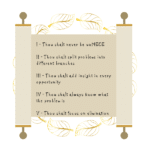
Six Principles For AMAZING Issue Trees

Issue Tree Examples

Common Mistakes and Questions

How To Practice Issue Trees

BONUS CHAPTER
Applying Issue Trees On The Job
Issue trees are the blueprint of how McKinsey (and other) consultants think.
They make your thinking process more rigorous and much, much more clear.
Unfortunately they didn’t teach you this well enough (if at all) in school.
They don’t even teach this in most Business Schools.
But if you learn to harness their power, you’re set to case interview success (and a career where every problem can be easily solved).

How I learned about Issue Trees
A bit of a personal story first…
I first learned about Issue Trees from a friend who was working in management consulting. It was back when I was applying for a job at McKinsey, Bain and BCG.
This friend told me Issue Trees were the #1 thing I had to learn in order to do well on the interview and land a top consulting job.
And so, the first thing I did was to look for examples of Issue Trees.
And I found stuff like this…
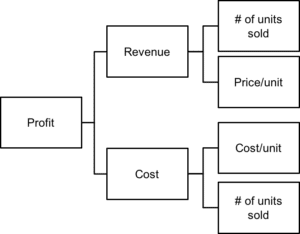
Not exactly rocket science, right?
But then I thought… “Alright, what if my problem is not a profit problem? Or what if I need to dig a little deeper than that?”
It didn’t take me long to find people on the internet telling me that you could use Issue Trees to solve any problem!
Here’s how they illustrated this important point:
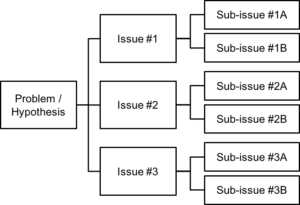
Let’s be honest with ourselves here… This is NOT the best way to teach something!
And so I kept looking around.
I wanted to see realistic examples of real Issue Trees consultants use to solve their client’s problems.
And if I was lucky, I hoped to find some explanation on why each example was structured the way it was.
Here’s the kind of stuff I found looking up on Google again:
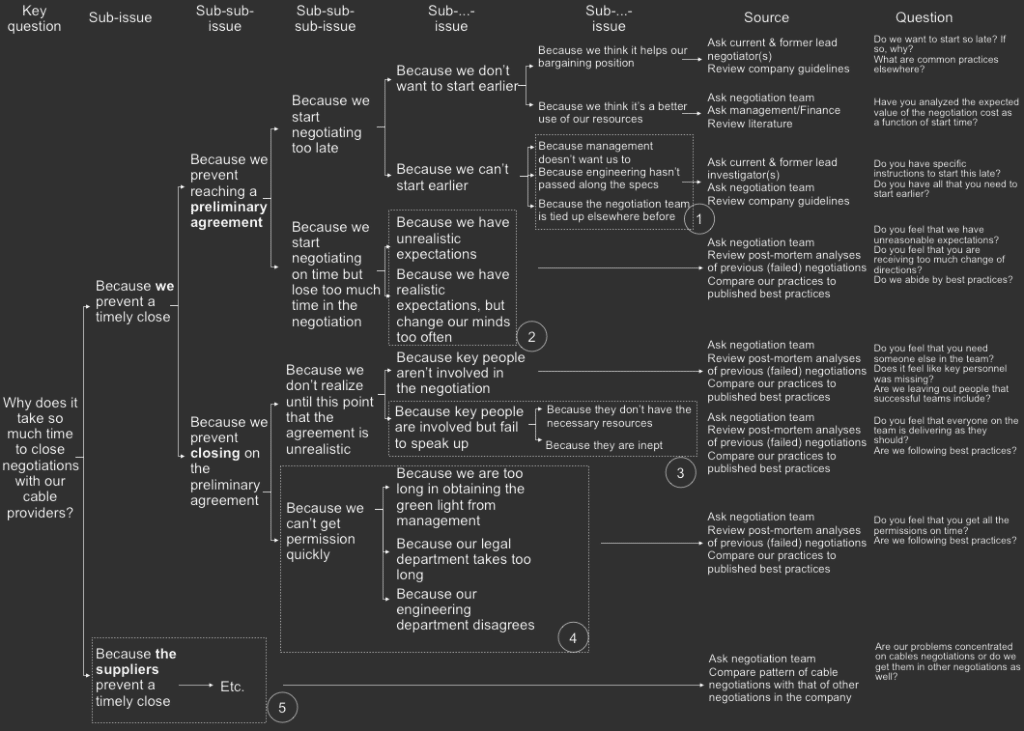
And now I was left wondering how to get from Point A (the simple profit Issue Tree from the beginning of this orange box) to Point B (the behemoth you see above).
And I also wondered if getting to this behemoth was actually the kind of thing I wanted in the first place. Would it help me in a real interview?
So I gave up on the internet and decided to learn Issue Trees from those who know it best: real consultants. That’s who I learned to build Issue Trees from.
But I know that most people don’t have access to real consultants with the time to teach them things.
And it never stopped bothering me the fact that the internet had no decent resource to teach people of a skill that I use multiple times a day (and even make a living out of).
This is why I wrote this guide.
The 4 things you need to "get" to understand Issue Trees
Before we jump into the nitty-gritty of how to create and use your Issue Trees, I want to give you a high-level view. This high-level view is what we’ll cover in this chapter.
I’m gonna show you four ways to look at Issue Trees so you can get an intuitive understanding of them.
And I’m gonna show you that through an example of a realistic Issue Tree.
They are a "map" of your problem
The first thing you need to know about Issue Trees is that they’re nothing more than a “map” of the problem.
Not just any map, but a clear and rigorous map.
We’re gonna achieve those two goals by using a principle called “MECE”. (Don’t worry about it now, we’re gonna get you covered later on).
So suppose you’re an executive in a Telecom Company in charge of B2C mobile services (that is, cell phone services for regular people like you and me).
Imagine you have a client retention problem. That means too many clients are unsubscribing for your services/plans.
How would you figure out what’s causing this problem?
Well, a smart executive would build a “map” of all the possible things that might be going on. This map is your Issue Tree and “the things that might be going on” are your hypotheses.
I’ll show you one of these, but before I do that, I will ask you to do one 15-second task:
**Action step: grab a piece of paper and make a list of all the hypotheses that pop-up into your head of why customers might be unsubscribing for this Telco’s mobile services.**
Now, take a look at this Issue Tree.
If I did my job right, every hypothesis you had fits one of the “buckets” in this tree.
How do I know that?
Well, I used the MECE principle I mentioned above to build this tree. This means every “part” of the problem is here and that each “part” is different/independent from each other.
We’re gonna get back to this later.
The second thing to notice is that there are probably whole categories of problems you didn’t even think of when you wrote out your list of hypotheses.
You’ve probably thought about customers hiring a competitor service because they hate us for a variety of reasons (unreliable service, poor customer service) and you’ve probably thought about them leaving us because they were lured by competition somehow (low prices, free phones).
And if you’re savvy on the telecom industry, you might have even though about customers moving to pre-paid services.
But if my intuition is good, you have probably forgotten about at least a couple of categories within the “They’re being forced out” branch.
For example, you might’ve forgotten to think that they may be cancelling subscriptions on purpose because they’re leaving a market.
Simple – I’ve done thousands of cases with hundreds of candidates to consulting jobs and most people forget about those.
The third thing to notice is that I didn’t even mention any specific hypotheses that you might have written on your piece of paper, things such as:
- We’ve increased our prices and our competitors have dropped theirs
- There were failures in our billing provider and a bunch of people were overcharged and got mad at us
- Our network was down for several days due to a problem within our IT systems, leaving people offline
- A problem in the banking system caused us not to receive several payments, which triggered subscriptions to be cancelled automatically
But still, all of these hypotheses (and thousands of others) would fit into one of the eight categories at the right-end of the Issue Tree.
All of this is to say that an Issue Tree is a map of the problem you have to solve.
Just like a good map it covers the whole problem area (you wouldn’t want a map of just a part of the territory you’re exploring).
And just like a good map, it doesn’t go into the slightest details (the specific hypotheses), but focuses on the broad aspects of your problem (the categories).
No adventurer should explore a territory without a good map.
And no smart problem solver should start solving a problem without a good Issue Tree.
Issue Trees are the tool for "dividing and conquering"
Issue Trees are more than a mere map. They’re a very useful one at that.
For those of you who are not warfare strategy geeks like me, “divide and conquer” is a military strategy based on attacking not the whole of the enemy’s forces at once, but instead, separating them and dealing with a part of their forces one at a time.
It’s much easier to deal with one cockroach a hundred times than with a hundred cockroaches at once (sorry for the nasty imagery for all cockroachofobics out there).
Anyway, this strategy goes back into the times of Sun Tzu (the ancient Chinese philosopher who wrote “Art of War”).
And it so happens that this “divide and conquer” strategy is not only good for dealing with military opponents, but also GREAT for dealing with Big, Hairy, Complex problems.
It’s very difficult to deal with a “customer retention problem” like our Telco Executive is facing right now without making this problem more specific first.
But if you try making it more specific without the help of an Issue Tree (or a “problem map”), you’re gonna end up with one of two things:
(1) An incomplete list of possible hypotheses (like the one you probably wrote down on your piece of paper)
(2) A HUGE list with hundreds, even thousands of hypotheses (which, at the end of the day, you don’t even know if it’s complete anyway)
Issue Trees allow you to divide the problem and work on it one part at a time.
Or, if you’re a Telco Executive like our friend from point #1, you can delegate this work to other people now that the problem is neatly divided.
Here’s an example of how you can divide the problem into tasks and delegate its parts:
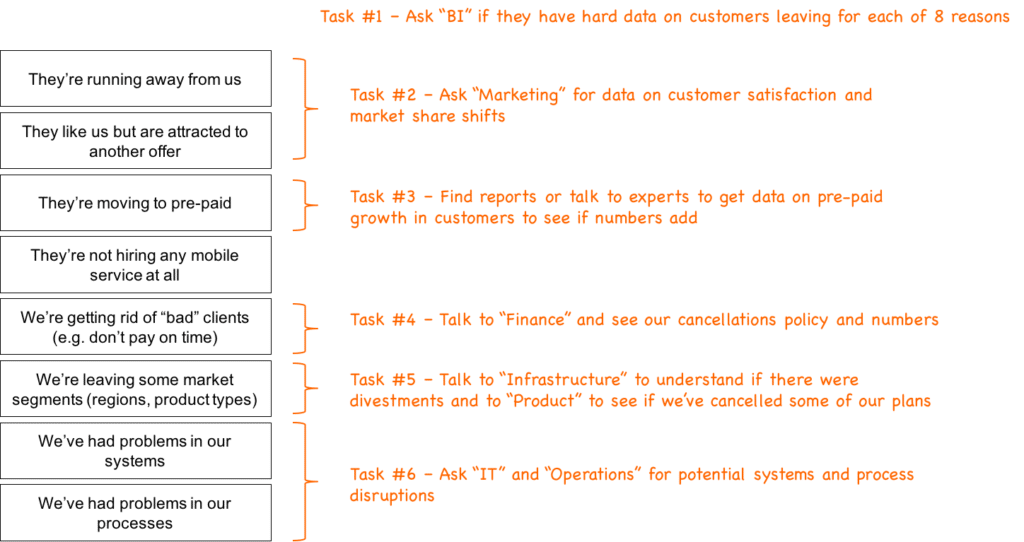
On the left side are the 8 buckets at the end of our Issue Tree. These are the eight potential problem areas.
And in orange are the six tasks our executive must do to know what’s causing the problem.
Many of them are actually just requests to other people within the company because when you use “divide and conquer” you get to give work to other people (which by the way, it’s a great way to grow your career quickly).
Depending on what they find Task #1, you may be able to stop there. Or you may need to do all 6 tasks and then some more as you find new, unexpected information.
Now, I know that this Telco Executive doesn’t seem like a really good professional when I put the Issue Tree and the tasks that way. He doesn’t even know the basics about what’s going on in his company!
But let’s pretend for a second that he was just hired and he’s not at fault for not knowing his company’s basic numbers.
Or that he’s actually a management consultant instead of an executive, and that he was hired to give this company’s executives an unbiased perspective of why customers are leaving.
Now things make more sense!
But the point is that the Issue Tree allows you to create a plan to solve the problem, just like a map allows you to create a route to get from Point A to Point B.
Issue Trees are excellent for prioritization
Not only Issue Trees let you have a “map” of the problem and help you create a “route” on how to solve it, they also give you the ability to anticipate a lot of stuff that could happen along that route.
And anticipation = prioritization.
(Or 80/20, for those of you who love the buzzwords).
Because Issue Trees lay out the underlying structure of your problem, they help you with two things:
(1) Get data structured in a way that helps you quickly find out where the problem is
(2) Anticipate what happened with a moderate to high degree of confidence even before you get data.
Let’s tackle each of these individually.
(1) Issue trees help you get data structured in a way that’s helpful to prioritize the problem.
Suppose you’re the Telco Executive and you’ve built your Issue Tree.
Remember how his Task #1 was to ask the Business Intelligence unit of his company for hard data about what’s going on?
Let’s assume they came back with the data below – how would you prioritize the problem?
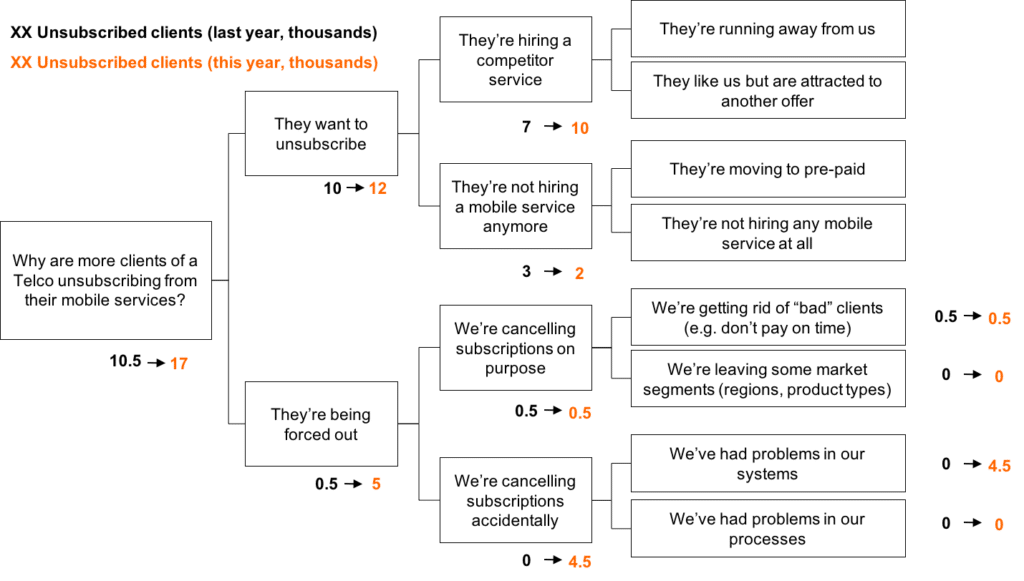
The way I see it:
Of the 6.5 thousand extra people who unsubscribed this year compared to last year, the vast majority came (4.5) from a system failure. This is not acceptable and this should be the area this executive should tackle first.
But there’s also another area that calls my attention: our biggest source of customer churn – them going to competitors – has increased from 7k per year to 10k per year.
This person (and the company) has two different problems, and getting data in a structured format via the Issue Tree makes this very clear.
(2) Issue Trees help you make a really good guess of what might be going on even before you get any data
Suppose this company’s Business Intelligence division is not that intelligent and has no data to provide.
In fact, suppose this company has such a problem with data gathering that they can’t get structured data for pretty much anything.
This would make this problem a nightmare to solve.
With no structured data, this exec (or his subordinates) would need to do a lot of legwork to test each category of hypotheses:
- To know if customers are hiring a competitor service, we’d need to call a large sample of them and ask
- To know if a problem in our processes caused customers’ subscriptions to be accidentally cancelled, we’d need to map out all our processes that could’ve caused that and evaluate each one individually
You get the idea!
But Issue Trees are a map of the problem. And as any good map, we can use it to see what parts of the terrain seem to be more important than others.
Here’s an example of how to do that even if you have no data:
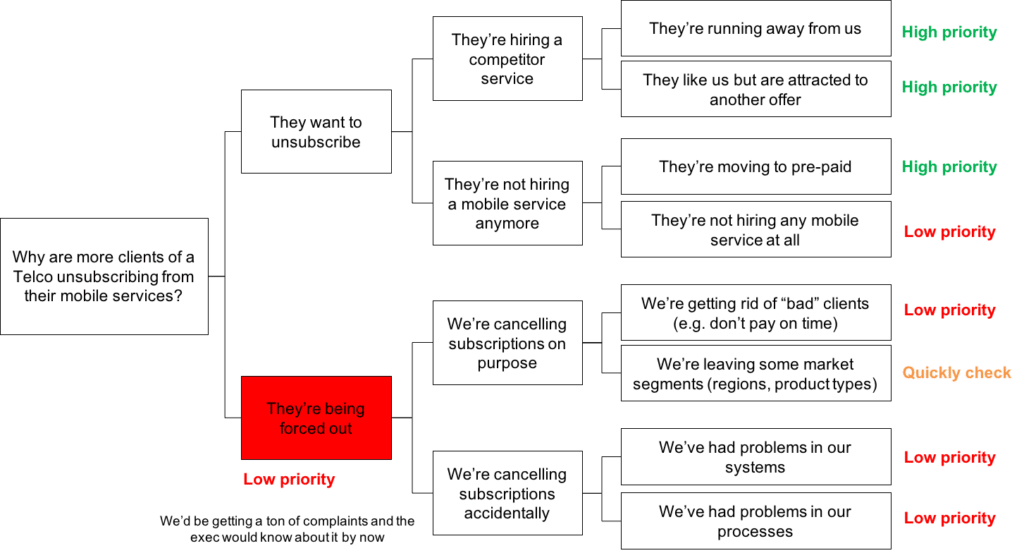
Obviously you need to use logical reasoning and a bunch of assumptions to prioritize one of these categories as more likely than others.
But in the absence of data that’s actually the best way to work!
So if I were this executive and there was no data, I’d try to work smart and start testing the most likely hypotheses.
This means I’d give more priority to the ones related to customers leaving us willingly.
It customers were being forced out we’d have crazy call centers full of customer complaints and the executive would probably know about it already. We’d probably have some lawsuits already!
I won’t go into the weeds of how to prioritize as we already cover that in our courses (including our free 7-day course on case interview fundamentals) but for now it’s cool to know that Issue Trees are the tool that enables you to prioritize effectively because it gives you a clear map of the problem.
You can have "problem trees" and "solution trees"
Last thing about Issue Trees that you must know to grasp what they are even before we can go into the specifics on how to build them is that you can have “Problem Trees” and “Solution Trees”.
Or, as I like to call them, “Why Trees” and “How Trees” .
“Why Trees”, also known as “Hypothesis Trees” are the one we’ve been working with so far.
You have a PROBLEM and you want to know WHY it’s happening. Then you create a tree with all categories of HYPOTHESES of why it happened.
Just like we did with our executive trying to fix the customer retention problem he is facing.
(By the way, this is why you can call them “problem trees”, “why trees” or “hypotheses trees”.)
But you can also use Issue Trees to map out SOLUTIONS.
This makes them really useful.
A consultant who can figure out what’s causing a problem every single time is a pretty good asset to the team.
But to have a consultant that not only can do that, but who can also figure out the best solutions to those problems every single time is even better!
So let me show you how a “Solution tree” or a “How tree” is different from a “Problem tree”.
Suppose our Telco Executive character did NOT have a customer retention problem. Everything is fine and clients aren’t unsubscribing from this company’s services more than the normal rate.
But, naturally, they still have some level of customer churn.
Let’s say that they want to make that level even better than it is today.
And then the executive team gets together for a meeting to “brainstorm” some ideas on how to reduce customer churn rates so they can grow revenues more.
What most people in this meeting are doing is to throw ideas on a whiteboard.
- “Hey, perhaps we can improve our customer service.”
- “Hey, maybe we should offer faster internet.”
- “Hey, what if we put people into long-term contracts?”
But our Telco Executive is smarter than that. He has learned how to make Issue Trees with his friend, a McKinsey consultant. And he puts his learnings into practice.
**Action step: grab a piece of paper and build an Issue Tree with the CATEGORIES of potential ideas/solutions this company could have to improve their customer retention.**
Now, word of warning: this “solution Issue Tree” is NOT perfect.
If you try, you can probably come up with an idea that could improve customer retention that doesn’t fit any of these categories.
And the reason for that is that it’s much harder to map out all types of possible solutions to a problem than to map out all types of possible causes to a problem.
But in case you do come up with an idea that doesn’t fit any of these categories, you can easily abstract what “type” of solution is this and then create a category for it.
Now, you might be thinking – “Bruno, why do I want to use Issue Trees for mapping out types of solutions? Why not just Brainstorm freely?”
There are three reasons for that:
(1) Your ideas are gonna be way more organized
This helps you communicate your ideas with others.
And it also helps you organize everyone’s ideas into a coherent whole.
And then better prioritize those ideas and even “divide and conquer” the implementation of them. You know, all the good stuff Issue Trees allow you to do.
(2) Creativity from constraints
This is counter-intuitive, but bear with me.
There’s significant research showing that having some constraints make people MORE creative, not less. (You can see some of the core ideas here , here and here .)
And we know that intuitively!
Well, try to create a short story in your head.
Nothing comes to mind, right?
Now try to create a short story that involves an English guy, a French woman, a train trip and a few bottles of wine.
It’s actually easier to do the second, even though there are many more constraints.
Now, if I ask you to generate ideas on how to improve customer retention in a Telco company you’ll probably be able to generate 5-7 ideas until they start to become scarce.
But if I ask you to generate ideas on how to improve customer service in a Telco you’ll also be able to generate 5-7 ideas until they become scarce. Even though improving customer service is just a sub-set of the things you can do to improve customer retention.
And then I could ask you to generate ideas on how to make it financially costly to unsubscribe and you might be able to give me a few ideas as well.
Each of the last two questions was a branch of our issue tree from above.
And because our Issue Tree above has 7 different branches, if you’re able to generate 5 ideas for each, that’s 35 ideas!
I’ve never met a person that can generate that many ideas with just the prompt question (how to improve customer retention) and without building an Issue Tree first.
Our brains seem to get confused with that many ideas.
But if you add structure (forced constraints), you can think freely about each part without worrying about missing something.
Which leads me to the 3rd reason why you will want to use “solution Issue Trees” whenever you need to brainstorm ideas…
(3) They force you to see whole categories of ideas you wouldn’t have seen before.
This takes a bit of practice, but once you’re able to see how each category fits the whole, you might see parts of the whole that you weren’t even seeing before.
Take the “Make it costly to unsubscribe” category for example.
When I came up with it, I was thinking about financial costs. You know, contracts and stuff.
But when I saw the word “financial” coming up in my mind, I immediately noticed that there could also be “non-financial” costs, such as having to go to a physical retail store to cancel the service or losing your dear phone number that you had for 8 years and all your friends and business connections have.
I didn’t have these “non-financial costs” ideas before I create the category for them.
Which is another big advantage for using Issue Trees to come up with solutions for your problems. You can see the larger picture.
So, what’s our take away from all this?
Simple. Issue Trees are a “map” to your problem that help you prioritize what’s important and “divide and conquer” to solve it more effectively.
And you can use them to map out solutions as well.
Oh, and by the way, I almost forgot…
One really powerful thing you can do is to use “Problem Trees” to find the problem and once you found it, use a “Solution Tree” on your newfound problem.
So, remember how we used a “Why Tree” to find out that one of our Telco Executive’s problems was that his customers were leaving to the competitor?
Now we could use a “How Tree” to figure out potential solutions to stop our customers from switching to the competitors even though they don’t really like us and the competitor is offering a better offer than we are.
I’ll leave this Issue Tree for you to build.
And you’ll be able to build it using the techniques you’ll learn in the next chapter!
Three Techniques to Build Issue Trees
You can have all the theory in the world, but if you don’t put it into practice you’re not gonna solve any of the world’s toughest problems (nor get a job offer at McKinsey, BCG or Bain).
In this chapter we’ll go deeply into the mechanics of how to build quality Issue Trees.
More specifically, we’ll go through three practical techniques that you will be able to apply in your next case interview or executive meeting to structure any problem.

The structure of an Issue Tree
Issue Trees are a “problem structuring” tool.
That means you can structure problems using them.
But even Issue Trees have an underlying structure to them. It gets a bit “meta” and abstract, but the point is that every Issue Tree shares some similarities with other Issue Trees.
Knowing these common characteristics is the starting point to being able to successfully build them, so I’m gonna go over that in this short section.
And I’ll be quick, I promise.
(Note: I’m gonna give names to some stuff so that you and I can talk more effectively over the rest of the guide, but you don’t have to memorize those names nor use them in case interviews.)
So we seem to always keep coming to this MECE thing, don’t we?
We have a whole article series on that , and I highly recommend you to go through it.
You can do so right now and then come back to this guide or you can read this guide first and then go there to understand how to make each part of your Issue Tree MECE.
Now, I don’t want to break your reading flow here…
So, before you open a new tab on your browser and get into another rabbit hole, let me explain what MECE is in simple terms.
MECE means Mutually Exclusive, Collectively Exhaustive and it is a basic principle of organizing ideas that was popularized by ex-McKinsey Barbara Minto (from the book on the Pyramid Principle, you might have heard of that) but goes back to the ideas of Aristotle (yes, the greek one!).
It basically means your reasoning has no gaps (Collectively Exhaustive, all parts together exhaust the whole) and no overlaps (Mutually Exclusive, one part is different and independent from the other).
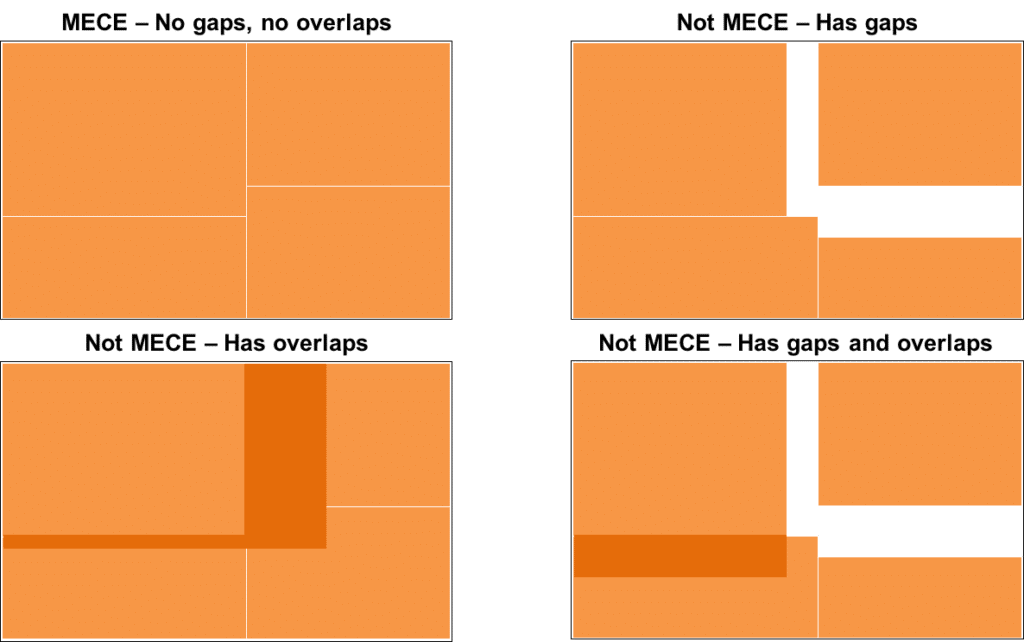
Easy, right?
Well, kind of. Most problems out there are harder than drawing rectangles.
So, to give you a better idea of how to apply the MECE principle to a business problem, here’s an image from our article on The 5 Ways to be MECE of different MECE ways to break down the same problem:
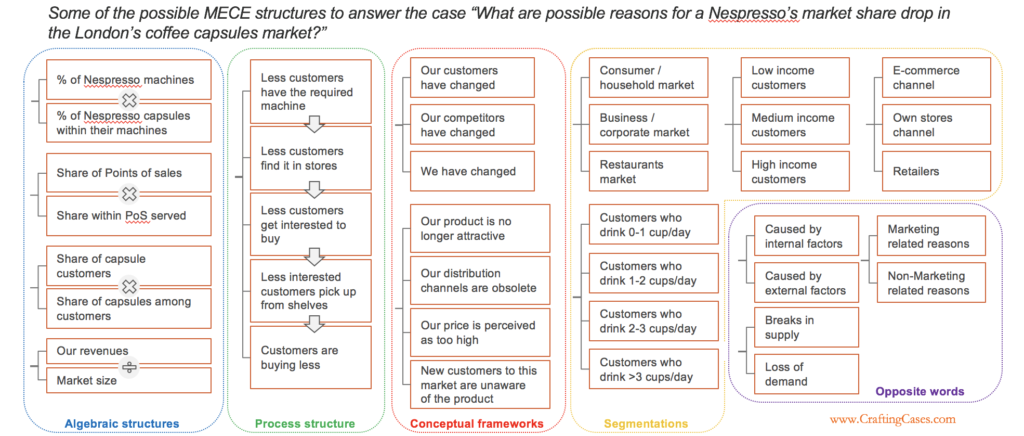
No need to worry about understanding this whole image right now, but the idea behind it is that (i) there are 5 types of ways to break down the problem in the image’s title (or any other problem) in a MECE way, and (ii) you can build different structures within each type.
An Issue Tree is built using a lot of these MECE structures. You also need to know how to pick among different options when you find more than one way to break down a problem..
I’m gonna link to the article on the 5 Ways to be MECE again because it’s the best way to learn about MECE in a practical way. Instead of a bunch of theory, I show actual techniques you can apply right now to any problem in that article.
Anyway, enough with MECE. Let’s jump into the actual techniques to build Issue Trees.
Technique #1: Create a Math Tree
Math Equations are ALWAYS MECE.
Equations have no gaps and no overlaps (otherwise they wouldn’t be equations).
Which is why I used rectangles within rectangles to explain MECE above. Rectangles are huge in mathematics if I remember my high school math right.
Anyway, one easy way to create MECE trees is to take advantage of that and ALWAYS break down the next level using a math equation.
Obviously you can only do that if your problem is numerical.
But since most business problems are numerical, we’re in luck!
I’m gonna show you how to do this in a “slideshow” kind of way because I wanna show you in a very step-by-step fashion, so be prepared to click on the arrow button more than a few times:
Creating math trees as a way to create Issue Trees isn’t hard at all once you get some practice.
But some of its nuances can be deceiving. Most people see them done and think they can easily do it, but it all goes downhill when they actually grab a piece of paper and attempt to do these trees.
So, here are four methods to actually create your “mini-equations” to break down each bucket:
#1. Use a proven formula
Most of the time you don’t need to reinvent the wheel.
If you know a formula that fits the problem well, just use it!
The most common one here is the classical Profits = Revenues – Costs, but there are others as you can see on the image below…
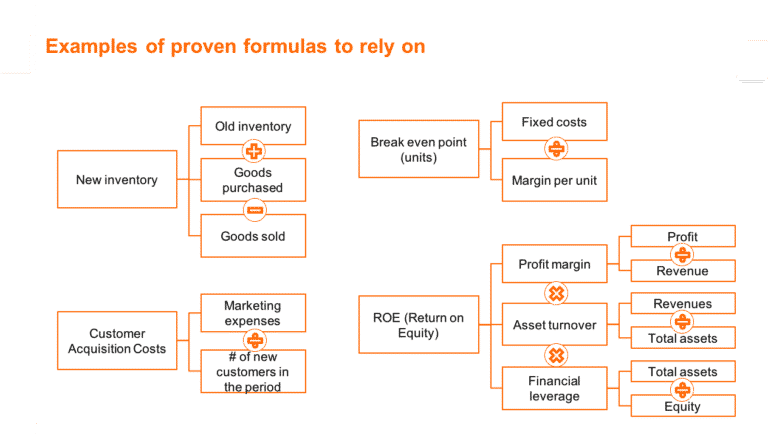
You don’t need to memorize any formulas for your case interviews, as you can use the other methods and they will work.
But knowing some of these, especially the most basic ones does help a lot.
#2. The "Dimensional Analysis" method
This one’s my favorite!
Just find one direct “driver” of the variable you want to break down – a driver is a “fundamental cause” for that variable.
For example, one direct “driver” or “cause” of revenues is the “# of customers” you have. If you get more customers, these new customers directly cause your revenues to increase.
Then, use dimensional analysis to find its mathematical complement. If you want “REVENUES” and you have “# OF CUSTOMERS”, you need to multiply that by REVENUE/CUSTOMER.
Just like in your high school physics class, customers on the numerator will cancel out with customers on the denominator and you’ll be left with REVENUES as a metric – exactly the one you’re aiming for.
This method is amazing because it lets you break down almost any metric into a formula really quickly – the only thing to be careful with is to not lose meaning in the process and end up with a formula that is mathematically right but doesn’t make any sense to actual human beings.
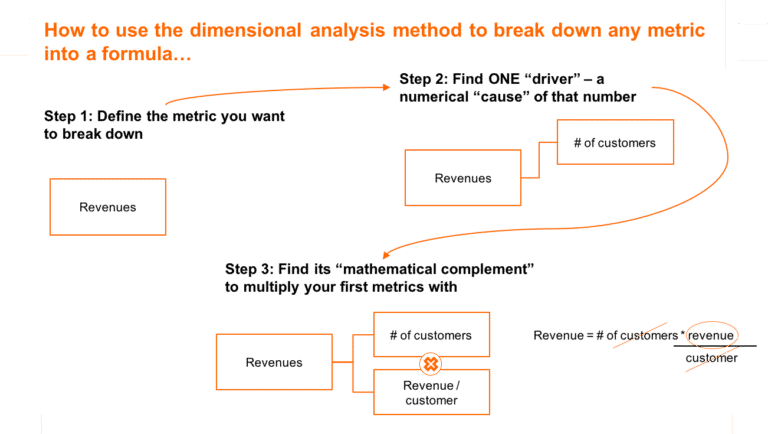
#3. The Funnel method
This works wonders when the target metric is a percentage or is the end result of a funnel.
Take one example from e-commerce: Conversion Rate.
This is the % of visitors in your website that buy from you. How can you break that down?
Simple, you multiply the steps of the funnel from visitor to buyer.
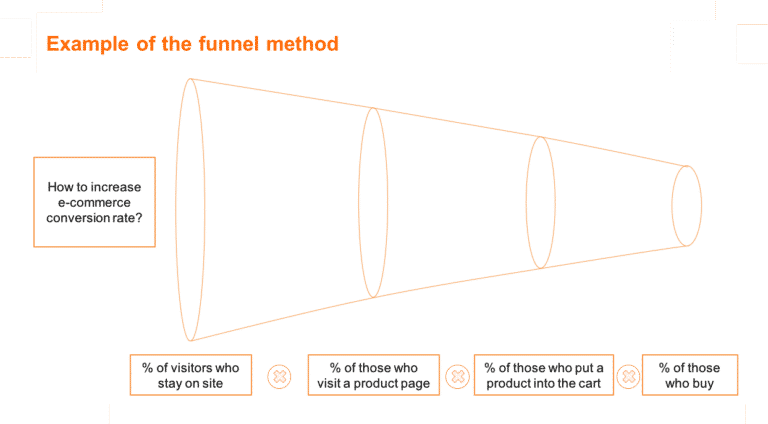
Funnels are everywhere: Sales, Product Development, Process Optimization.
All you have to do is to find these funnels and then break them into stages.
#4. Use a sum of segments
This is my least favorite method because it doesn’t go too much into the structure of the problem, but simply slices it out.
However, it can be useful.
For example, if you’re working with a conglomerate and their profits are down, it might be useful to segment that conglomerate into its different businesses.
Or if you’re trying to understand a company’s market share drop in a certain category, it might be useful to just break it down into the market shares of its product lines.
If you’ve read the article on the 5 Ways to be MECE and you’ve been paying attention, you might have noticed that method #1, “Using a proven formula” and #2, “Dimensional Analysis” will get you an Algebra Structure.
Method #3, “The Funnel Method” will get you a Process Structure.
Finally, method #4, “Sum of segments” will get you a Segmentation type of structure.
If you haven’t read the article, don’t worry about these names – they are some of the ways to be MECE we teach there. I’m just helping the folks who did read it already to make the connections.
So, summing up. You can use any of these four methods to create a “mini equation” and you combine these “mini equations” to create a “Math Tree”, which is the first technique to build and Issue Tree.
And it’s a technique that works great with numerical variables, but doesn’t really work if you have a different type of problem to solve.
So, to tackle non-numerical problems – or even to make better Issue Trees for numerical problems – let’s move on to the most powerful technique in your Issue Tree toolkit: layering the 5 Ways to be MECE.
Technique #2: Layering the 5 Ways to be MECE
Technique #1 works great because math is ALWAYS MECE and because creating equations isn’t too hard.
But not every problem is numerical and can be structured using equations alone.
And even to those problems that are numerical, doing a Math Tree isn’t always the best way to go about structuring them.
Here’s where Technique #2 comes in – instead of layering “mini equations” on top of each other, we’re gonna layer “mini MECE structures” on top of each other, regardless of them being equations or not.
Remember, we were confident to use math equations to build Issue Trees because they are always MECE. But from first principles what we need is MECE structure, not necessarily mathematical ones.
And where are we gonna find these “mini MECE structures”?
Easy, with the 5 Ways to be MECE. These are 5 specific techniques we’ve developed that guarantee a MECE structure.
I’ll make your life easier in case you want to read about that now and link to the article we wrote about them.
But here’s a quick recap:
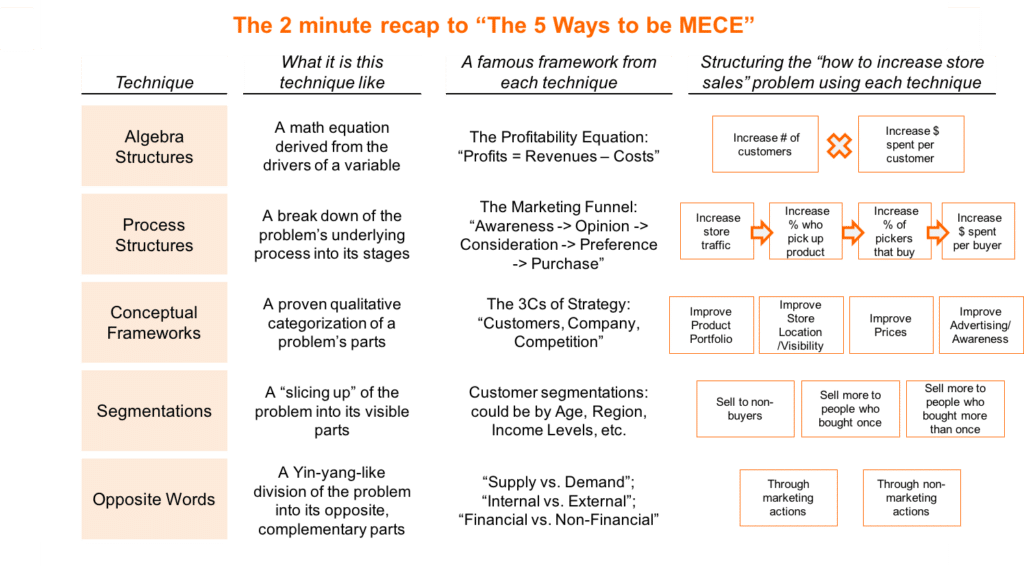
The process of building Issue Trees by layering the 5 Ways to be MECE is itself very very similar to the process to create Math Trees.
Step #1: Define the problem specifically (no need to be a numerical variable here).
Step #2: Break down the first layer using one of the 5 Ways to be MECE.
Step #3: Get to the 2nd (and 3rd, and 4th) layers by breaking down each bucket into another “mini MECE structure” that comes from the 5 Ways to be MECE as well.
I’ll show you the exact process to create an Issue Tree by layering the 5 Ways to be MECE through the example below:
Layering the 5 Ways to be MECE is my go-to method to create Issue Trees and break down problems or finding solutions.
I use it every day of my life, either on paper or just in my head.
And I used to use it everyday when I worked at McKinsey as well (even though I was doing it unconsciously – no one there had explicitly told me there were five ways to be MECE).
Now, let me address one thing that comes up often… One thing that may have crossed your mind as you were going through the three steps above regarding the Issue Tree is “well, but this is so obvious” .
That thought may have crossed your head in each break-down of a bucket or just when looking at the whole Issue Tree.
And here’s my take on it: a well-structured problem SHOULD look obvious – at least in hindsight .
How Elon Musk changes the world structuring problems in "obvious" ways
(I swear to you it’s interesting, but you can skip this green box if you want and/or understand why MECE Issue Trees are super important even when they’re “obvious”)
You’ve probably heard of Elon.
In case you haven’t, he’s this guy…

And he’s created these companies…

So, the guy basically transformed the payments industry, the automotive industry, the aerospace industry and is transforming the tunneling and the solar power industry.
But how does he do that?
Well, anyone who does that much has many “secret sauces”, but one of the special things Musk has is to think things from first principles.
In this fantastic blog post (from one of my favorite blogs), a guy who had access to Musk breaks down exactly how he thinks.
But let’s analyze one specific instance: how he came up with “The Boring Company”, a company that was created to dig tunnels more efficiently and solve the traffic problem in Los Angeles.
There are two underlying logics to the company:
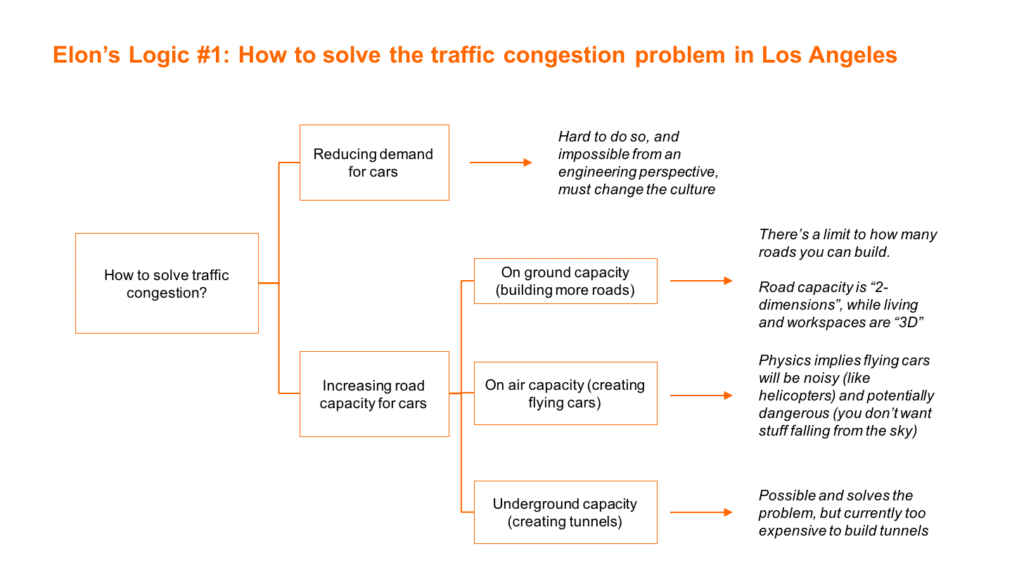
Simple logic, but a really strong reasoning about why tunnels are probably the best way to solve the traffic problem.
(And it actually is the only way that’s ever worked so far – demand for roads keep increasing no matter how many Uber rides people take, building more roads doesn’t seem to make a difference in most cities and no one’s ever been able to make flying cars… But most people in large cities take the subway/metro system every single day.)
Notice that we’re basically dividing the problem into supply and demand and then dividing “road” capacity into on ground, flying and underground.
There’s no rocket science here (pun intended).
Alright, but there’s still a problem with tunnels: they’re expensive to make. So, is it possible to make them cheaper? Here comes Elon’s Logic #2 to build The Boring Company:
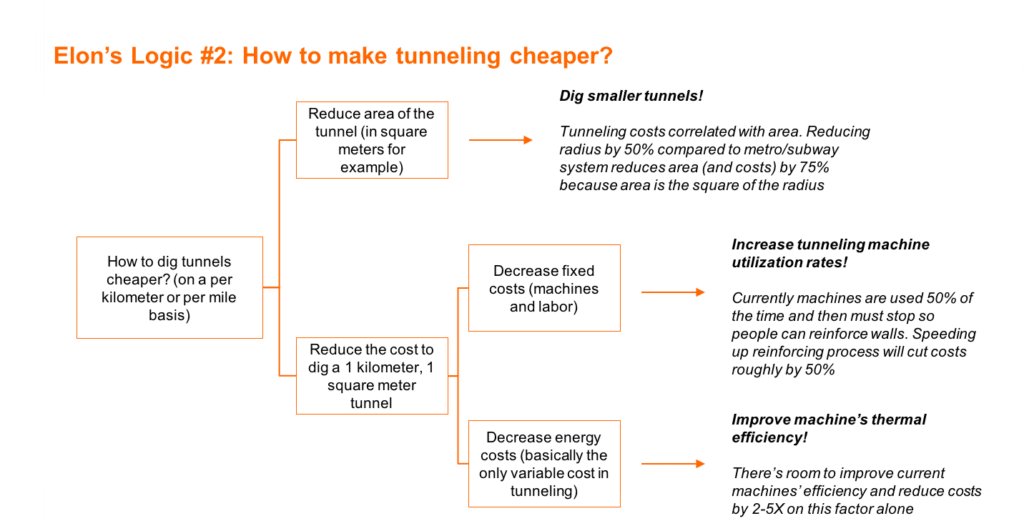
Again, no rocket science here (although a bit of tunneling science).
If you want to understand better how Musk thinks, I recommend this article and this TED Talk .
Now, onto what matters for us:
(1) Most traffic specialists know that trying to reduce demand is an uphill battle and that expanding road capacity is mostly fruitless.
(2) Most people in the auto/aerospace industry know that flying cars are a very far away dream
(3) Most people in the tunneling industry understand the cost drivers of a tunnel.
And yet, no one looked at the big picture and questioned things from first principles.
You need an Issue Tree to do that, even if it’s an obvious one.
I’m not saying Elon Musk draws Issue Trees for a living, but I know he has them in his head because he talks like he has one – I “took” both trees I showed you above from his own words.
Takeaway from the green box: Issue Trees are “obvious” because they’re drawn from first principles.
And this means if you want to think from first principles, draw Issue Trees.
Like what you read so far? Share the guide on you favorite social media!
Technique #3: creating decision trees.
In the realm of Microsoft Excel, the most basic kind of logic you can do is using math operators. That is, adding, subtracting, multiplying and dividing.
If you wanna go a step further you can use what they call “boolean operators”: AND functions, OR functions and so on.
And if you want to go a third step further, you can use “conditional operators”, the most famous of which are IF functions.
Decision Trees are basically regular Issue Trees with “conditional operators”, IF-THEN functions.
Now, let me translate into plain English for all the non-Excel nerds out there…
(Or should I say “future Excel nerds? I mean, this is a site for aspiring management consultants!)
When you do a Math Tree, the only way you have to relate the variables to each other is through math symbols. E.g.: Revenues = Price * Quantity. There is a mathematical relationship among everything in your Issue Tree.
It is great to have math because math is always MECE, but it is also limiting. What about everything that can’t fit an equation?
Enter Technique #2: Layering the 5 Ways to be MECE.
If you pay attention to it, everything that’s not in a mathematical relationship in that technique is joined logically by “AND” or “OR” relationships.
For example, we can find better employees ‘at the schools we already recruit in’ OR ‘in new schools’.
Another example, we can make new recruits better before their first project ‘by training them before they start’ AND/OR ‘as soon as they start working for us’.
Decision Trees are just like regular Issue Trees but they add another layer of logic to it: IF-THEN statements.
I won’t go into too much detail on how to build them because (1) it’s an advanced skill to be able to anticipate all the if-then logic required to take a decision before you even start exploring the problem, and (2) you don’t need to be able to do this to get a job at McKinsey, BCG or Bain if you can use the other two techniques well.
But I will give you a simple example below so you can see what I mean.
And if you want to learn more about this, here’s a timeless article from Harvard Business Review on Decision Trees.
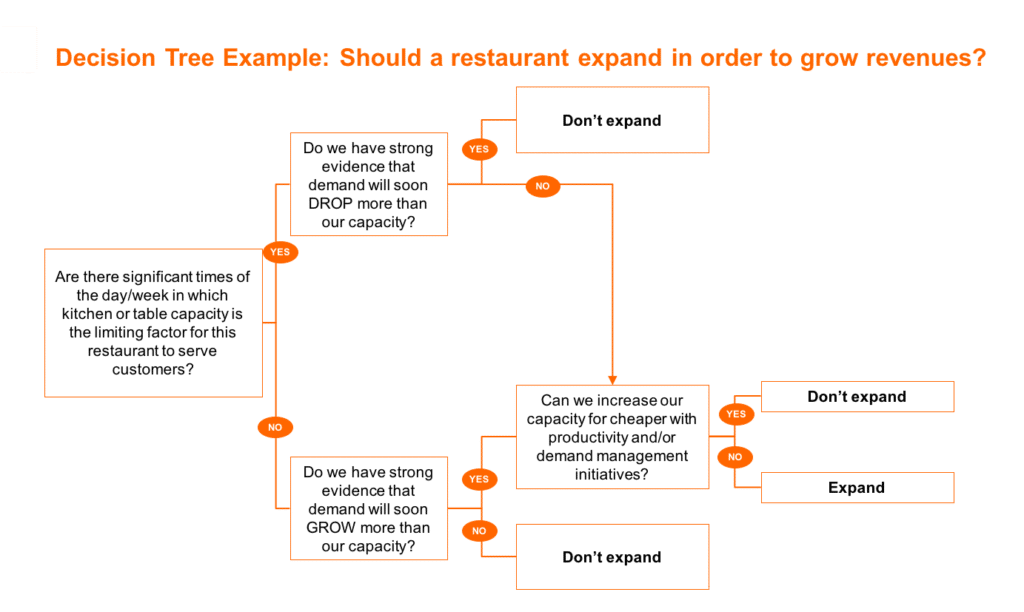
There are also different types of decision trees.
For example, you can create a decision tree for an investment opportunity that considers the probabilities of different events to happen in order to calculate the expected value (there’s an example of this in the HBR article I’ve shared above).
Or you can create decision trees for WHY and HOW problems where you use IF-THEN statements to say where would you focus and prioritize if certain conditions applied.
(An example of the last phrase is this: in a case on “How should a restaurant grow revenues”, you can say that IF it has lines/too much demand, THEN you would focus on increasing capacity through expansion or increased productivity, and that IF if doesn’t have enough demand, THEN you would focus in customer acquisition and retention initiatives.)
Decision Trees can get really complicated even for simple decisions, so I would NOT recommend you to start learning with them.
Focus on Techniques #1 and #2 to solve WHY and HOW problems.
For “decision-making”-type problems, we recommend you to learn Conceptual Frameworks first. We teach how to structure these problems using Conceptual Frameworks in our free course on case interview fundamentals.
Want to learn to structure any case?
Issue trees aren’t the only technique to structure business problems.
Join our FREE 7-day course on case interviews to learn other techniques so you can structure any case, solve any problem and impress your interviewer!
It’s nothing like the other content you see around – just fill your name and e-mail and I’ll send you the link to join.
To get access to it, just go to our homepage and hit “Join now!”
Six Principles for AMAZING Issue Trees
Man does not live by bread alone.
And Issue Trees need more than being “technically correct”
If Issue Trees had a “soul”, it would live in the six principles outlined in this short chapter.
In fact, if you follow the principles from this chapter, you don’t even need to use any of the three techniques I showed you on the last chapter.
And if you MASTER these principles, you might be able to come up with your own techniques.
(And if you do come up with a “fourth technique”, please shoot me an e-mail telling me about it).
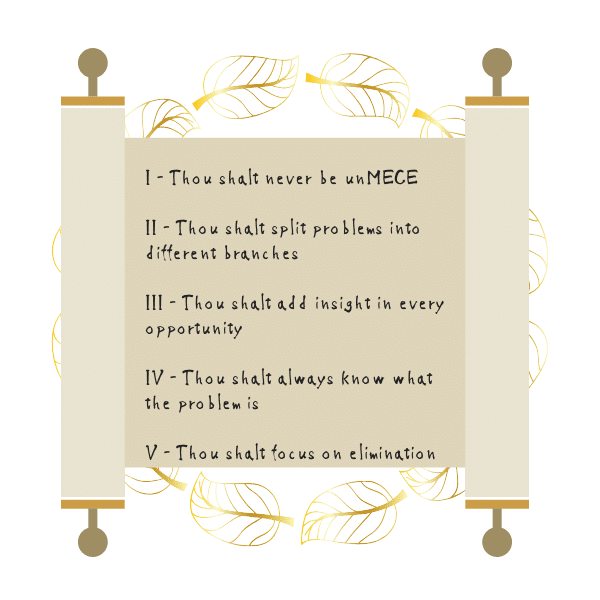
Separate different problems early on
Some restaurants that want to grow revenues should work on getting more clients. Others have too much demand and should work on expanding their operations to handle that and sell more.
Most companies that have employee attrition problem have some problem that makes people wanna leave their jobs. Others are just firing too many people.
And a violence crisis in a country could be caused by criminals. But it could very well be caused by a really violent police system as well.
The common factor between the last three situations is that each one could be caused by two COMPLETELY DIFFERENT PROBLEMS.
Separate them early on your Issue Tree because trying to fix the two things together will only lead to confusion. Not good.
Build each part ONE AT A TIME
Most people who see a huge Issue Tree for the first time are overwhelmed.
Of course they are!
They see this huge logical structure (that takes time to digest) and wonder if they’ll be able to do the same when they need to.
What they’re missing is that these trees are built one step at a time .
First you get the problem question and your only concern is to define it well.
Then your only concern is to break it down into a first layer.
Then you get each bucket from the first layer and your only concern should be to break each down into a “mini MECE structure”.
One bite at a time, you will eat the whole metaphorical elephant.
Each part must be MECE
I’ve talked about MECE before in this article, but I’ll do it one last time.
ME = Mutually Exclusive = No overlaps between the parts of your structure = your structure is as clear as the blue sky for another person to understand.
CE = Collectively Exhaustive = No gaps in the way you break each part of your structure down = your structure is rigorously correct.
MECE is tough for most people, but you can use the 5 Ways to be MECE as a checklist of structures you can use to be MECE.
That means it’s not gonna be as hard for you and you have more chances of getting the offer than the other people. Good for you!
Each part must be relevant and add INSIGHT to the problem
There are many MECE ways to break down any problem.
Choose the one that’s more relevant. The one that adds more insight to the problem.
For example, one of the Issue Trees from Chapter 2 was about improving the quality of new recruits in a consulting firm. Within “making the selection better”, I could’ve broken it down into “Stages 1, 2, 3” and so on of the selection process.
That would’ve been “technically correct” and “MECE”, but it would bring absolutely no insight to the table.
Because it wouldn’t be problem-specific .
Here are two resources to help you make your structures more insightful and problem-specific:
The first is a Youtube video on how to make better revenue trees. It shows how to create more insightful revenue trees but you can apply the same principles to any type of Issue Tree.
The second is “The Toothbrush Test”, a numerical measure so you can get a proxy of how insightful one structure is compared to another. You can watch the video here or read the article here .
Each part must be eliminative and help you FOCUS to the problem
An Issue Tree that is built in a way that allows you to ELIMINATE all the non-problems and focus on the one thing that’s driving the issue is way more useful than one that does not allow you to do that.
Say you’re a soft drinks company concerned that you’re selling less soda.
Here are two ways to structure the first layer of that Issue Tree:
(1) Drop in general soda consumption OR Drop in market share
(2) Customers less willing to buy product OR Competition getting stronger OR Company doing poor marketing or supply chain OR Distribution channels not exposing our product
Which one’s better?
Well, according to this fifth principle, (1) is better because it allows you to get data and eliminate a whole branch (unless the problem comes from both, of course).
Eliminative Issue Trees help you FOCUS the problem and waste less time (that means more 80/20 for you).
The key to be eliminative is to make each bucket FALSIFIABLE.
Falsifiable means you can find a test that, given a certain result , guarantees that the problem is not on that bucket.
This falsifiability is what makes Issue Trees “hypothesis testing” structures. If you want to be a hypothesis-driven problem solver you need to include falsifiability in your structures whenever you can.
However, this does not mean every single structure you create must follow this principle.
There are times where falsifiability is impossible , and that means you should focus your efforts in being the most insightful as you can (Principle #4).
It is usually in these situations where you’ll want to use a qualitative, conceptual framework. You can learn more about this in the free course we offer on case interview fundamentals. In the Frameworks module of the course we will show you exactly when to use conceptual frameworks and how to create them.by
Clarify what you need in each layer you build
You might be shy, but hey, overcome that shyness!
You don’t need to do guesswork to build your structures. You can ask first.
Actually, doing guesswork when you could’ve asked a simple question and eliminated confusion will harm your performance.
Say you’re breaking down how a consulting firm could hire better junior consultants. You’re trying to break down how they select candidates, but you’re not sure how their recruiting process is currently like…
Say to your interviewer:
“Hey, I want to break it down into the stages of the selection process but I don’t know what those stages are. Here’s what’s on my mind… Does it make sense or did I miss something?”
If you’re doing Issue Trees to solve a problem in your work, this principle is even more important. You can’t structure what you don’t understand, so when in doubt ask questions and understand it better!
Sometimes these principles will enter in conflict with one another.
You might need to choose between being more eliminative and being more insightful.
You might feel in doubt of whether you should be fully exhaustive (MECE) or just add the relevant stuff.
And when principles enter in conflict, experience and judgement are here to save the day.
Seeing real examples of real people that know what they’re doing making Issue Trees to solve case interview problems is invaluable to get that experience.
Which is why I will show you in-depth examples in the next chapter, including videos of me going through the thought process of building Issue Trees with you.
Watch and practice real case interview structures!
Join our FREE 7-day course on case interviews.
You’ll learn all the techniques you need to apply the best practices to impress your interviewer (as well as why they’re looking for those traits).
To get access, just go to our homepage and hit “Join now!”
When I was preparing for my case interview I looked for good Issue Tree examples all around.
I found none .
I don’t want you to go through the same, so here I’m gonna go all in and not only show you great Issue Trees but also show you, in video, how I think through each step of building them.
I’ll show you everything that goes through my mind as well as the specific nuances that make them great.

I will use different examples so you can see how the principles and techniques apply to different types of situations.
And I will do exactly what I’d do in a real case interview on when solving a real problem at work.
The only thing I’ll avoid doing is using Decision Trees.
Because it’s much much harder to get to a MECE result using them, let alone explain why it’s MECE. I’d be only showing off instead of actually helping you learn how the principles apply and what makes a great Issue Tree.
Not my style!
Example #1 - Airline fuel costs surge
This first example is of a fairly easy case question that would lead many well-prepared candidates to failure.
It’s funny how some problems can be easy to real consultants and yet hard even for candidates who have done 50+ cases.
Here’s why this happens: the business problem isn’t hard to solve from a first principles perspective (which is how good consultants tend to think) but they’re a bit unusual or too specific to an industry.
Most candidates who haven’t internalized the principles of solving problems well feel overwhelmed when they get a case completely unrelated to anything they’ve seen before.
Even worse is when this problem doesn’t fit the half a dozen frameworks these candidates have memorized by heart.
Here’s a video of this first example. I highly recommend you to try to structure this Issue Tree by pausing the video right after I clarify the case question and then compare your structure and your thinking process with mine.
If you don’t have access to audio or can’t watch a video right now, you’ll be able to keep reading and grasp the main insights as well, although I highly recommend you come back to watch this later!
So, what’s interesting about this Issue Tree example is that I have structured the first two layers of the tree as a Math Tree (Technique #1) and then I used the “Opposite Words” technique and the “Conceptual Frameworks” technique to build layers 3 and 4.
You can do that too!
Here’s the whole Issue Tree if you weren’t able to watch the video:
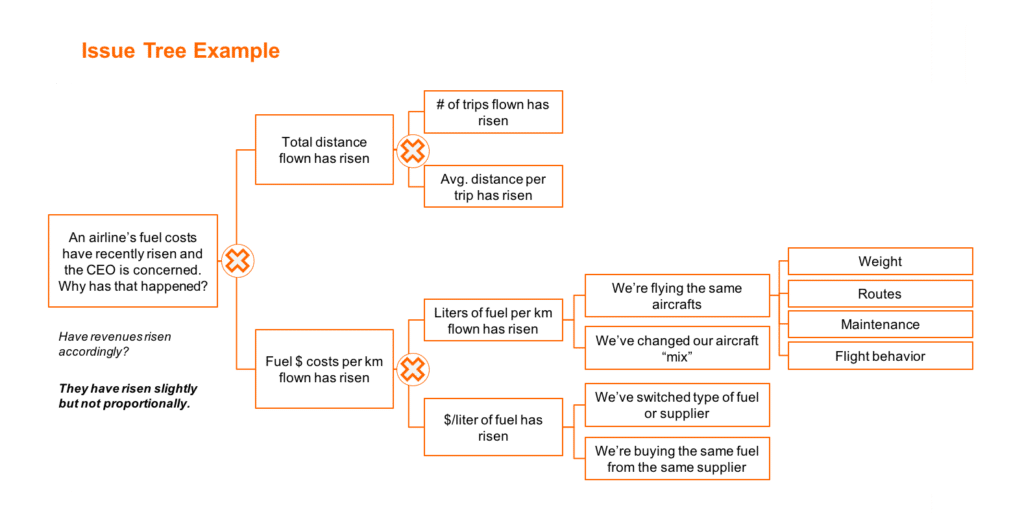
There were three main take aways from this structure:
Takeaway #1: Break down a numerical problem mathematically as long as the math remains meaningful/insightful – then get more layers using qualitative “mini-MECE-structures”
As with most thing problem-solving related, this is not a rule written in stone.
There are a few numerical problems that are best structured with a qualitative structure. And you don’t always need to do the qualitative layers afterwards.
But usually the best way to break down a math problem initially is to break it down into an equation first, as you’ll be able to quantify how each driver contributed to the problem.
And usually the equation alone won’t be enough to bring you to the meaningful stuff.
In this case, for example, if we were only mathematical in our structuring we would have missed important elements that show real world business intuition, such as “maintenance”, “aircraft weight” and “mix of aircraft in the fleet”.
Takeaway #2: Stop each branch when it can reasonably explain the source of the problem
I have stopped some parts of my tree in Layer 2, other parts in Layer 3 and others in Layer 4.
How did I make this call?
A lot of people have asked me this in the past: how can I know that my Issue Tree is done? How many layers do I need?
The rule of thumb is to stop when your buckets can reasonably explain the problem.
For example, on Layer 2 you have a bucket which is “# of trips flown has risen”. This can reasonably explain why fuel costs might have risen. It’s pretty logical – if you fly more trips, your fuel costs will rise as well.
Now, one could ask “why has the # of trips flown risen” and if that’s the actual problem going on, I as a consultant would want to know that. But that’s getting granular, you don’t need to go that far unless the problem is proven to be there.
If I told my mom or someone on the street that an airline’s fuel costs have risen because the # of trips have risen, they’d accept the answer and probably not question it further (and they certainly would tell me I’m a weirdo for caring about an airline’s fuel costs).
Now, if I told my mom or a random guy on the street that fuel costs have risen because liters of fuel per km flown have risen they would: (1) think I’m really really weird, and (2) not take that answer as it is.
Even if I used more accessible language and said that this airline’s fuel efficiency was down, they’d still ask me “why is it down”? (That is, assuming my mom is actually interested about airlines).
If I had stopped that branch on the 2nd layer, I wouldn’t be telling the whole story.
And so I went a level deeper.
Now, on the 3rd layer if I say that fuel efficiency is down because we’re using less efficient types of aircraft, most people would be satisfied with that answer. I can stop the Issue Tree here.
But in the case we’re flying the same aircraft, most people would NOT be satisfied. They’d be like “Hey, you’re telling me you’re less fuel efficient even though we’re flying the same aircraft? How come?”
And so we dig a level deeper on that one. Maybe the aircrafts are flying with more weight. Or we’re doing less maintenance. Or we’re flying at lower altitude and facing denser atmosphere. Or our pilots are changing speed all the time.
Most people would take any of those as sufficient answer. Which means we don’t need to dig a level deeper.
Takeaway #3: You can still go deeper in the buckets you need
If the last take away gives you an idea on where to stop structuring the Issue Tree, this one gives you permission to dig deeper than that.
Say your interviewer tells you the problem is that this airlines is flying their planes heavier and asks why that might be. Well, weight was at the end of our tree, right? But we can still investigate the reasons behind that increased weight.
Here I would segment the things that add weight to airplanes into their categories: people, cargo, equipment, fuel itself (we may be flying with excess fuel and thus spending more fuel to carry fuel itself).
Or say that the interviewer tells you that fuel prices have gone up even though we’re buying the same product from the same supplier.
Why that might be happening?
Well, either this supplier’s cost has gone up (because crude oil is up in price, for example) or their margins are higher (because we’re not negotiating as well, for example). We could dig deeper into each one of these factors if need be.
The point here is that even though you need somewhere to stop your Issue Tree (otherwise you’d spend the whole day building 15 layers), you also need to be aware that you can go as deep as you need to in the specific parts of your structure that the problem really is.
You find where the problem really is by getting data, numerical or not, for each part of your structure.
Example #2 - Overwhelmed consultant productivity
Real consultants have their own personal problems to solve as well.
And often time they will solve them with Issue Trees!
They’re a great way to see what your options are.
So before you look into this example, I want you to do an exercise:
**Action step: grab a piece of paper and write down all ideas you have to become more productive in case you were overwhelmed with work as a consultant**
What you’ll see from this exercise is that if you just “freely brainstorm” ideas to improve productivity on paper, you’ll end up with a huge list of (probably) unconnected action steps that are hard to estimate impact and to prioritize.
But if you had built an Issue Tree to organize those ideas , you’d get something much closer to an actual system to improve productivity.
Here’s what I mean by that:
This tree is solving a more qualitative problem than Example #1, but the techniques still work.
You define the problem really specifically at first.
And then you layer different “mini MECE structures” using the techniques from the 5 Ways to be MECE.
Here’s the final Issue Tree in case you couldn’t watch the video:
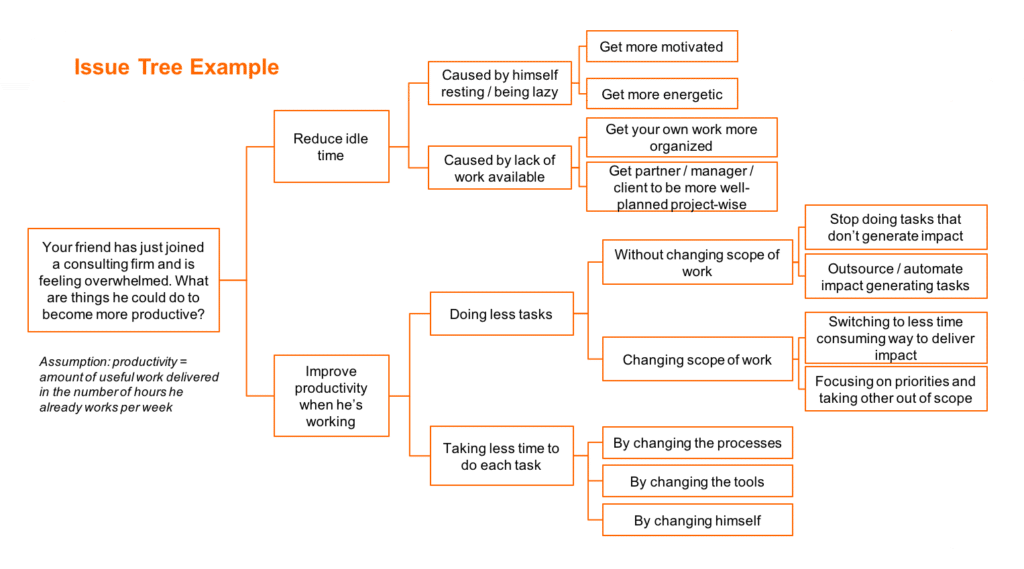
Of course your tree can still be different than this one and still be correct.
How do you know if it’s correct or not?
Well, simple: are you adhering to the key principles? Are you using the techniques I have shown you in this guide?
If so, your Issue Tree is good to go!
Example #3 - Help a government solve illiteracy in children
This is an interesting example because it focuses specifically on Principle #1: Separating different problems early on.
In fact, the whole Issue Tree is built by separating different problems over and over again.
Because the problem to be solved has many different possible root-causes that are completely different from each other.
Once you watch the video, you’ll see that the way the Issue Tree is constructed in a very intuitive way.
However, give this problem to most people and they aren’t able to structure it. They’ll spit out ideas and hypotheses without order nor an overarching logic.
Check it out how to help a government solve illiteracy in its children that go to public schools:
If you couldn’t watch the video, I’ll put an image of the Issue Tree bellow.
Notice how each layer is basically the previous bucket divided into two completely distinct problems.
The value of building Issue Trees like this is that you get a map of all types of possible root-causes. It’s also pretty easy to do so!
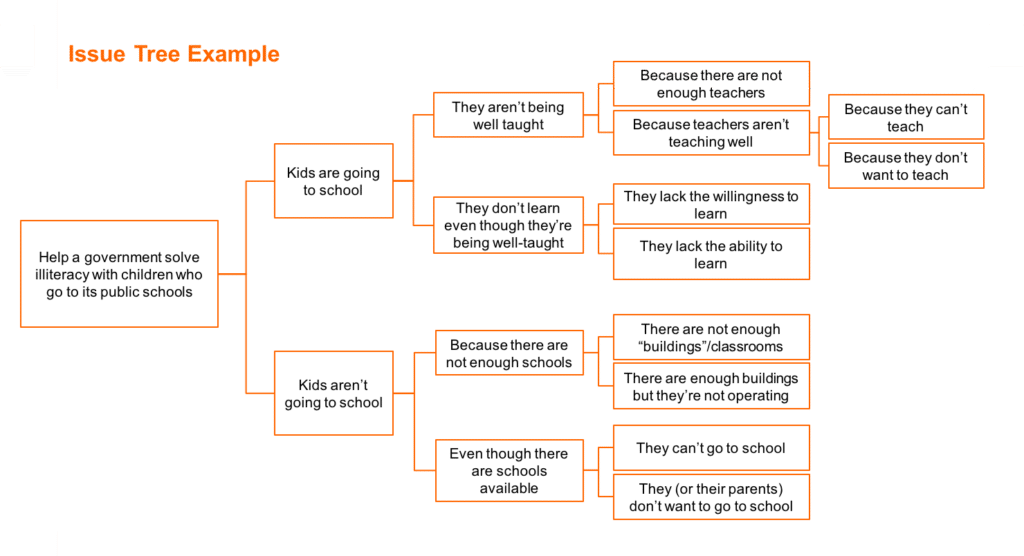
Friends help friends build Issue Trees... Share the guide on you favorite social media!
Common mistakes and questions.
I’ve helped hundreds of people learn to build Issue Trees.
In the process I’ve seen them making thousands of Issue Trees. And probably somewhere north of tens of thousands of mistakes.
Making mistakes if part of the learning process.
But you don’t have to make all those mistakes yourself because you can learn from theirs!
In this chapter I will show you the most common mistakes people make (with real Issue Trees, from real candidates) and also answer some of the most common questions that arise as you learn to build them.

What you can learn from the key mistakes of real Issue Trees from real candidates
When I first wrote the 5 Ways to be MECE article I had a little challenge in the end of it.
I challenged people to send me a structure for a specific business problem that could happen in a case interview:
“Imagine you’re doing a project with Amazon and they’re complaining about a surge in theft in their warehouses – what could be causing this surge in theft?”
And so I got dozens and dozens of real Issue Trees from real candidates for the same problem.
What’s fascinating is that all these candidates had three things in common:
(1) They were having trouble with creating MECE structures for their cases (or else why would you read a huge guide on how to be MECE?).
(2) They had just read a huge guide with different techniques to be MECE and instructions on how to build Issue Trees using these techniques.
(3) They were dedicated enough to take my challenge, spend 10-20 minutes building their best Issue Trees and sending them to me.
Still, even with all those things going for them, most of their Issue Trees had mistakes. Mistakes you and I can learn from.
So in this section I’m gonna show you their trees, point out their key mistakes and show you the feedback I sent them.
#1 - Anastasia and the sin of ignoring problem definition
The first Issue Tree I wanna show you was sent by Anastasia.
Here it is:
Seems like a quite good Issue Tree, right?
I mean, it describes quite well the process of a warehouse.
Well, not quite.
There are a few mistakes that this Issue Tree makes in terms of MECEness, some parts could be more insightful, etc. But the most important mistake here is that Anastasia ignored the specificity of the problem.
Much of this Issue Tree isn’t about theft – it is about losing items in general. So she’s talking about damage, negligence, machine mistake, etc.
Go back to the image above and click the right arrow to see all the areas of this tree that are not about theft at all.
Most of the tree is not talking about theft at all!
What that means is that she’s talking a lot about things unrelated to the problem and leaving a lot of important things out. It also implies that she wasn’t listening to the problem.
This is the #1 thing I’d tell Anastasia to focus on and the #1 thing I’d tell you to make sure you’re not messing up.
Now, Anastasia’s structure also has a #2 thing that I’d tell her to focus on if problem definition weren’t a problem: look for root causes.
While she makes an excellent description of how the warehousing process is and thus is able to map out where the problem might be, she never talks about the why.
You know, things like security systems and lack of penalties and having warehouses in areas with a lot of crime. The types of things you might expect for a WHY question…
#2 - How Anne messed up with layer ordering
This Issue Tree is actually quite good!
But it has three main mistakes. Can you guess what they are?
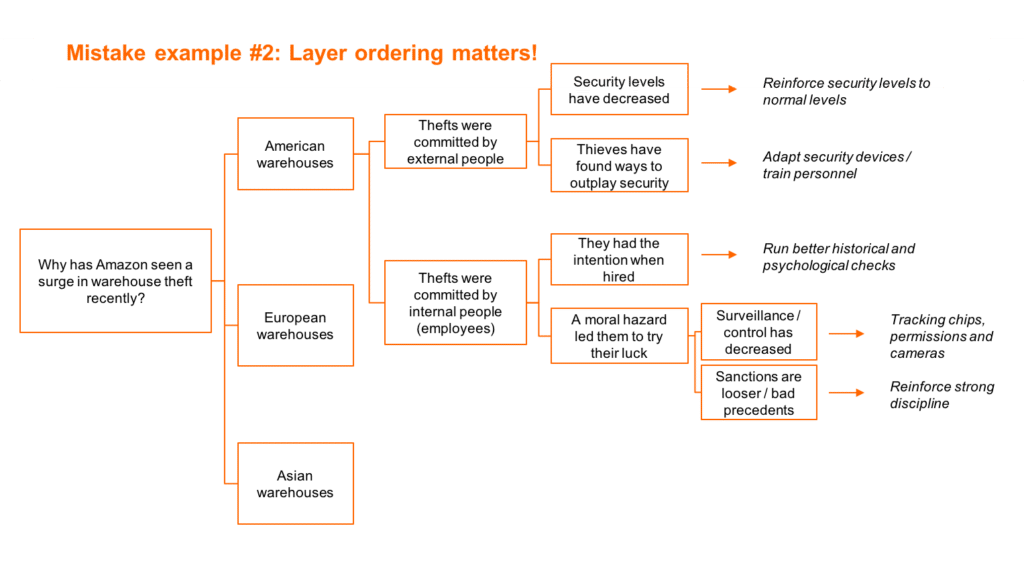
Well, I gave you the main one in the title.
Anne’s first layer shouldn’t be a first layer.
Because geographical location is not all that important. The different geographical areas of the problem aren’t the most relevant way to break it down.
What’s more, even if it were, why divide by continent? Why not small vs. big cities? Or low income vs. high income areas? Or high-crime vs. low-crime areas?
Anyway, I think it’s an excellent idea to mention that you’d like to see in which warehouses is the problem more prevalent. But what I would’ve done is to put that as a side note to an Issue Tree that actually digs into the potential causes of the problem, not as the main course.
She could’ve done an Issue Tree of causes for one warehouse and then said at the end: “and then I’m gonna look at these causes for all warehouses we have, segmented by geographical area, warehouse size, how old they are, etc”.
And what would this Issue Tree that digs into the potential causes look like?
Well, very much like Anne’s example Issue Tree for American warehouses (which I guess she would replicate for other continents as well).
Now, you might be thinking: what are the other two mistakes she made?
Well, one is that she offered solutions to each root-cause of the problem. That’s not a mistake in itself. In fact, I loved it. But the problem is that she was a bit too early on that – she should’ve gone a layer deeper into the why each thing happened.
Keep in mind the case question was a WHY question and not a HOW question.
And what she did was to suggest, for example, that if internal thieves who had the intention of stealing were responsible for the surge in theft, then they should run better checks.
What she should’ve done instead was to say that if that was the cause, then that caused happened because (a) they’ve stopped doing background checks, (b) background checks have worsened in quality or (c) background checks were never good at stopping that but that was never a problem beforehand. And then perhaps dig even deeper into the cause.
But she offered solutions before she got to the root cause, and that may hurt because she may be solving the wrong problem.
And the last mistake she did was one related to problem definition.
Everything she mentioned was related to the amount of theft. But we don’t know if that’s the problem. It’s not clear on the case question (on purpose). Maybe the problem is the value stolen.
So, she would’ve done much better by showing that in her structure. Maybe there are more thefts (in which case her issue tree is valid) and maybe the amount stolen per theft is higher (and because she didn’t consider this, she missed a whole part of the problem).
#3 - Guillaume and the "aggregator fallacy"
There are many problems with the Issue Tree below, for instance:
- A regional segmentation early on when that’s not a really relevant factor to explain the problem (as in Mistake #2)
- This regional segmentation isn’t even MECE (there are emerging countries in Europe and he forgot all developed countries in Asia)
- A lack of $ value of theft (again, as in Mistake #2)
- The way he breaks down a process structure to explain a surge in # of thefts per warehouse isn’t very insightful/relevant
But I want to call your attention to one other mistake which is related to causal effects. I call it “the aggregator fallacy”.
Can you spot it?
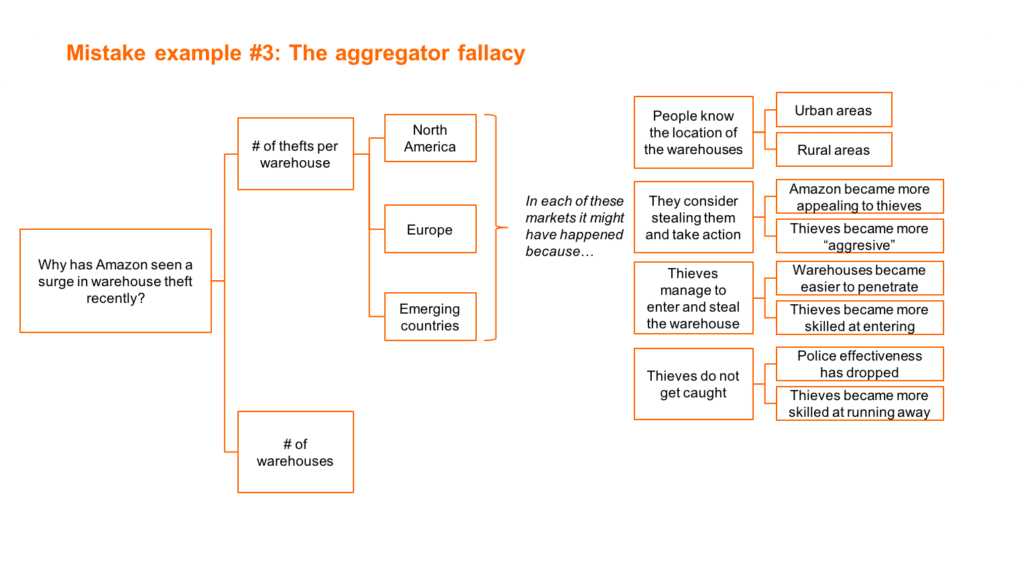
Let me ask you one thing… If the number of gas stations raise in a city by 2X in a year, will sales of gas increase by 2X as well?
Will they even increase by 10 or 20%?
Not necessarily!
More gas stations don’t drive more demand for fuel (unless there’s very few, high priced gas stations in town, but let’s leave extreme scenarios aside).
Yes, there might be 2X the number of gas stations because demand skyrocketed. But it could also be the case that gas stations were a really profitable business and entrepreneurs entered this market even thought there was no increase in demand.
It could also be the case that some people who don’t know what they’re doing entered the market even though demand didn’t increase and profits weren’t that high (and everyone’s losing money now).
So if you were to find out if demand for gas increased in a town one MECE structure you could use is “# of gas stations * avg. amount of gas sold per station”, but that wouldn’t be the best one.
Because # of gas stations don’t drive demand – more cars and more usage per car does.
The same thing is happening with Guillaume’s structure.
More warehouses don’t drive more theft. They don’t cause more theft.
Say, for example if Amazon had restructured their operations and they had switched from 10 huge warehouses to 100 smaller ones, with the goal of having faster delivery. Would it be ok for theft to increase 10X? Would it even be ok for it to increase by 50 or 100%?
Probably not, right?
Amazon’s carrying the same number of items, they have roughly the same number of employees (considering internal theft) and if they have their security systems in place, they’re not necessarily more attractive to external burglars (if anything, it’s harder to steal a smaller warehouse than a huge one).
More warehouses shouldn’t cause more thefts. The warehouse is not a driver of stealing just as the gas station is not a driver of demand for gas.
The warehouse and the gas station are merely aggregators of something. The warehouse aggregates products to be shipped (or stolen) and the gas station aggregates fuel to be sold (or not sold in case of a flat demand).
Which is why I call this mistake “the aggregator fallacy” – thinking that because the aggregator has increased that it has caused your problem.
Instead, try to build your Issue Trees with some causal relationship in mind. In the case of the gas station problem, that’d be “# of cars * fuel used per car”.
In the Amazon theft case, you could use “# of products in the warehouse * theft rate” if you assume that more products cause more demand for burglars or “avg. crime rate where Amazon warehouses are located * % of those crimes that are in Amazon’s warehouse” in case you assume that overall crime rate is a given and you can only control your exposure to it.
#4 - Jimi, the unMECE
Again many problems with this Tree.
You can mistake-hunt later at your own pace, so I’ll just point out to the ONE FATAL MISTAKE YOU SHOULD NEVER MAKE:
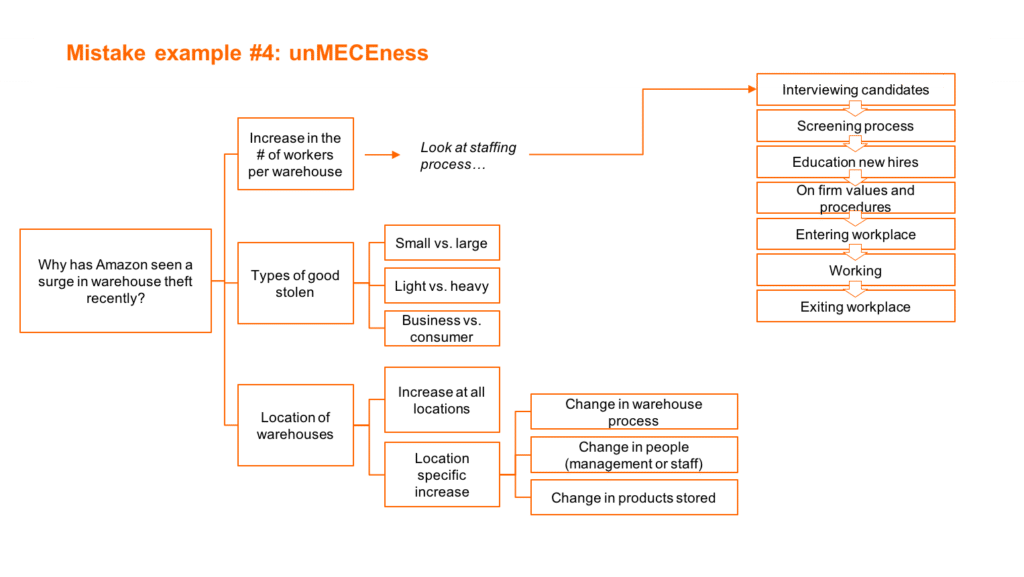
Jimi wasn’t MECE on the first layer of his Issue Tree.
In part because he insisted on using a conceptual framework (the hardest of the 5 Ways to be MECE) without needing to do it (as a theft problem is a numerical problem).
In part because he didn’t know how to create a MECE conceptual framework (as we teach in our courses).
And this would’ve gotten Jimi rejected from a real case interview at McKinsey, BCG, Bain or any other firm.
And it would probably get him fired if he was in charge of Amazon’s warehouses.
Don’t be like Jimi.
Always be MECE (and especially so on the first layer)!
#5 - Was Natalia rejected due to a simple mistake?
I actually like this Issue Tree quite a bit.
It’s well built, although there are a couple of problems.
And it’s interesting because Natalia, the lady who built this tree had been rejected from a Bain and a BCG final round before. She was preparing to try again. That means she was good enough to actually get to the final round but made some mistakes that prevented her to get the offer.
Maybe her mistakes were showing in her Issue Tree?
Perhaps… Let’s take a look:
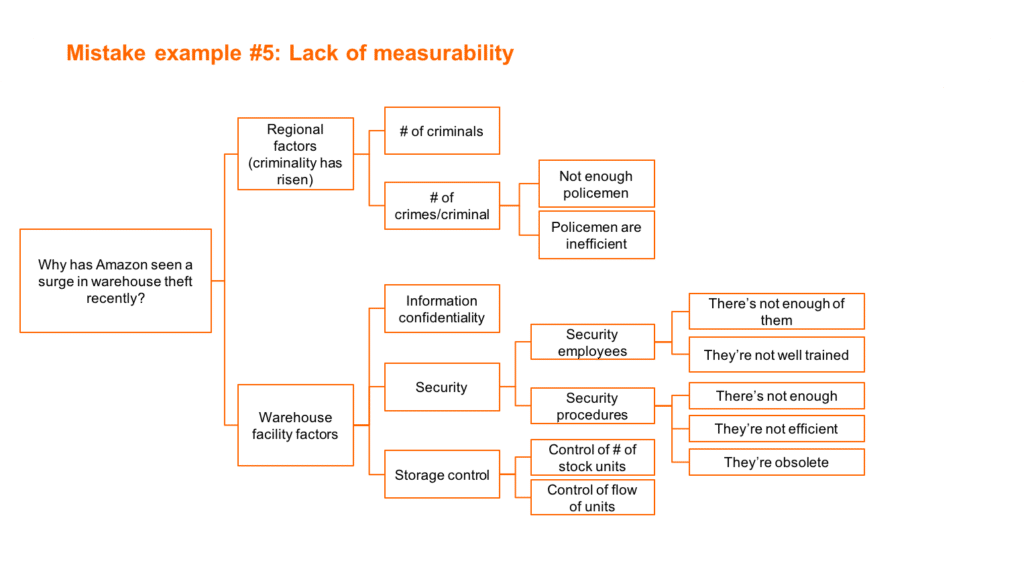
There are two great mistakes with this tree.
One we’ve talked before – Natalia went for a conceptual structure to break down the “Warehouse facility factors” bucket and had trouble building it. There’s overlap between “Security” and “Information Confidentiality”. Also, there are many things not considered here (including theft caused by internal employees).
But the one mistake I wanna call your attention to is much less obvious. It’s more a nuance than a mistake.
It is on the first layer.
The way she build it is much better than many alternatives: there’s external factors (crime) and internal factors (the warehouse itself).
HOWEVER, it’s really really tough to test which one is causing the surge in theft. These things look measurable but they’re not really.
Because measuring overall crime is a pain. And getting that data, an even higher pain.
Just to give you an example: what crime data should we consider to prove/disprove the fact that external crime has risen? Should it be overall criminal incidents? Thefts only? Warehouse thefts, specifically?
Also, how regional should the data be? Neighborhood? City? State?
And because you can’t measure “warehouse facility factors”, it’s hard to exclude a whole branch of the tree. Which means this tree is not very “eliminative”, because the factors in the first branch aren’t falsifiable.
Now, I’m being really picky here just to make a critical point to you.
Maybe in a real interview Natalia would’ve been able to come up with a test that would reliably eliminate a whole branch.
And maybe the problem could be solved without that kind of rigorous testing (e.g. maybe they completely switched their security personnel and had security holes in the process, so the cause would be obvious).
But if the situation was harder, more nuanced it would be tough to Natalia to actually diagnose the issue.
And whether she would be able to actually do it in real life is the #1 question in the interviewer’s mind.
Her first layer is not bad, but there are other MECE structures as insightful as this one that would also be more testable, more falsifiable.
And in a final round that could make all the difference.
Commonly Asked Questions
Learning from the mistakes of others is a great way to accelerate your learning curve!
But still, you might have some questions in your head.
Here are some of the questions I have been asked about Issue Trees throughout the years (and the best answers I have to those)…
Issue Trees are one structuring technique but they’re not the only one.
So there are actually two questions within this one: (1) How do I know if I should use a structure to solve the problem and (2) How do I know if I should use an Issue Tree or another technique.
Great questions!
Let’s start with #1…
You should use a structure to solve a problem, well, when you want to solve it in a structured way.
And when’s that?
Well, whenever you want to be able to foresee the steps to the solution of the problem.
That is, when you must have a due date of when the problem’s going to be solved (which is whenever you have a boss or a client, for example) or when you want to distribute the problem for other people to solve it (your employees or an outsourced company, for example).
That means almost always, especially in the professional world, where people have bosses, employees and clients.
Question #2 is a bit trickier to answer…
There are other structuring techniques – ways to break down the problem – that you can use. So, when to use Issue Trees and when to use the others?
Basically there are two scenarios: either you want to split the problem into components of the problem, or you want to look at the problem from different angles/points of view without actually splitting it.
If the first, use an Issue Tree; if the last, use another tool (such as a conceptual framework, as we teach in our free course on case interviews).
How to know which one you want is a bit more complicated and would take an article on its own to explain.
If you want the full details, check out our free course that you can find in our homepage or throughout this article, but here’s the long story short: if you want focus, efficiency and logic onto a well-defined problem use an Issue Tree and if you want awareness and insight onto a messy problem, use a tool like a conceptual framework.
A lot of people who teach case interviews say you should start with a hypothesis.
And they say that because MBB consulting firms (MBB stands for McKinsey, BCG and Bain) work in a hypothesis-driven approach. That means they come up with hypotheses and test them to find the truth (much like in the scientific method).
Being hypothesis-driven is tricky because you also have to be structured and MECE.
So, how do you make your hypotheses MECE?
Well, one way some people figured out is to build a MECE tree and just throw the word hypothesis around. If it were in a case investigating why profits have fallen, this would sound something like this:
“My hypothesis if that profits have fallen because sales are down. To know if that’s true we need to look at sales and costs.”
Notice how there’s ZERO value add to using the word “hypothesis” in the phrase above. If the guy had just asked for sales and cost data he’d ask the same questions, do the same analysis and reach the same conclusion.
If you just want to use the word hypothesis like that, go for it, but there’s absolutely no need to do it. If your buckets are MECE and testable with data, you can just lay out your Issue Tree with no “hypothesis” and test the buckets.
However if you can’t make your structure MECE/testable, you might need to use a hypothesis, but it’s a completely different type hypothesis than the one I’ve shown you above. Instead of being just a random guess with the word hypothesis on it, it must have a structure which we teach in the “Hypothesis Testing” module from our free course.
Great question, glad you asked that!
Clarifying questions are the questions you use to define the problem so you can create your structure / Issue Tree.
You use them to understand the problem better.
If the answer to a question you ask could potentially lead you to solve the problem then the question is a part of the structure of the problem and should be within your Issue Tree.
Drawing Issue Trees on paper is good practice whether you’re in a case interview, helping a client or solving your own problems.
The reason for that is that having it on paper makes it easier to communicate the ideas and frees up space in your mind so you can actually think about each part of the problem.
Not drawing the tree is kind of like memorizing a map – it’s helpful, but the whole purpose of the map is to be there when you need it without you having to know anything by heart.
But drawing does take a bit of time and in answering certain questions in case interviews, interviewers want you to be quick and may even ask you not to use paper . THIS DOES NOT MEAN YOU’RE ALLOWED TO BE UNSTRUCTURED.
It basically means they want to see if you can be structured and communicate your ideas in a structured way even when you don’t have a lot of time to think through a structure and draw it on paper.
Issue trees are a representation of how a consultant thinks. That means consultants think in Issue Trees .
They communicate using these trees as the underlying structure of the ideas they’re thinking through.
So if you don’t have time at all to think, you don’t have to draw your Issue Tree on paper, but you still must communicate as if you were going through one.
This is a super common question, and a highly context dependent one.
If you’re in an interview and it’s a more conversational, back-and-forth style, you should use less layers and get data so you know where to focus on (and dig deeper on that one).
If you’re in a more structured rigid interview format without a lot of back-and-forth, you should use more layers and they may never give you data.
The first scenario will typically happen at BCG and the second at McKinsey. Other firms will depend more on office / interviewer.
But this is not a rule. I’ve gotten the first scenario at McKinsey (final rounds) and the second at BCG. This means you’ll have to feel the situation a bit, or even ask the interviewer what they prefer.
But there’s a rule of thumb: no less than 2 layers and no more than 5 layers, regardless of format.
Because with just one layer you’re not really structuring the problem. You’re not showing a map of the situation. And with more than 5 layers the time it takes to build each layer grows while the value each layer brings diminishes. Your interviewer can always ask you to dig deeper in a certain bucket if they want you to (and they often do).
That’s true!
Drivers are “underlying causes”, and Levers are “potential things you can do to fix the situation”.
You use drivers for WHY problems and Levers for HOW problems.
If you build a good WHY tree and a good HOW tree for the same problem you’ll see the similarities and differences between drivers and levers (and you can actually go back to Item #4 in Chapter 1, where I did just that).
Simple example: if costs in a factory have increased and you want to decrease them, “material costs” could be a driver of the problem AND a lever to solve it, “taxes” could be a driver but not a lever (because you can’t change it) and outsourcing could be a lever to solve it but not a driver of the problem.
Drivers must be potential causes to the problem and Levers should be under your control.
If each part is MECE, your structure is MECE.
To know if each part is MECE, read the 5 Ways to be MECE .
And to know if your conceptual framework is MECE, check out our free course on case interview fundamentals.
Also, don’t obsess too much. There’s usually a bit of overlap between areas and no framework is FULLY exhaustive. You want to aim for “as MECE as possible”, not perfection.
Take their hint and go do it!
Interviewers are there to help you. If they tell you the problem is elsewhere, it probably is.
That doesn’t mean there’s absolutely nothing happening in the parts of the structure you were working on, but it does mean that they want to test your problem solving skills in the other part, not in the one you’re at.
If you got stuck, it’s either building your issue tree or using your issue tree.
If you got stuck building your issue tree, that means you need more and better practice. There’s a whole section on how to practice in this guide (and it’s the part that’s coming next).
If you’re in the interview already, however, there’s no time left to practice. So, what do you do?
My advice: keep it simple.
Take a breath, rethink the case and create a very simple, down-to-earth structure that can solve the problem. Not a good time to be sophisticated and elaborate when you’re stuck.
Now, if you already have your tree and you got stuck using it, here’s what you should do:
Eliminate as many parts of your tree as possible and find out everything that is NOT a part of the problem .
It’s much easier to say something is not a problem than to say for certain that something else is.
Use this process of elimination to your favor. Doctors use it all the time to save people’s lives (they call it a differential diagnosis) and you can too to save your own butt in your interviews.
How to Practice Issue Trees
Practice makes perfect.
Or, as a teacher used to say, “Practice makes permanent”.
(Which means poor practice is worse than no practice).
You can have all the theory in the world, you can have seen all the examples and still not be able to perform when the time to use this tool comes.
Which means that reading this guide is useless if you don’t apply it into practice.
In this chapter, I’ll show you how.

4 ways to practice Issue Trees
I could just tell you to go practice Issue Trees.
But then this chapter wouldn’t exist!
Just kidding 🙂
Here’s the thing, telling people to go practice Issue Trees is what we did when we started our case interview coaching practice.
But it didn’t really work.
Most people would just memorize the common profit trees you see out there and try to apply them to different problems. The problem with that is that they weren’t building their ability to create new trees for new problems.
Other people would feel stuck. They’d get bogged down into the details and be afraid to do it wrong and waste their time. Or they wouldn’t know where to start.
So what did we do?
Over time we created different techniques for people to practice trees. Each one has a different function and they’re synergistic – the more techniques you use, the more you’ll learn.
Here are my four favorite ones:
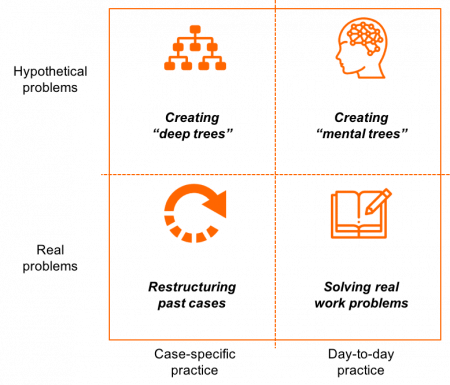
As you can see there is a logic for the four types of practice I will suggest. (And yes, as a former consultant I can’t get over with 2×2 matrices.)
Case-specific practice is important because this type of practice is very targeted to what you’ll find in your case interviews.
But you also need more generic day-to-day practice because that will train your mind to always think in a structured way . Even when you’re in the bus. Even when you’re hanging out with your family. Even when the interviewer asks you that informal question about the time where you studied abroad.
On the vertical axis, you’ll find the type of problem you will be practicing with.
You need to practice with real problems you’ve tried to solve before because you are (or were) emotionally invested in them. You know nuances about them that you wouldn’t know about a random problem and you care (or have cared) about solving them. That gives you the rigor and confidence to structure problems with all the nuances and details they need.
But you also need to practice with hypothetical problems , problems you’ve never considered before. Why? Because that gives you the flexibility and confidence to structure any problem, even those you have never seen before!
It helps you be more creative and trains you to face the unknown. What’s the point of learning to structure problems if you can’t face new problems, after all?
Using the four techniques I’ll show you, you will get all four types of practice.
Actually, because this is a 2×2 matrix, practicing with three of these techniques should be enough to get you really good at this, so if you don’t like any of these, feel free to skip one of them if you want.

Practice #1: Creating "deep trees"
The first type of practice is that of creating very deep Issue Trees for hypothetical problems, simulating one you would do in a case interview if you had 20-30 minutes to think or one you would do in a real project.
The process is rather simple:
(1) Think of a problem (business or public sector) that someone might have to solve. It could be a WHY problem or a HOW problem.
(2) Create a multilayered Issue Tree to solve the problem. Aim for at least 6 layers and try to create even more than that as you get more practice.
What you’ll notice is that the first few layers are going to be quite easy, especially if the problem you chose to structure is a common one.
However, as you go deeper you’ll find that it gets harder and harder.
Because when you get deep into your Issue Tree you must deal with much more specific problems, problems that you might have never considered in your life before.
The deepest layers are the ones that teach you the most.
Everyone knows how to break down “profits” in a MECE way. Few people can break down “improving customer retention” in a MECE way. Even fewer can find a MECE structure on how to increase customer friction to leave to a competitor.
This exercise works wonders because most cases start really broad but they eventually get to really specific issues, such as “increasing customer friction to leave”, “outsourcing job tasks”, “reducing perceived purchase risks” and things like that.
Here’s an example of a “deep tree” for the “How to reduce costs in a widget manufacturing plant?” problem:
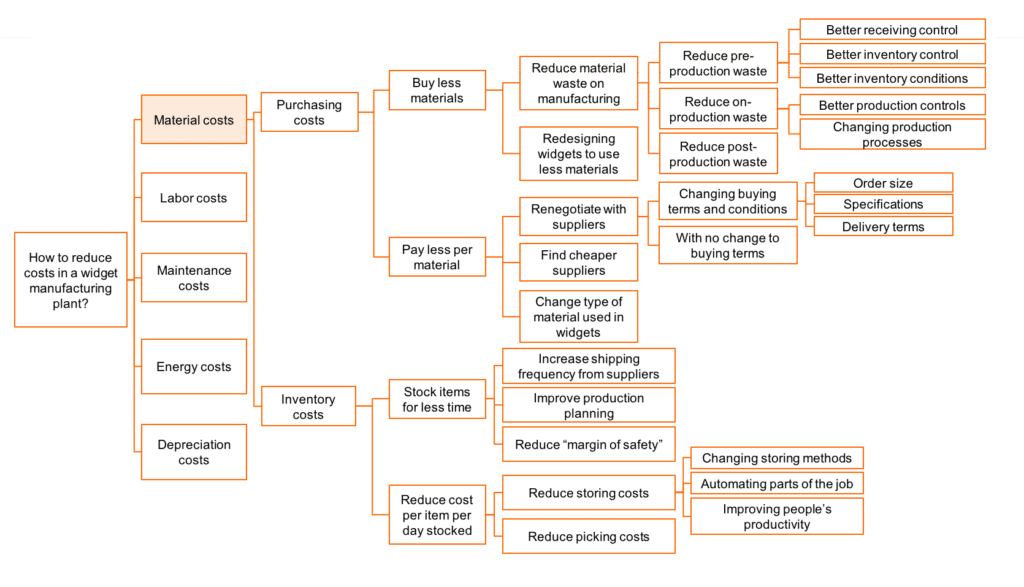
Hey, I’m the first to say this tree isn’t perfect, especially in the last couple layers. It’s really hard to create MECE structures to “buying terms and conditions” and other specific things like that.
And I only covered the “material costs” part, otherwise it wouldn’t fit the screen.
But I wanted to show you one example just do you could see how deep you should go when doing this kind of practice.

Practice #2: Restructuring past cases
Remember the last case you did? The one you messed up on the initial structure?
How much better would your structure be if you had 20-30 minutes to do it?
There’s a simple way to find out…
Restructure that case with as much time as you want!
This is a really good way to practice Issue Trees because (1) you internalize what you’ve learned in the case and (2) you can structure it with unlimited time and without being nervous.
Plus, let’s be honest, you keep telling yourself that your structures aren’t as good as they could be because you don’t have a lot of time to build them and you’re nervous.
But is that really the case?
Try it out!
This practice is as simple as the name suggests, but there is ONE NUANCE…
You will feel tempted to overemphasize the parts of the case your interviewer directed you to and underemphasize other areas.
So, for example, if you had a profitability case and the case ended up being about cutting labor costs in a telecom company, you will tend to make your structure much more robust in the labor costs part than in the rest of the tree.
DON’T DO THAT.
Instead, build a robust tree all around.
Maybe this case was about labor costs, but the next one could be on infrastructure costs and the one after that could be on pricing. Build a robust structure all around that simulates what you would’ve done had the interview gone in any of those directions.
Be prepared for every situation.

Practice #3: Solving real work problems
Got a problem at work?
Work like a consultant and build an Issue Tree first and foremost!
Have to hit a certain target in an organization you work at or collaborate with?
Break that metric down into an Issue Tree and find the best lever to focus on.
Have a school assignment?
Try to build an Issue Tree for it.
By doing these things you will incorporate Issue Trees in your daily work and study.
Sometimes I even create them as I read a book to better organize its ideas. And as I do that, I end up with the whole structure and all the important ideas of a book in just one page.

Practice #4: Creating "mental trees"
Remember I said you can do 3 out of the 4 types of practices in this chapter and still do fine?
Well, don’t skip this one.
Mental trees exercise a different muscle than the other practices, because it happens all in your head.
It’s kind of like mental math but for Issue Trees.
And it’s a skill that every consultant can do , and so should you.
So what are “mental trees”?
It’s simple. As you go through your day you will notice things. You will be curious about things. You will wonder how to fix certain problems or why they happen in the first place.
You’ll have questions such as:
- “How could this restaurant generate more demand?”
- “What could the city do to improve its transport system?”
- “Why is the doctor always late for the appointment?”
- “What will TV networks do to generate more revenue now that everyone’s on Youtube and Instagram?”
And as you have these questions, use these opportunities to create Issue Trees in your head.
Not huge ones, 2 or 3 layers is fine.
But do that and try to keep them in your head as you generate hypotheses for each bucket. At first this is gonna be really hard, but once you get the hang of it it will be a breeze.
And once it’s easy, you’ll be able to use Issue Trees whenever you need them.
This practice is especially important for final rounds because partners will often tell you to discuss a problem without using paper. (And they do expect you to structure it).
You've read this far. Why not help other people find this guide too? Share the love 🙂
Applying issue trees on the job.
If you’ve read this far, you’ve learned how to use the most versatile tool in solving business (and many other) problems.
And if you’re like me, you want to now maximize the value you got from learning this!
Issue Trees can help you be a better problem solver, but also to present your ideas better, to bring more and better insights and even to be a better manager.
In this chapter I’ll show you 5 direct, on-the-job applications of Issue Trees that you can use if you’re a consultant, if you work in industry and even if you have started your own business.

Issue Trees can be used in every facet of your job
Before we even jump into examples of direct applications of how to use Issue Trees on the job, let me make a bold claim: Issue Trees can be used in every facet of your job.
You know that saying about how everything looks like a nail to the guy who has a hammer?
Well, don’t think of Issue Trees as hammers.
They’re more like Swiss army knives or Microsoft Excel. It’s a tool with many functions.
And you can use it as a consultant, but also as an executive, as an entrepreneur and more. I once taught my dad who is a doctor how to use it and he’s now better able to explain his thought process and diagnostics to his patients.
Why am I telling you all this?
Just so you know that the 5 on-the-job applications I’m about to show you are some of the things you can do with Issue Trees.
With a bit of creativity you can do much more.
Application #1 - As a map to solve a specific problem
If you’ve spent any time at all as a knowledge worker in your career (that’s most analyst and management positions at most companies), you know how it feels to be stuck with a problem.
Most business problems start with a very simple, almost trivial, question, but as you dig deeper you start seeing all the nuances you feel overwhelmed.
It’s very different from the experience of solving a problem in business school, where all the information you’ll need (and all the info you’ll get) is in a neat 10-20 page case.
Anyway… When you feel overwhelmed, when you feel like there’s too much nuance to handle and when you feel like there’s so many directions to go what you need is a map. A high-level view of the problem with its distinct parts laid out in front of you so you can put numbers, hypotheses and plans to act in each part.
What you need is an Issue Tree.
Years ago I worked in a Venture Capital firm here in Brazil. They had just entered the market and wanted to invest in e-commerce.
My task was to figure out what types of e-commerce businesses would thrive in the country so they could invest well. Would it be auto-parts? Maybe fashion? Or perhaps food delivery?
It was an overwhelming task for me. There’s so many things you can do with e-commerce.
So what I did was to build two Issue Trees. One with our options and another with the high level criteria I’d want to see in each option for it to become a successful e-commerce.
Something like this:
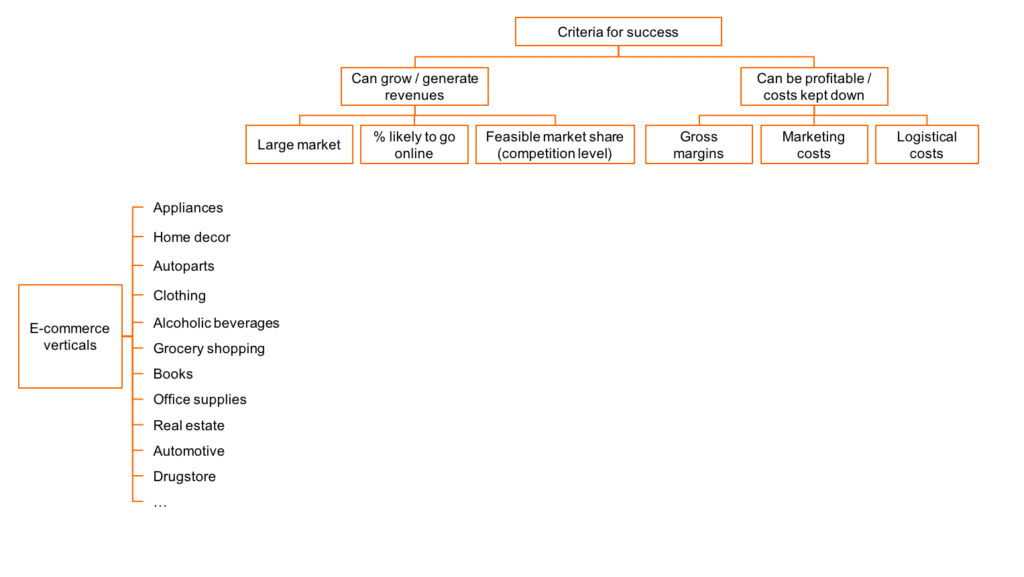
Now, the real trees I did were a bit more sophisticated than this. They had:
- More layers and a more MECE structure for the verticals
- Other criteria for success not shown here
- Prioritization so we could find the most important information first and eliminate whole verticals quickly
But you can get the idea… I got both of these trees and put into a spreadsheet and now I had a map of the problem that I could work on.
Because I used Issue Trees to create this map, I assured that the thinking was clear and rigorous, that I would be able to work efficiently by eliminating bad options quickly and that I’d bring insight to the table.
It also removed all overwhelm and made my work much more efficient. I no longer had to consider all the factors at once in my head. All I had to do now was to fill out a table with the best information I could get and see the results.
Application #2 - As a guide to brainstorm solutions
Brainstorming solutions to common business problems is a nervous activity.
Everyone wants to show the best solution, and people want to show common sense AS WELL AS creativity. It’s a tough spot to be in.
On top of that, people typically brainstorm solutions to problems that are urgent and critical (why fix what’s not broken?) and this is usually done in meetings, which adds to the pressure.
But that’s not all… In most meetings, solution generation happens in a haphazard way – completely different ideas are mentioned in the spam of a few minutes and it’s hard to even evaluate which are the best ones.
The result? The best solutions rarely win and it’s common that people don’t even reach a consensus on which should be implemented.
So, what’s the antidote?
You guessed it: Issue Trees.
If you have a solution generating meeting (or if you’re doing it by yourself) and you can find a HOW tree that reaches consensus (not actual solutions, but the structure of the problem) at the beginning of the meeting, you can then lead the discussion forward, helping people generate solutions for each bucket of your tree and then prioritizing those in an organized fashion.
Also, doing it this way tends to bring out more, better ideas – for the same reason why dividing the problem brings more creativity in case interviews. It’s easier to get 5 ideas per bucket than 40 for the problem as a whole.
I’ve been to both kinds of solution-generating meetings. One feels like a pointless chaos and the other gives you certainty that the problem will be solved from minute one.
Application #3 - As a way to structure a presentation
Structuring a presentation is the kind of thing that gets most people CRAZY.
You have to consider your audience, how to capture and keep attention, storytelling, getting your point across quickly and being to the point and so many other conflicting goals.
But here’s a simple way to do it: use the Issue Tree of the problem as a basis to how your presentation is organized.
This works because your Issue Tree is a map of your problem. And maps are great ways to make people understand a complex thing with simplicity and accuracy.
Let me show you an example of how to do this…
Remember the Telco executive from Chapter 1 that had a problem because his customers were unsubscribing from their services? I’ll help you remember it, it’s been a while…
Now, imagine he had to present what’s happening to the executive committee. It needed to be a short and to the point presentation that was compelling as well.
Not a full solution to the problem, but a presentation showing what happened.
What would you do in his place?
Here’s what I’d do:
Slide 1: A chart showing the high level problem (overall unsubscriptions have raised from 10.5 to 17 thousand clients, with an increase of 2,000 from clients willing to unsubscribe and 4,500 from clients being forced out).
I’d also add something that pointed out that the cause of the clients being forced out (the main problem) was a problem in the systems.
In other words, Slide 1 would be “High-level view” + “root-cause of main problem”. Everything the committee needs to understand the situation.
Slide 2: A chart detailing the root-cause of the main problem, with all details needed to understand why it happened. This would include numbers and qualitative things about that system problem.
Slide 3: A chart showing that even though we only lost 2,000 extra customers because they wanted out, we actually lost 3,000 to competition. I’d show the numbers (2nd Layer at “They wanted to unsubscribe” bucket) and show that there is potential there.
Slide 4: I’d turn back to the system’s problems and start talking about solutions. I’d show what was done, what is being done and what’s next to prevent it from happening again.
Slide 5: I’d show next steps to understand how to retain more customers vs. competition. This is a less urgent problem so I’d leave it at that.
That’s it, simple and straightforward.
And it all comes because I have a simple and straightforward Issue Tree that helps me solve and explain the problem in simple and straightforward ways.
Application #4 - As a guide to research best practices
We’ve all had that hurried boss that passes through your desk and casually mentions: “Hey, you should try to find some best practices around X”.
X can be anything he or she is concerned about: doing better presentations, sharing internal documents, improving productivity at work, getting more clients.
And the problem with that is that it’s really really hard to research that. If you just type “best practices for X” in google, chances are you’ll get some really generic, obvious tips.
One thing I’ve learned to do at McKinsey was to research best practices for each component of X. So instead of looking for best practices around “getting more clients”, I could research best practices to “get more leads” and “increasing conversion rate”.
And then I could break down those components even further and look for best practices for each sub-component.
Guess what’s the tool you need to get all the components in a logical manner? Yes, Issue Trees!
A normal best practice for X’s sub-sub-component usually is a great insight to improve X, so by simply doing this exercise you will come off way ahead of your peers as the go-to person for insights on how to improve your company.
Application #5 - As a way to generate KPIs and indicators
In case you don’t know the lingo, KPIs are you “Key Performance Indicators”.
They’re a business’ dashboard. The numbers you have to look at to see how healthy your business is.
But how do you create KPIs?
Well, in three simple steps:
1) You define your goals
2) Your break down your goals into the sub-components that must be true for you to achieve them
3) You figure out indicators for each prioritized sub-component. (Without the “prioritized” part, these indicators wouldn’t be “Key”)
So for example, if you’re studying for consulting interviews and you want to see how your preparation is going , here’s an example of how to create KPIs you can track:
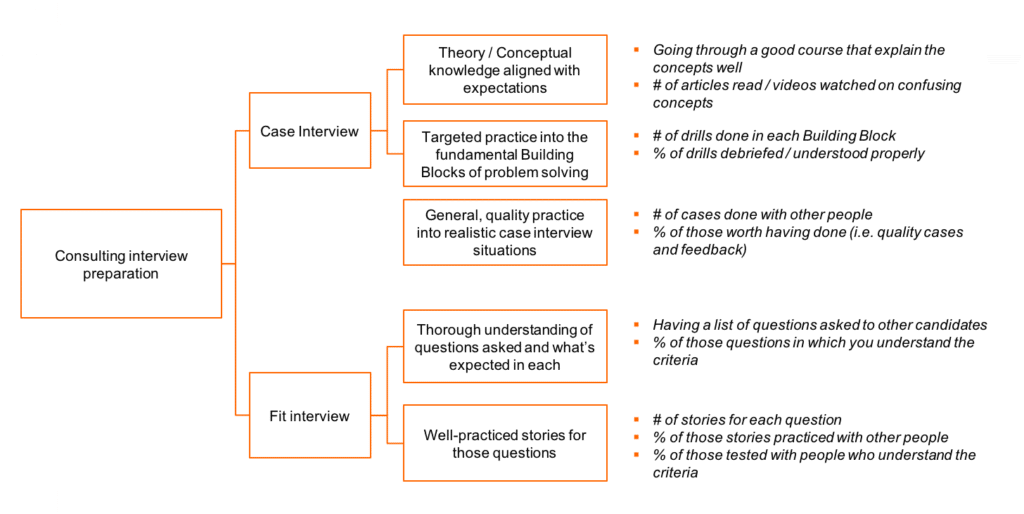
Each bullet point could be a KPI. Some of these are numbers to track, others are Yes/No KPIs.
I am not saying nor implying every candidate should use all these KPIs to prepare, but notice how nuanced you can get when you use a MECE Issue Tree to create KPIs.
Most candidates just track the # of cases they did, without even caring for the quality of those.
No wonder why most get rejected.
It’s like a company that just tracks how many products it has sold without concerning about margins, customer retention rates, customer satisfaction, quality control and so on.
You can get any Issue Tree from this article and transform it into a list of KPIs to track within each important bucket.
There’s certainly an art on which ones are better to track (because you don’t want to end up with 35 different KPIs) but just generating them out of a MECE Issue Tree allows you to have at least one indicator to every important part of the problem, leaving no blind spots in your master dashboard.
What's next?
Issue Trees are one, but not the only tool MBB consultants use to solve their client’s problems.
There are actually 6 types of questions interviewers ask in case interviews, to test on the 6 most important tasks consultants perform in real client work.
You can learn about those questions and the specific tools, techniques and strategies management consultants from McKinsey, BCG and Bain use to solve business problems by joining our free course on case interviews!

By joining our course, you’ll get access to:
- Step-by-step methods to solve the 6 (and only six) types of questions you can get in case interviews
- The “Landscape Technique” to create conceptual frameworks from scratch (this is the technique you need when Issue Trees fail to help you)
- Tons of practice drills so you can apply your knowledge
Liked the guide? Share it!
Resources >
Mckinsey approach to problem solving.
McKinsey and Company is recognized for its rigorous approach to problem solving. They train their consultants on their seven-step process that anyone can learn.
This resource guides you through that process, largely informed by the McKinsey Staff Paper 66. It also includes a PowerPoint Toolkit with slide templates of each step of the process that you can download and customize for your own use.
You can click any section to go directly there:
Overview of the McKinsey Approach to Problem Solving
Problem solving process.
- Problem Definition & Problem Statement Worksheet
Stakeholder Analysis Worksheet
Hypothesis trees, issue trees, analyses and workplan, synthesize findings, craft recommendations, distinctiveness practices, harness the power of collaboration, sources and additional reading, download the umbrex toolkit on the mckinsey approach to problem solving.
Problem solving — finding the optimal solution to a given business opportunity or challenge — is the very heart of how consultants create client impact, and considered the most important skill for success at McKinsey.
The characteristic “McKinsey method” of problem solving is a structured, inductive approach that can be used to solve any problem. Using this standardized process saves us from reinventing the problem-solving wheel, and allows for greater focus on distinctiveness in the solution. Every new McKinsey associate must learn this method on his or her first day with the firm.
There are four fundamental disciplines of the McKinsey method:
1. Problem definition
A thorough understanding and crisp definition of the problem.
2. The problem-solving process
Structuring the problem, prioritizing the issues, planning analyses, conducting analyses, synthesizing findings, and developing recommendations.
3. Distinctiveness practices
Constructing alternative perspectives; identifying relationships; distilling the essence of an issue, analysis, or recommendation; and staying ahead of others in the problem-solving process.
4. Collaboratio n
Actively seeking out client, customer, and supplier perspectives, as well as internal and external expert insight and knowledge.
Once the problem has been defined, the problem-solving process proceeds with a series of steps:
- Structure the problem
- Prioritize the issues
- Plan analyses
- Conduct analyses
- Synthesize findings
- Develop recommendations
Not all problems require strict adherence to the process. Some steps may be truncated, such as when specific knowledge or analogies from other industries make it possible to construct hypotheses and associated workplans earlier than their formal place in the process. Nonetheless, it remains important to be capable of executing every step in the basic process.
When confronted with a new and complex problem, this process establishes a path to defining and disaggregating the problem in a way that will allow the team to move to a solution. The process also ensures nothing is missed and concentrates efforts on the highest-impact areas. Adhering to the process gives the client clear steps to follow, building confidence, credibility, and long-term capability.
Problem Definition & Problem Statement Worksheet
The most important step in your entire project is to first carefully define the problem. The problem definition will serve the guide all of the team’s work, so it is critical to ensure that all key stakeholders agree that it is the right problem to be solving.
Problem Statement Worksheet
This is a helpful tool to use to clearly define the problem. There are often dozens of issues that a team could focus on, and it is often not obvious how to define the problem. In any real-life situation, there are many possible problem statements. Your choice of problem statement will serve to constrain the range of possible solutions.
- Use a question . The problem statement should be phrased as a question, such that the answer will be the solution. Make the question SMART: specific, measurable, action-oriented, relevant, and time-bound. Example: “How can XYZ Bank close the $100 million profitability gap in two years?”
- Context . What are the internal and external situations and complications facing the client, such as industry trends, relative position within the industry, capability gaps, financial flexibility, and so on?
- Success criteria . Understand how the client and the team define success and failure. In addition to any quantitative measures identified in the basic question, identify other important quantitative or qualitative measures of success, including timing of impact, visibility of improvement, client capability building required, necessary mindset shifts, and so on.
- Scope and constraints . Scope most commonly covers the markets or segments of interest, whereas constraints govern restrictions on the nature of solutions within those markets or segments.
- Stakeholders . Explore who really makes the decisions — who decides, who can help, and who can block.
- Key sources of insight . What best-practice expertise, knowledge, and engagement approaches already exist? What knowledge from the client, suppliers, and customers needs to be accessed? Be as specific as possible: who, what, when, how, and why.
The problem definition should not be vague, without clear measures of success. Rather, it should be a SMART definition:
- Action-oriented
Example situation – A family on Friday evening
Scenario: A mother, a father, and their two teenage children have all arrived home on a Friday at 6 p.m. The family has not prepared dinner for Friday evening. The daughter has lacrosse practice on Saturday and an essay to write for English class due on Monday. The son has theatre rehearsal on both Saturday and Sunday and will need one parent to drive him to the high school both days, though he can get a ride home with a friend. The family dog, a poodle, must be taken to the groomer on Saturday morning. The mother will need to spend time this weekend working on assignments for her finance class she is taking as part of her Executive MBA. The father plans to go on a 100-mile bike ride, which he can do either Saturday or Sunday. The family has two cars, but one is at the body shop. They are trying to save money to pay for an addition to their house.
What is the problem definition?
A statement of facts does not focus the problem solving:
It is 6 p.m. The family has not made plans for dinner, and they are hungry.
A question guides the team towards a solution:
1. What should the family do for dinner on Friday night?
2. Should the family cook dinner or order delivery?
3. What should the family cook for dinner?
4. What should the family cook for dinner that will not require spending more than $40 on groceries?
5. To cook dinner, what do they need to pick up from the supermarket?
6. How can the family prepare dinner within the next hour using ingredients they already have in the house?
In completing the Problem Statement Worksheet, you are prompted to define the key stakeholders.
As you become involved in the problem-solving process, you should expand the question of key stakeholders to include what the team wants from them and what they want from the team, their values and motivations (helpful and unhelpful), and the communications mechanisms that will be most effective for each of them.
Using the Stakeholder Analysis Worksheet allows you to comprehensively identify:
- Stakeholders
- What you need from them
- Where they are
- What they need from you
The two most helpful techniques for rigorously structuring any problem are hypothesis trees and issue trees. Each of these techniques disaggregates the primary question into a cascade of issues or hypotheses that, when addressed, will together answer the primary question.
A hypothesis tree might break down the same question into two or more hypotheses.
Example: Alpha Manufacturing, Inc.
Problem Statement: How can Alpha increase EBITDA by $13M (to $50M) by 2025?
The hypotheses might be:
- Alpha can add $125M revenues by expanding to new customers, adding $8M of EBITDA
- Alpha can reduce costs to improve EBITDA by $5M
These hypotheses will be further disaggregated into subsidiary hypotheses at the next level of the tree.
The aim at this stage is to structure the problem into discrete, mutually exclusive pieces that are small enough to yield to analysis and that, taken together, are collectively exhaustive.
Articulating the problem as hypotheses, rather than issues, is the preferred approach because it leads to a more focused analysis of the problem. Questions to ask include:
- Is it testable – can you prove or disprove it?
- It is open to debate? If it cannot be wrong, it is simply a statement of fact and unlikely to produce keen insight.
- If you reversed your hypothesis – literally, hypothesized that the exact opposite were true – would you care about the difference it would make to your overall logic?
- If you shared your hypothesis with the CEO, would it sound naive or obvious?
- Does it point directly to an action or actions that the client might take?
Quickly developing a powerful hypothesis tree enables us to develop solutions more rapidly that will have real impact. This can sometimes seem premature to clients, who might find the “solution” reached too quickly and want to see the analysis behind it.
Take care to explain the approach (most important, that a hypothesis is not an answer) and its benefits (that a good hypothesis is the basis of a proven means of successful problem solving and avoids “boiling the ocean”).
Often, the team has insufficient knowledge to build a complete hypothesis tree at the start of an engagement. In these cases, it is best to begin by structuring the problem using an issue tree.
An issue tree is best set out as a series of open questions in sentence form. For example, “How can the client minimize its tax burden?” is more useful than “Tax.” Open questions – those that begin with what, how, or why– produce deeper insights than closed ones. In some cases, an issue tree can be sharpened by toggling between issue and hypothesis – working forward from an issue to identify the hypothesis, and back from the hypothesis to sharpen the relevant open question.
Once the problem has been structured, the next step is to prioritize the issues or hypotheses on which the team will focus its work. When prioritizing, it is common to use a two-by-two matrix – e.g., a matrix featuring “impact” and “ease of impact” as the two axes.
Applying some of these prioritization criteria will knock out portions of the issue tree altogether. Consider testing the issues against them all, albeit quickly, to help drive the prioritization process.
Once the criteria are defined, prioritizing should be straightforward: Simply map the issues to the framework and focus on those that score highest against the criteria.
As the team conducts analysis and learns more about the problem and the potential solution, make sure to revisit the prioritization matrix so as to remain focused on the highest-priority issues.
The issues might be:
- How can Alpha increase revenue?
- How can Alpha reduce cost?
Each of these issues is then further broken down into deeper insights to solutions.
If the prioritization has been carried out effectively, the team will have clarified the key issues or hypotheses that must be subjected to analysis. The aim of these analyses is to prove the hypotheses true or false, or to develop useful perspectives on each key issue. Now the task is to design an effective and efficient workplan for conducting the analyses.
Transforming the prioritized problem structure into a workplan involves two main tasks:
- Define the blocks of work that need to be undertaken. Articulate as clearly as possible the desired end products and the analysis necessary to produce them, and estimate the resources and time required.
- Sequence the work blocks in a way that matches the available resources to the need to deliver against key engagement milestones (e.g., important meetings, progress reviews), as well as to the overall pacing of the engagement (i.e., weekly or twice-weekly meetings, and so on).
A good workplan will detail the following for each issue or hypothesis: analyses, end products, sources, and timing and responsibility. Developing the workplan takes time; doing it well requires working through the definition of each element of the workplan in a rigorous and methodical fashion.
This is the most difficult element of the problem-solving process. After a period of being immersed in the details, it is crucial to step back and distinguish the important from the merely interesting. Distinctive problem solvers seek the essence of the story that will underpin a crisp recommendation for action.
Although synthesis appears, formally speaking, as the penultimate step in the process, it should happen throughout. Ideally, after you have made almost any analytical progress, you should attempt to articulate the “Day 1” or “Week 1” answer. Continue to synthesize as you go along. This will remind the team of the question you are trying to answer, assist prioritization, highlight the logical links of the emerging solution, and ensure that you have a story ready to articulate at all times during the study.
McKinsey’s primary tool for synthesizing is the pyramid principle. Essentially, this principle asserts that every synthesis should explain a single concept, per the “governing thought.” The supporting ideas in the synthesis form a thought hierarchy proceeding in a logical structure from the most detailed facts to the governing thought, ruthlessly excluding the interesting but irrelevant.
While this hierarchy can be laid out as a tree (like with issue and hypothesis trees), the best problem solvers capture it by creating dot-dash storylines — the Pyramid Structure for Grouping Arguments.
Pyramid Structure for Grouping Arguments
- Focus on action. Articulate the thoughts at each level of the pyramid as declarative sentences, not as topics. For example, “expansion” is a topic; “We need to expand into the European market” is a declarative sentence.
- Use storylines. PowerPoint is poor at highlighting logical connections, therefore is not a good tool for synthesis. A storyline will clarify elements that may be ambiguous in the PowerPoint presentation.
- Keep the emerging storyline visible. Many teams find that posting the storyline or story- board on the team-room wall helps keep the thinking focused. It also helps in bringing the client along.
- Use the situation-complication-resolution structure. The situation is the reason there is action to be taken. The com- plication is why the situation needs thinking through – typically an industry or client challenge. The resolution is the answer.
- Down the pyramid: does each governing thought pose a single question that is answered completely by the group of boxes below it?
- Across: is each level within the pyramid MECE?
- Up: does each group of boxes, taken together, provide one answer – one “so what?” – that is essentially the governing thought above it?
- Test the solution. What would it mean if your hypotheses all came true?
Three Horizons of Engagement Planning
It’s useful to match the workplan to three horizons:
- What is expected at the end of the engagement
- What is expected at key progress reviews
- What is due at daily and/or weekly team meetings
The detail in the workplan will typically be greater for the near term (the next week) than for the long term (the study horizon), especially early in a new engagement when considerable ambiguity about the end state remains.
It is at this point that we address the client’s questions: “What do I do, and how do I do it?” This means not offering actionable recommendations, along with a plan and client commitment for implementation.
The essence of this step is to translate the overall solution into the actions required to deliver sustained impact. A pragmatic action plan should include:
- Relevant initiatives, along with a clear sequence, timing, and mapping of activities required
- Clear owners for each initiative
- Key success factors and the challenges involved in delivering on the initiatives
Crucial questions to ask as you build recommendations for organizational change are:
- Does each person who needs to change (from the CEO to the front line) understand what he or she needs to change and why, and is he or she committed to it?
- Are key leaders and role models throughout the organization personally committed to behaving differently?
- Has the client set in place the necessary formal mechanisms to reinforce the desired change?
- Does the client have the skills and confidence to behave in the desired new way?
Great problem solvers identify unique disruptions and discontinuities, novel insights, and step-out opportunities that lead to truly distinctive impact. This is done by applying a number of practices throughout the problem-solving process to help develop these insights.
Expand: Construct multiple perspectives
Identifying alternative ways of looking at the problem expands the range of possibilities, opens you up to innovative ideas, and allows you to formulate more powerful hypotheses. Questions that help here include:
- What changes if I think from the perspective of a customer, or a supplier, or a frontline employee, or a competitor?
- How have other industries viewed and addressed this same problem?
- What would it mean if the client sought to run the company like a low-cost airline or a cosmetics manufacturer?
Link: Identify relationships
Strong problem solvers discern connections and recognize patterns in two different ways:
- They seek out the ways in which different problem elements – issues, hypotheses, analyses, work elements, findings, answers, and recommendations – relate to one another.
- They use these relationships throughout the basic problem-solving process to identify efficient problem-solving approaches, novel solutions, and more powerful syntheses.
Distill: Find the essence
Cutting through complexity to identify the heart of the problem and its solution is a critical skill.
- Identify the critical problem elements. Are there some issues, approaches, or options that can be eliminated completely because they won’t make a significant difference to the solution?
- Consider how complex the different elements are and how long it will take to complete them. Wherever possible, quickly advance simpler parts of the problem that can inform more complex or time-consuming elements.
Lead: Stay ahead/step back
Without getting ahead of the client, you cannot be distinctive. Paradoxically, to get ahead – and stay ahead – it is often necessary to step back from the problem to validate or revalidate the approach and the solution.
- Spend time thinking one or more steps ahead of the client and team.
- Constantly check and challenge the rigor of the underlying data and analysis.
- Stress-test the whole emerging recommendation
- Challenge the solution against a set of hurdles. Does it satisfy the criteria for success as set out on the Problem Statement Worksheet?
No matter how skilled, knowledgeable, or experienced you are, you will never create the most distinctive solution on your own. The best problem solvers know how to leverage the power of their team, clients, the Firm, and outside parties. Seeking the right expertise at the right time, and leveraging it in the right way, are ultimately how we bring distinctiveness to our work, how we maximize efficiency, and how we learn.
When solving a problem, it is important to ask, “Have I accessed all the sources of insight that are available?” Here are the sources you should consider:
- Your core team
- The client’s suppliers and customers
- Internal experts and knowledge
- External sources of knowledge
- Communications specialists
The key here is to think open, not closed. Opening up to varied sources of data and perspectives furthers our mission to develop truly innovative and distinctive solutions for our clients.
- McKinsey Staff Paper 66 — not published by McKinsey but possibly found through an internet search
- The McKinsey Way , 1999, by Ethan M. Rasiel
For consultants
© Copyright 2023 by Umbrex
Designed by our friends at Filez
- Privacy Policy
- Terms of Service
"The McKinsey Way" Book: A Comprehensive Summary
The McKinsey Way is a book by Ethan M. Rasiel , published in 1999, about what McKinsey&Company does, how McKinsey organizes and what working at McKinsey is like.
20 years after publication, the book still holds significant value, offering timeless insights into the world’s most prestigious management consulting firm: McKinsey&Company. In this article, we’ll provide a detailed summary of all the lessons and insights from The McKinsey way . We’ll re-organize the content and occasionally insert supporting insights to make it more friendly to the reader.
The McKinsey Way has 5 Parts (Sections) with 180 pages:
- Part 1: The Problem Solving Methodology of McKinsey
Part 2: Logistics of how a McKinsey project works
Part 3: insights into the actual works of consultants, part 4: how to excel as a junior consultant, part 5: exit opportunities and life after mckinsey.
Table of Contents
Part 1: The McKinsey problem-solving methodology
The McKinsey problem-solving process can be summarized in the 5 steps: define the problems, find the root cause, use “hypothesis-driven” process, analyze with “issue tree” and propose solutions.
1. Define the problem: Every consulting project revolves around a “problem”. But the “problem” is NOT always the problem!
One symptom may have different causes and we as doctors should never rely on the patient to diagnose.
So, always dig deeper. Get facts. Asks questions. Poke around. Challenge the client… until you find the real problem.
2. Find the root cause: Don’t jump straight to the solution, because you might just be fixing the symptoms. The problem will come back if the root cause is not properly dealt with.
3. Use “hypothesis-driven” process: Make educated guesses of possible root-cause A B C and test with data (a.k.a: facts). We’ll sometimes call this a fact-based process.
4. Break down and structure the analysis with the “ issue tree ” framework: A “hypothesis-driven” process may take forever as there are millions of possible root-causes. We need to test hypotheses from the top to the bottom of the issue tree – a top-down fashion. These issue trees need to be MECE.
5. Propose solutions: When the root causes are identified, consultants propose solutions targeting them directly.
A few notes when using this methodology
No.1: Don’t force the facts to say what you want.
When you propose or work extensively with a running hypothesis , it’s easy to get emotionally attached and turn the problem-solving process into a proving exercise. So keep an open mind and listen to what the data have to say.
No.2: Let the hypothesis come to you naturally.
You will not be able to form an initial hypothesis every time. The clients may not even know their problems. The scope of the project is often large and vague. So, dive in, gather facts, conduct analyses, and the hypotheses will show themselves.
No.3: Don’t reinvent the wheel.
Business problems often resemble each other more than they differ. With suitable techniques, you can apply what you and the firm learned from other projects. After all, one of the values consulting firms bring is to provide the “best practice” – what the top players in the game are doing
No.4: Make sure your solution fits your client.
The most brilliant solution is useless without proper implementation. So know your client’s weaknesses, strengths, and capabilities and tailor your solutions accordingly.
No.5: Be mindful of politics.
There are always politics in projects. Many times, McKinsey gets involved in fights between corporate factions. This creates friction that prevents you from doing your job (late data; rejected interviews, etc.).
So think about how your solutions affect the players in an organization and always build a consensus along the way. If consensus requires you to change your solution, try to compromise. It’s no good devising the ideal solution if the client refuses to accept it.
It’s highly recommended that you refer to the following video for a general view on how McKinsey organizes and a better understanding of the insights from this part.
There is a whole system behind how McKinsey solve a business problem. In this part of The McKinsey Way, Ethan Rasiel describes how the company sells their projects, builds a team and manages its hierarchy.
Selling a study/project
McKinsey typically does not sell. The firm does marketing through a constant stream of books, articles, and scholarly journals like the McKinsey Quarterly, etc. The Firm also invites organize press releases and generates quite some coverage by journalists.
These publications help McKinsey Partners build and nurture a vast network of informal contacts with potential clients. And when a problem arises, the client knows who to contact.
Assembling a team
Almost all projects need a full-time team of consultants. Typically, the process goes like this:
- The ED (a.k.a: Project Owner) signs a contract with the client
- The ED hires an EM from within the McKinsey network, from any offices (a.k.a: Project CEO)
- The EM then hires a group of staff, consisting of BAs (a.k.a: Business Analyst) and Associates.
It’s solely the EM’s responsibility to keep the team happy and functional. McKinsey projects have a few common practices to do so:
- A monthly “team-bonding”.
- A “team temperature” (a.k.a: morale) weekly survey.
The hierarchy
The chain of command in McKinsey is very clear and strict. So is the responsibility funnel. In the ED’s eyes, the EM is responsible for everything in the project. In the EM eyes, the BA is responsible for everything within the assigned workstream. Even when a BA messes things up, to the ED, it’s not the BA’s fault, but the EM.
To provide the best solution for the clients, consultants need tons of skills in preparing presentations; conducting researchs and interviews; presenting the final products in a simple structure; communicating with clients; and brainstorming.
Making presentations, a.k.a: the final deliverable documents
Most consultants spend a big portion of their time making presentations (often in PowerPoint). Utilize the support team! Keep it structured, from top to bottom, from end to end.
Note that there are diminishing marginal returns to your effort, meaning that the last miles toward perfection are always much harder than the beginning. So, resist the temptation to tweak your presentation at the last minute. Try to assess its gains vs those of a good night’s sleep for you and the supporting cast.
Visualizing data with charts and exhibits
We subconsciously admire the people who talk in sophisticated language, so we make complex charts. However, simple and easy-to-follow charts go a long way in consulting. Charts are just a means of getting your messages across, not a Ph.D. project.
Also, don’t forget to:
- Write clear chart titles
- List out units of measurement in all axes
- Mark legends and side notes
- Provide data sources
Managing internal communications
- Over-communication is always better. Keep that information flowing. Make sure that your team is up to date with at least the broad outlines of your workstream and your boss up to date with your team’s progress. There are many channels for this: email, voicemail, messaging, small talks during cigarette breaks, meetings, etc.
- Keep your communication brief, yet comprehensive and structured.
- Look over your shoulder – always. You never know who is listening. Remember that your client’s confidentiality is a must.

Working with clients
This is a big one as the true hierarchy at McKinsey is “Client -> Firm -> and then You”. The client is your biggest boss.
There are many tips on client management, but the general principle is to bring the client to your side. You never win by opposing the client. Remind them about mutual benefits. Do it everyday!
Some of the client members can be “liabilities”. There are 2 types of them:
- the merely “useless”.
- the hostile ones.
With both types, the number 1 option is to subtly trade them out of your realm. When that is not possible, the next best option is to play ignorant. Leak out information only with the right “secret audience”.
No matter what, engage the client members in the process. The more they feel everybody is on the same boat, the more they would support you.
You should also get buy-ins throughout the organization along the process. Every important party has to agree with you. Ideally, the final document has already been discussed many times through many rounds with the client before the official presentation.
Doing research
Don’t reinvent the wheel! Whatever you are doing, chances are that someone, somewhere has done something similar. Building upon someone’s work is the best way to save time and energy while achieving the highest standard.
Besides, here are some research tips:
- Start with the annual report. All public companies have them available on their website.
- Look for abnormal patterns (things that are especially good or bad). That’s where all the insights lie.
- Last but not least, look for the best practice. Find out what the best performers in the field are doing and learn from them.
Conducting interviews
This is one of the most effective ways to gather qualitative facts during a project. You will find yourself interviewing multiple industry and function experts as well as key client leaders.
Here are a few tips:
- Be prepared. Know exactly what you want to get out of it. Know as much as you can about the interviewee. Writing an interview brief for yourself is not a bad idea.
- If possible, have the interviewee’s boss set up the meeting.
- Start with some general and open-ended questions then move on to specific ones. Let the content flow naturally.
- Sometimes, it’s useful to use the indirect style. Take time to make the interviewee comfortable with you and the interview process.
- Include some questions you know the answer to. This gives insights into the interviewee’s style, knowledge, and honesty.
- Don’t ask too much. Focus on what you really need (what you prioritize in the interview brief).
- Listen and let the interviewee know you are doing so.
- Paraphrase what you hear in your own words. Confirm whether you understand correctly. This also gives chances for the interviewee to add or amplify important points.
- Near the end, use this last trick to flush out any possible missing insights: “Is there anything else you would like to tell or any question I forgot to ask…?”.
- Adopt the Columbo tactic. Wait until a day or two passes, then drop by the interviewee’s office. “I was just passing by and remembered a question I forgot to ask”. This is a less threatening way to keep the conversation going.
- Lastly, always write a thank-you note. A short and sincerely one always does the work.
Brainstorming at McKinsey
In McKinsey, we often use the word “Problem-Solving” interchangeably with brainstorming sessions. It’s a very topic-focus meeting within the McKinsey team, consisting of the consultant in-charge, the EM, and sometimes even the ED and experts.
Before the session, prepare in advance as much supporting data as possible. It will come handy in the process.Inside the White room: Start with tabula rasa — a clean slate. When you get your team into the room, leave your preconceptions at the door. Bring in only the facts, and find new ways of looking at them.
Management consulting is an interesting yet challenging job. To survive and thrive at McKinsey, here are some advices for you:
Tip 1: Find your own mentor
At McKinsey, every consultant is officially assigned a mentor, who may not be in the same office. How much you benefit from the official mentor is pretty much a matter of luck. If you want great guidance, you have to go out and get your own. Get a few too, don’t stick to just one.
Tip 2: Survive the road
Business travel can be exhausting and difficult, here are some note you can take to deal with it:
- Look at business travel as an adventure.
- Do proper planning. These simple logistics can make a big difference
- Treat everyone with tremendous respect

Tip 3: Have a list of items to bring when traveling
Here is the list:
- Clothing: extra shirts or blouses, spare ties, spare shoes, casual clothes, cashmere sweaters
- Tools: writing pad, copy of whatever you send to the client, calculator
- Personal care Items
- Things to keep you organized and in touch
Tip 4: Treat your assistant well
Having a good assistant is a lifeline. Treat them well. Be clear about what you want. Give them room to grow. Take time to train them well. Answering their questions and showing them the ropes.
Tip 5: Have boundaries to keep your life balance
Since you have a large amount of work to cover as a consultant, there is almost no work-life balance. However, if you want a life, lay down some rules. For example:
- Make one day a week to be completely free of work, both physically and mentally. Tell your boss about it! He/she will respect it. And so should you.
- Don’t take work home. When you are home, you are home!
- Plan long ahead, especially when you travel.

Tip 6: The 80 / 20 Rule
80% of the wealth is owned by just 20% of the population. 80% of the output can be produced by 20% of the effort. 20% of the problems can cause 80% of the trouble.
So if you wanna save time and effort. Always try to find those 20% and act upon them!
Tip 7: Don’t try to analyze everything
If you don’t take shortcuts, there is simply too much to do. Be selective. Find the key drivers. Focus on the core problem, then apply analysis. This helps avoid going down blind alleys and boiling the ocean.
Tip 8: The Elevator Test
Concise communication is crucial in consulting. Anytime the EM asks you for your workstream status, you have to be able to give him a 30 seconds summary. Short yet insightful. This skill takes practice. Try doing it every day in various contexts!
Tip 9: Pluck the Low-Hanging Fruit
Solving only part of the problem can still mean increased profits. Those little wins help you and your customers. Try to see such opportunities and grab them first.
Tip 10: Hit singles
Get your job and only your job done, don’t try to do the work of the whole team.
It’s impossible to do everything yourself all the time. Even if you manage to pull it off once, you raise unrealistic expectations and once you fail, it is difficult to get back credibility.
Tip 11: Look at the big picture
When you are feeling swamped, take a step back, figure out what you are trying to achieve, and then look at what you are doing. “Does this really matter?”
Probably not! All of these troubles will go away!

Tip 12: Just say “I don’t know”
The firm pounds the concept of professional integrity: Honesty. If you don’t know something, just say “I DON’T KNOW” in an empowering fashion. Admitting that is a lot less costly than bluffing.
“Leaving McKinsey is never a question of whether—it’s a question of when”
There are not many people who stay with McKinsey for their whole career life. In the last part of The McKinsey Way , Ethan Rasiel and other ex-McKinsey consultants share their valuable lessons and memories from working at the company.
- “Structure, structure, structure. MECE, MECE, MECE. Hypothesis-driven, Hypothesis-driven, Hypothesis-driven.” – Former associate in Dusseldorf and San Francisco offices
- “The quality of the people. In the corporate world, the average-caliber employee is far below McKinsey’s least intelligent.” – Wesley Sand
- “What stays with me is the rigorous standard of information and analysis, the proving and double-proving of every recommendation, combined with the high standard of communication both to clients and within the Firm.” – Former associate in the Boston and New York offices
- “When faced with an amorphous situation, apply structure to it.” – Kristin Asleson, New York office, 1990-93; now working in Silicon Valley
- “Execution and implementation are the key. A blue book is just a blue book, unless you do something with it. Getting things done is the most important thing.” – Former EM in the New York office
Among MBB firms, people tend to say McKinsey is slightly better than the other two in three factors: prestige, people, practices, and offices
At McKinsey, the salary for entry-level consultants ranges from $90,000 to $110,000/year, while the figure for experienced Associates can go up to $233,000
McKinsey hiring process including 3 phases: resume screening, PST test, and case interview. Each candidate will have to undergo 4-6 interviews during 4-8 weeks
Related product
/filters:quality(75)//case_thumb/1669802837683_mc_kinsey_comprehensive_bundle.png)
McKinsey Comprehensive Package
Unlock all materials helping you land the next job in McKinsey!
What is a hypothesis tree and how do you make one?
An essential productivity tool any business professional should have in their tool belt is the hypothesis tree.
Emily Branch
Problem-solving

One of the challenges of delivering presentations is creating visual aids that help your listeners understand in a more intuitive way.
Experienced presenters accumulate a repertoire of tools: word clouds, tree maps, issue trees, etc., but one essential tool any business professional should have in their tool belt is the hypothesis tree .
Hypothesis trees are useful visualizations for communicating different ideas, explanations, or theories about a central topic in a visually clear and logically cohesive way. This guide will teach you what a hypothesis tree is, when you should use one, and how you can create your own.
Key Takeaways:
- A hypothesis tree is a counterpart to an issue tree.
- Hypothesis trees are useful for visualizing a problem and conceptualizing solutions.
- Prezent helps companies put theory into practice in their presentations.
What is a hypothesis tree?
A hypothesis tree starts with the problem you’re trying to solve. From that central issue, a hypothesis tree visually connects various explanations (or hypotheses) to the issue in question. Each hypothesis can have its own sub-hypotheses and sub-sub-hypotheses in as much detail and variety as you need.
The key feature of a hypothesis tree is that it applies the scientific method to business scenarios. Each hypothesis is a falsifiable, testable explanation for the problem at hand, and by evaluating these individual branches with logical or practical tests, you gain greater insight into your company and your path forward.
Both visually and conceptually, hypothesis trees resemble issue trees . While issue trees start with a complex problem and break it down into simpler and simpler components, a hypothesis tree starts with a complex question and pursues simpler and simpler solutions. Because of that similarity, some businesspeople refer to issue trees as “diagnostic trees” and hypothesis trees as “solution trees.”

When should you use a hypothesis tree?
At some point in their life, everybody has experienced a presentation (in the workplace, school, online, etc.) that was so jam-packed with abbreviations, lingo, and convoluted analogies that they left feeling like they understood even less than they went in with.
When it comes to components of a presentation , a good rule of thumb for speakers is to use special tools when it makes things simpler, not when it makes things more complex.
This applies to special terminology, examples, and visual aids: the right visual aid should make your job easier, not harder. When it comes to presentations before you can persuade your audience to agree with you, you first have to make them understand what you’re trying to convey, and hypothesis trees are an easy and effective way to visually demonstrate solutions to an issue.
Not only are hypothesis trees helpful visual aids for increasing understanding, but they’re also useful tools for helping your audience conceptualize and test solutions. In the international bestseller, The McKinsey Mind , authors Ethan Rasiel and Paul N. Friga go as far as to claim that a hypothesis tree can solve a problem in a single meeting.
This is great news for presenters but also great news for your colleagues. You should use hypothesis trees to help your audience understand your topic and when they can help conceptualize and test solutions to a problem.
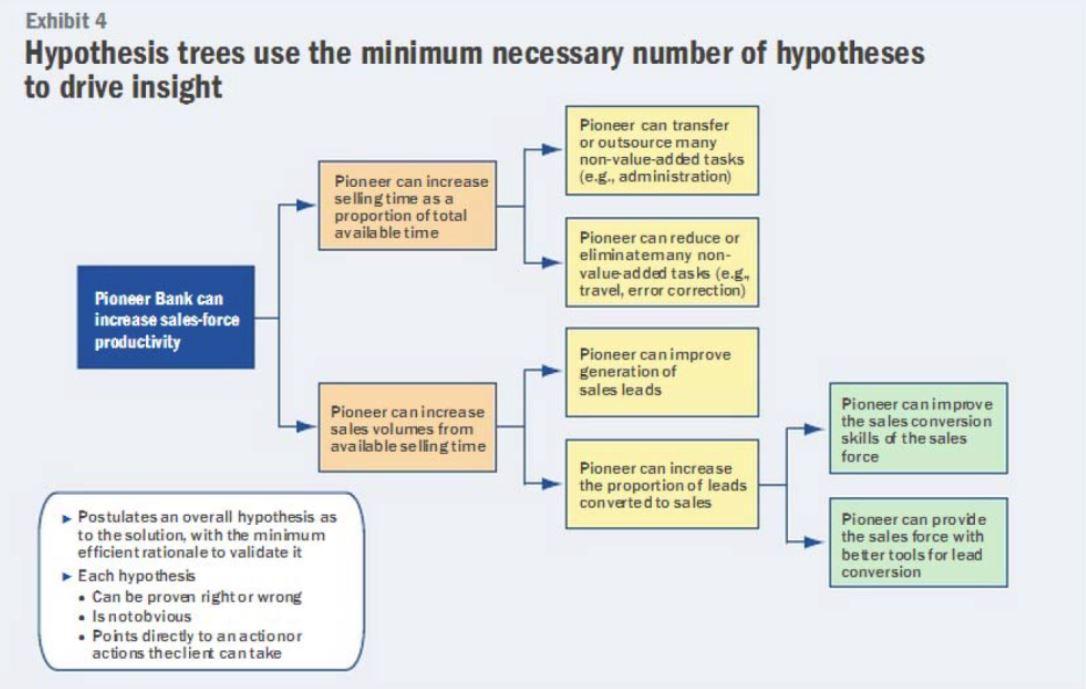
Putting ink to paper
As you’re preparing for a presentation , you’ll identify situations that call for a hypothesis tree. The first step to creating your tree is to identify the problem you are trying to solve and what a solution for that problem would look like.
For example, if your workplace has unusually high printer paper usage, your central issue may be, “We can lower our paper usage.” Take that central issue and put it in a box:

From there, consider possible hypotheses: What could lead to lowering paper usage? Is your company printing redundant documents? Are you using paperwork for things you already have digital records of? Consider all the solutions to your issue.
If you’re leading a meeting, it would be helpful to consider these solutions ahead of time and prepare them as part of your presentation.
But hypothesis trees are more than presentation tools. They’re valuable collaboration drivers.
At this point, you may prepare an answer ahead of time or collect feedback and brainstorm possible hypotheses as a collaborative activity.
Whether you prepare hypotheses yourself or collect ideas from the room, you can organize those theories either vertically or horizontally from your central issue, but for visual clarity, they should be in alignment with each other. For example:

In this hypothesis tree, there are two main hypotheses: we can implement more paperless storage , and we can reduce redundant documents. Crucially, both of these hypotheses are falsifiable, meaning that you can test their validity, and if they are false, you can prove them false.
How would you prove them false? By disproving their sub-hypotheses. For instance, to disprove the statement “we can lower our paper usage,” you would have to disprove both “we can implement more paperless storage” and “we can reduce redundant documents.”
To disprove “we can implement more paperless storage,” you would have to disprove both “we can store checklists digitally” and “we can create a paperless application process.”
In this way, hypothesis trees not only provide a framework for searching for potential solutions to a problem (too much paper usage) but also a way of testing those solutions.
Make the most of your presentations with Prezent
Humans have been telling stories since we developed the tools to paint on cave walls. Stories aren’t just the purview of fiction or entertainment. They’re essential for building relationships, making decisions, and conducting business.
As the Canadian Broadcasting Corporation puts it: “Storytelling is not just entertainment. It’s a fundamental part of being human.”
Storytelling belongs in business, and Prezent is on a mission to make presentations efficient, dynamic, collaborative, structured, and proficient.
To learn how Prezent can help, contact us to see how Prezent can work for you.
Get the latest from prezent community.
Join thousands of subscribers who receive our best practices on communication, storytelling, presentation design, and more. New tips weekly. (No spam, we promise!)

Issue Trees – What Are They and How Do You Use Them?
Issue trees are a useful approach to breaking down a problem statement into component parts that can more easily be acted upon. In consulting teams, it’s often done in the first couple of weeks of a project. It enables the team to structure the project in a way that people can be assigned to specific “workstreams” and that the team can align their hypotheses to make predictions about which elements might have the biggest impact.
I like the definition that McKinsey Mind uses for issue trees:
The issue tree, a species of logic tree in which each branch of the tree is an issue or question, bridges the gap between structure and hypothesis. Every issue generated by a framework will likely be reducible to sub issues, and these in turn may break down further. An issue tree is simply the laying out of issues and subissues into a MECE visual progression. By answering the questions in the issue tree, you can very quickly determine the validity of your hypothesis.
It’s a good definition but it’s also chock-full of jargon and we’re not a fan of jargon (or at least egregious uses of it) here are StrategyU The simplest way of thinking about an issue tree is as a way of breaking down a complex problem into many possible explanations of what is going wrong.
What Do They Look Like And How Do You Use Them ?
Issue trees are often created visually in PowerPoint but can also be in the form of financial models. The type of issue tree we are concerned about are the ones that help us structure our central problem or mission. For example, most companies are focused on increasing profitability. We might frame this “problem” in the form of a question, “Company profitability is declining, what are the ways to improve it?”
We can then start to brainstorm different ways that profitability might be increased. At the higher levels, you want to be as broad as possible such that you can break the tree down further and get more specific the deeper you go. You’ll also want to try to use MECE . Our initial issue tree might look like this:

From there we can go deeper. What are the different ways we can increase revenue. It’s best to just start listing ideas and then start thinking about how to synthesize them, organize them, and yes, make sure they are MECE!
You might develop the next leg of your tree:

This tree is not perfect and the answers at the lowest level are not collectively exhaustive for all the possibilities for increasing revenue and decreasing costs. However, for a specific company, these may be the relevant issues, meaning that they are the ones that you are able to invest money on, tweak and that might have a positive impact.
The next step is to develop analyses or experiments that you can perform to validate or quantify how much impact can be generated by focusing in each of these areas
How Issue Trees Are Linked With Problem Solving
At StrategyU we are fans of the SCQA process to define problems and develop hypotheses. This approach enables us to have a rigorous problem-solving approach to business problems instead of starting with the solution in mind from the beginning. This approach works best when you are open-minded and flexible. The first test of the issue tree is when you are doing the initial research and analysis after you structure the problem. This is step two of the consulting process :

At this point, you will likely get some quick feedback on your initial problem statement such as:
- Have we defined the problem appropriately or are there deeper issues?
- Have we identified the relevant issues and areas in which we can make a difference?
- What kind of initial tests have we done are are we designing to confirm if the issues and questions are right?
This is a frustrating, iterative process and within a consulting team, you are often revisiting the issue tree and problem statement over and over again throughout a project.
How To Use This In Your Company
You should have a good understanding of the “levers” that help your company continue to grow, increase its profitability, and improve over time. Spend long enough in any company and you start to realize that there are a narrow set of metrics everyone makes decisions around. Except unless you’ve mapped this out explicitly, there will likely be many different definitions and interpretations of what you are optimizing for.
Using a template like follows and coming up with the high-level issues and areas within the business you are focusing on can be clarifying. You can also add specific types of analyses and information that you use to help you solve or improve in these areas:

This can also be rolled out across your org chart. Let’s imagine a company realizes that it doesn’t have much room to lower costs anymore and it wants to focus exclusively on increasing revenue. They can do this in two ways (assuming they aren’t adding new products). They can increase the price per order or they can increase volume. They may when want to break this down into different sub-issues.

In reality, you’d want to collect a lot of data and verify that the way you are breaking things down is correct. The numbers often surprise companies. They realize that an area of focus (increasing # of customers, for example) is not as big of an impact on the bottom line as other areas.
The only way to figure this out is to map out all of the possibilities of your issues and then validate them with real data.
This is the same thing that consulting teams do when they work for companies.
In my course, Think Like A Strategy Consultant, you have to complete an issue tree for a case example featuring Facebook’s transition from desktop to mobile and I’ll walk you through the process step-by-step which also providing you feedback if you want. Learn more here .
Do you have a toolkit for business problem solving? I created Think Like a Strategy Consultant as an online course to make the tools of strategy consultants accessible to driven professionals, executives, and consultants. This course teaches you how to synthesize information into compelling insights, structure your information in ways that help you solve problems, and develop presentations that resonate at the C-Level. Click here to learn more or if you are interested in getting started now, enroll in the self-paced version ($497) or hands-on coaching version ($997). Both versions include lifetime access and all future updates.
Share this:
- Click to share on Facebook (Opens in new window)
- Click to share on LinkedIn (Opens in new window)
- Click to share on Twitter (Opens in new window)
- Click to share on Pocket (Opens in new window)
- Click to share on WhatsApp (Opens in new window)
Download Chapter
You will receive additional complimentary videos/ updates by email. To complete the process please click the link in the email we will send you.
Download Preview
Welcome back!
Or, sign in with your email
Don’t have an account? Subscribe now

Download The Strategy Journal
Using decision tree consulting to build mece hypotheses.

How To Use Decision Tree in Consulting to Build MECE Hypotheses
In today’s post, we will explain the steps to build hypotheses in a more effective, methodical, and, for a lack of a better word, a more MECE ( mutually exclusive and collectively exhaustive ) way, using a decision tree .
When we do cases with candidates, even our own clients, what always surprises us is how messy their hypotheses can be.
It’s almost as if people are just throwing out ideas they have without any real understanding of how to create a structure, with the help of a decision tree , to ensure the hypotheses derived from the structure are on point and MECE .
I think most people are primarily right-brain thinkers by nature. That means that they will throw out an idea first and then decide if it solves the problem they are trying to address. They are basically brainstorming in the traditional sense of the word, but in a very messy way without priorities and a link to the issue. This type of thinking can often lead to big breakthrough insights but it will not work during consulting case interviews or during consulting engagements as consultants are expected to think in a structured way.
And what I find with most hypotheses is that they are very ill-considered, they have poor structure beneath them and most importantly they are not collectively exhaustive nor are they mutually exclusive (MECE) .
And by their very nature hypotheses are difficult to make mutually exclusive or collectively exhaustive.
Think about it. You develop these ideas and then you have to explain why the problem exists, which is hard on its own. And then you have to compare each hypothesis with the next hypothesis you develop to make sure you have listed every possible hypothesis .
You also have to make sure the issue you covered in one hypothesis doesn’t overlap with another hypothesis . Trying to package issues into hypotheses while trying to get all the issues listed and in the right order is naturally going to be very difficult.
This is not something that is taught in MBA programs or any training programs that we know of outside of leading management consulting firms.
This video teaches this entire process below in great detail.
This additional video teaches comprehensive McKinsey hypotheses – based case interview approach. This is necessary to show the firm you can hit the ground running and add immediate value. Those interviewing for Deloitte S&O, Roland Berger, McKinsey Implementation, etc. are strongly advised to watch both videos.
Hypothesis Based Consulting vs. a Decision Tree Approach – Which approach Does MBB prefer?
Leading management consulting firms, whether it is BCG, McKinsey or Bain (collectively called MBB ), like hypothesis-based consulting . This is also called the answer -first approach. The answer being the hypothesis.
However, BCG tends to also accept the decision tree -leading-to- hypotheses approach to solving cases. We also have had candidates who interviewed at McKinsey and used a decision tree approach to solve the case and did well. They basically did not go into formal hypotheses .
The approach of using a decision tree is usually less appropriate at Bain where they tend to be quite frigid in wanting hypotheses upfront.
At McKinsey, it depends on how well you use the decision tree approach . If you use it poorly they would probably think you aren’t capable of developing hypotheses . That is why you avoided the hypotheses in the first place. And at BCG it is again like at McKinsey. They are not adamant they want hypotheses . They are okay with the decision tree approach as long as you use it effectively to arrive at the likely problem.
And in fact, if you use the decision tree approach very well, they generally would be very happy with the technique.
You can also avoid decision trees to build hypotheses , but I am yet to see anyone build neat and logical hypotheses without using a decision tree. Even corporate strategy partners we work with to develop our training do not do this.
An Effective Technique to Build Hypotheses Using a Decision Tree – The Best of Both Worlds
So what I want to talk you through today is a very effective technique we teach all of our clients in terms of how to build hypotheses that are MECE, by using a decision tree .
In our strategy training programs we teach, in-depth, how to go through the entire process from defining the issue, all the way through structuring the problem, developing hypotheses , building an analysis plan, conducting analyses, synthesizing and providing the recommendation. In The Consulting Offer training program (consulting case interview training program where we help real candidates get offers from top firms), we teach the part of this process applicable to case interviews .
We get a lot of questions about how to use this technique well and how to adopt it for case interviews with consulting firms so this post should provide some clarification.
The technique we teach candidates is to develop a key question upfront – define the problem (step one in the exhibit below). Then from your key question brainstorm out the sub-drivers of the key question, which gives you the first-level branches of your decision tree .
At a very high level, the strategy engagement structure can be simplified into 6 basic steps, keeping in mind that it is an iterative process (shown in the exhibit below). Structuring the problem (developing a decision tree ) fits within step 2 of this process and developing hypotheses fits within step 3, as shown in the diagram below.
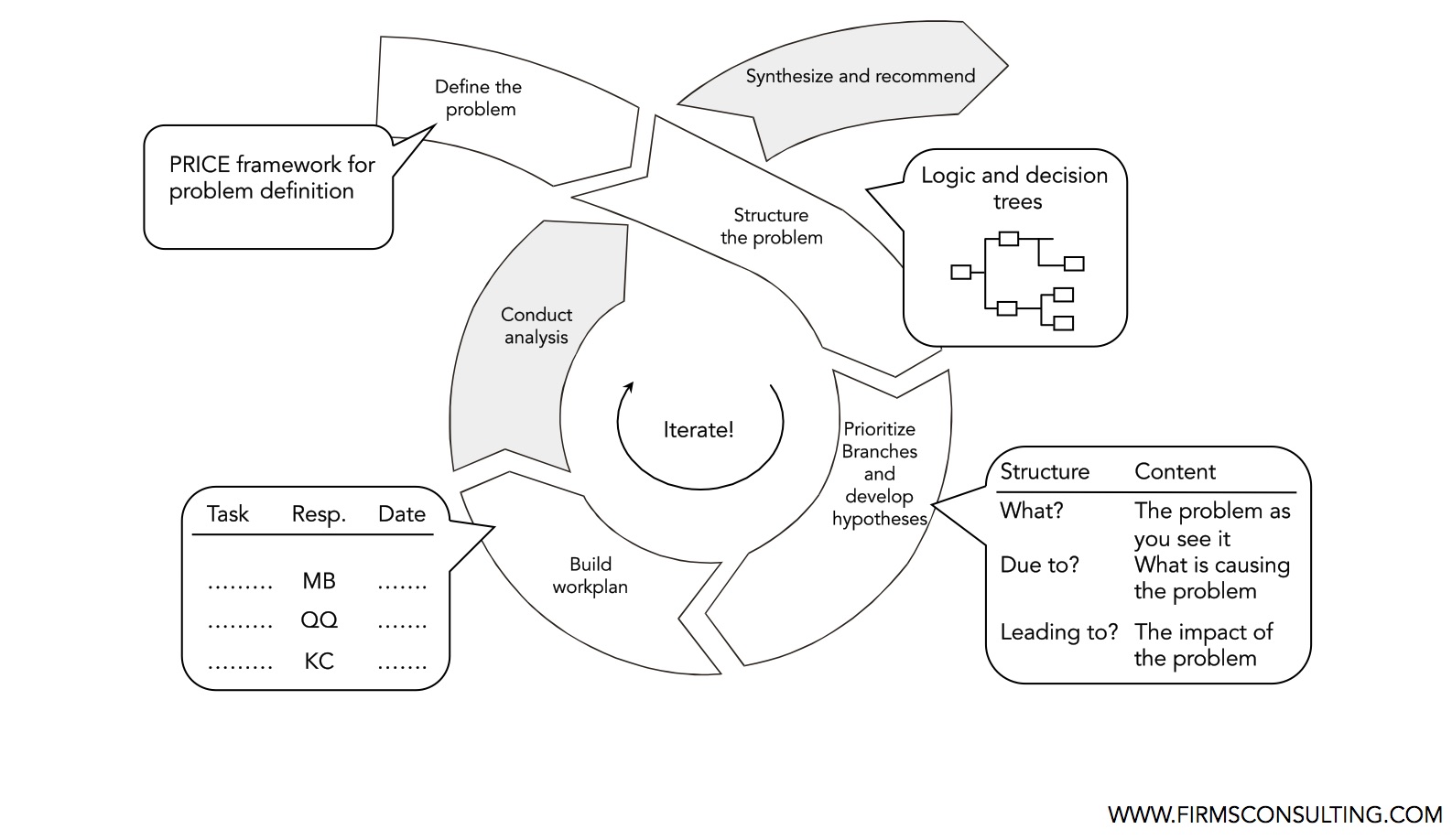
For each sub-driver/branch of the first level of the decision tree , brainstorm the drivers of that particular driver. This part of the approach is called structuring the problem or brainstorming (refer to step 2 in the exhibit above called structure the problem). Each level of drivers/ branches of the decision tree must be mutually exclusive and collectively exhaustive (MECE).
All the drivers/ branches are collectively called the framework/structure for the case.
Finally, when you complete the decision tree , the branches must be prioritized and hypotheses are developed ONLY for the prioritized branches . You can sometimes solve a case without hypotheses because the drivers are so specific and point out the problem. So, you only use hypotheses if the decision tree is not generating an answer quickly.
Hypotheses , for the prioritized branches /drivers, should be worded as follows:
- Event causing the observable phenomenon…
- Observable phenomenon…
- Event caused by an observable phenomenon…
An example of a properly structured hypothesis is below:
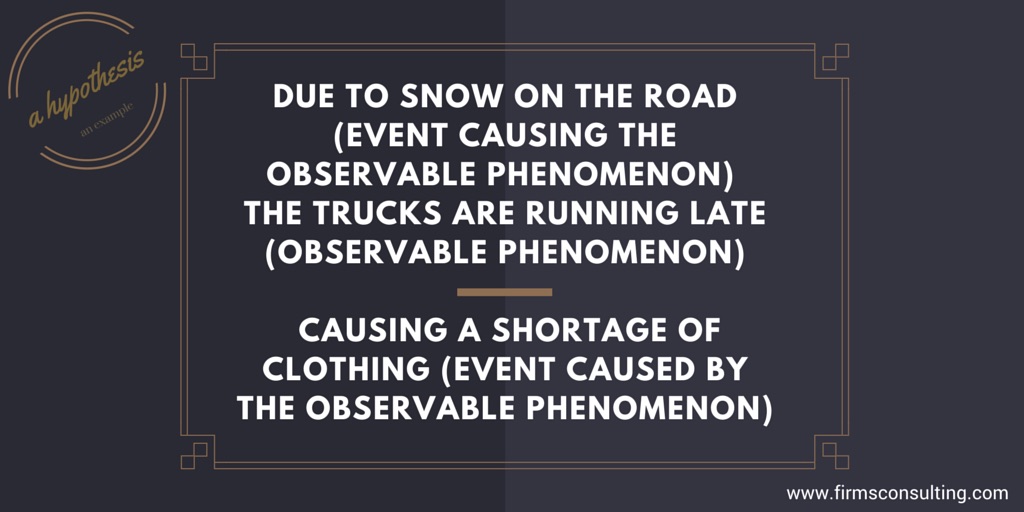
The development of decision trees and hypotheses are the core skills behind strategy consulting.
In an actual consulting study, the team comes up with analyses necessary to test the hypotheses when the hypotheses are developed. They then build the work plan, conduct the analyses, synthesize the findings, and present the final recommendation to the client.
All well-planned studies work this way. If you are in a study that does not follow this approach, you are almost certainly doing unnecessary analyses.
Let’s look at an example of applying the technique of developing hypotheses using a decision tree .
Let’s assume I gave you a case whereby I told you that a famous French restaurant, a single restaurant in downtown Manhattan, faced a steep drop in profits over the last three years. Their profitability went from something like $10,000 a day to about $1,000 – $2,000 a day and they think it has a lot to do with the changes in their opening times, the menu, the clientele they serve, and so on.
And most of all, they think the drop in profitability is driven primarily by the change in working hours. They went from being open during lunch and dinner to opening throughout the day from 10 am to 1 am. They want you to solve the case.
Help them address the problem. Maybe try to solve this case before reading the solution below.
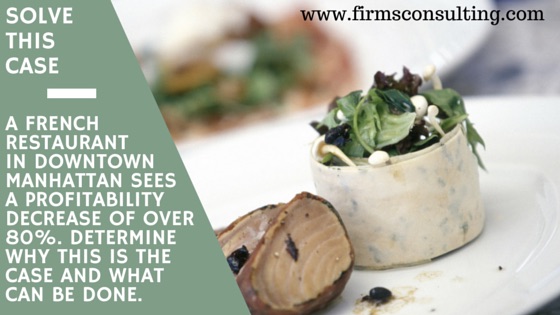
The way we would teach candidates to apply hypotheses with the decision tree approach is to start by taking some time to think about clarifying questions . Then come back once you’ve got your clarifying questions .
Now, you may have no clarifying questions , but if you do, always take some time to think about it.
A clarifying question is a question to understand the information provided to you. It is NOT to dig for more new information to solve the case. It is to understand what you have. If you ask clarifying questions to gain new information without understanding and using the information already provided, the interviewer will wonder what the value of providing you with new information is if you could not use the information initially offered.
You could ask the interviewer, “ Is it possible for me to go through my clarifying questions ? I have four of them and they could help me develop my structure. Or, would you prefer to see my structure upfront knowing full well that my clarifying questions , if answered, may change my structure a little bit .”
That is a good technique because it gives the interviewer an option with regards to which approach they prefer and the opportunity to guide you.
Let’s assume the interviewer said, “ It’s okay. Ask your clarifying questions . ”
You can go ahead. Ask no more than four. If you come up with additional questions during this discussion you can say, “ I asked the four but two more came up based on the conversation we had. ” Most of the time the interviewer will allow you to ask it. But don’t go into 7, 8, or 10 questions. Don’t try to solve the case. That is for later. You want to merely understand what you have been given.
The clarifying questions are not there to solve the case. They are used to identify the key question .
Then you would take the information from the clarifying questions and rephrase the initial problem statement to say, “ Okay, I’m going to paraphrase what you’ve given to me. We need to figure out how can a French restaurant located in downtown New York went from $1,000-$2,000 of profits to $10,000 of profits without altering its menu and without changing the cuisine it offers.”
Assume that not altering its menu and the cuisine it offers are the answers to the two of the clarifying questions . You then have to build in the information you received by asking clarifying questions.
Please do not present the key question without using the answers to your clarifying questions. If you did that, what would be the point of even asking clarifying questions ? They would be wasted since you are not using them to narrow down the problem statement.
Narrowing down the problem statement makes the case really easy to solve . Most candidates struggle in a case since they do not understand the problem statement.
It must be noted that Bain and McKinsey tend to have very clear problem statements and this step may not be needed. BCG tends to have broader questions so this step may be needed. In general, if the problem statement is vague, you want to narrow it down.
Next, you could say, “ What drives profitability? Well, clearly it would be revenue and cost . And what are the drivers of revenue and cost ? The drivers of revenue are different revenue streams. So it’s food, alcoholic beverages, and non-alcoholic beverages. It will also be the time of the day that the restaurant is open. The drivers of the cost will be fixed and variable cost. ”
What many candidates do is they would simply ask the clarifying questions upfront and throw in hypotheses . Don’t do that. Your hypotheses would be too vague at this point .
Develop your key question . Develop your decision tree to the second level of branches .
The first level of branches would be revenue minus cost . The second level of branches would be the drivers of revenue and the drivers of cost.
Once you have the drivers of revenue and the drivers of cost , you can develop a hypothesis for each prioritized branch you think is important to solve the case. Not all the branches will be important. Use your judgment and the information provided in the case to prioritize the branches .
Develop a hypothesis for the food revenue stream, the nonalcoholic beverage revenue stream, the alcoholic beverage revenue stream, and the hours when the restaurant is open. Then develop hypotheses for fixed cost and variable cost . That is, assuming you wanted to prioritize them all. You could just as easily have prioritized fewer branches .
Let’s go through some hypotheses . We would say, “ Since the restaurant is open longer hours, they may have alienated some clientele, attracted new clientele, and also incurred higher cost , which is not compensated by higher revenue. That is one hypothesis .
This steep drop in revenue is probably driven by the fact that there is a different clientele coming in which is demanding different prices .”
On the alcoholic beverage side we would come up with a similar hypothesis , and on the fixed as well as variable cost side.
“ Let’s look at the variable cost side. I would hypothesize that it is possible that although variable costs have decreased due to the drop in revenue, it has not decreased sufficiently to compensate for the drop in revenue.
On the fixed cost side, I would hypothesize that due to the longer operating hours, our fixed cost may have increased to carry the longer operating hours. ”
Notice how specific hypotheses for the sub-drivers are. They are more useful than throwing out drivers for revenue.
Your hypotheses don’t require all three parts as in the image above, but they MUST be tightly linked to the issue in that one branch . This prevents overlap with other branches .
If you build your hypotheses off the branches of the decision tree , you maximize your chances to build useful hypotheses because you will have to make sure that your decision tree is mutually exclusive and collectively exhaustive .
So if you build your hypotheses off your decision tree and if you did a thorough job, your hypotheses by default would be collectively exhaustive. And if your decision tree is mutually exclusive , your hypotheses would also be mutually exclusive .
And obviously, your hypotheses are dependent upon the information they have given you in the case and the clarifying information you have collected when you asked clarifying questions upfront.
This is an effective and simple technique to build hypotheses in a mutually exclusive and collectively exhaustive way. If you just throw hypotheses out without deriving them from a decision tree you will have no way of knowing whether they made sense or whether they are MECE.
Our clients are trained to do all of this in 60 – 120 seconds flat. That is pretty fast and would only work if you understand the process . This video teaches this entire process above in great detail.
This additional video teaches comprehensive McKinsey hypotheses based case interview approach. This is necessary to show the firm you can hit the ground running and add immediate value. Those interviewing for Deloitte S&O, Roland Berger, McKinsey Implementation, etc. are strongly advised to watch both videos.
How To Apply Hypotheses With The Decision Tree Technique At MBB
When you get to a McKinsey interview you follow the process above, but you don’t need to show the interviewer the entire process. That is key. With the McKinsey interviewer or Bain interviewer, you don’t tell them what your key question is, because for McKinsey and Bain the key question in the case is very obvious. The clarifying questions are largely redundant because they tend to give you the key question very clearly and upfront. Therefore, there is no reason to narrow it down or rephrase it.
The case is not conceptually difficult as, for example , a BCG case.
Therefore, for McKinsey and Bain, you build out your decision tree as we taught you above. Yet, you don’t discuss your key question , your clarifying questions , or your decision tree . What you do is you build your key question and your decision tree purely to help you develop a framework and then based on prioritized branches of your decision tree , develop hypotheses .
Therefore, just explain your hypotheses and very briefly how you created them.
To recap, in McKinsey and Bain interviews they are not going to see your key question . They may want to see your approach, but what you really want to show them is your hypotheses .
Setting Out The Alternatives
Problems result in several alternatives, and it is essential to think about these alternatives before tackling the issues. Setting out the alternatives is like simply stating the obvious. Also, acknowledging that specific facts and events can exist in a circumstance will assist in the problem-solving process when employing the decision tree approach.
For instance, a team head of an organization wants to hold a get-together at his home with his team members. It is the rainy season, and he is faced with uncertainty about the weather conditions. On the one hand, he wants to hold it on the lawn in the front of his home, so everyone can be comfortable and enjoy the fresh air. So, he is considering what the weather will be like and how it will affect the party.
Based on considerations, holding it in the open has the following probabilities:
- Pleasant weather without rain, offering everyone luxury and utmost comfort.
- A rain-filled day, ruining the event and leaving everyone disappointed.
Alternatively, hosting the party inside the house has the following odds:
- A rain-free day leaving everyone wishing that they had used the lawn.
- A rain-filled day, leaving everyone happy, comfortable and satisfied that they had made the right choice.
We listed the alternatives to this condition. We stated the possibilities that could happen in this circumstance. We didn’t have to give complicated hypotheses . Just as we set out the alternatives for this problem, we can also do the same for complex cases by using decision trees . To solve difficult situations, we need to remember that decision trees comprise several junctions and subsidiaries. While the junctions represent alternative decisions, the subsidiaries depict the possible hypothetical outcomes of each decision.
Symbols like squares and circles can represent decisions on decision trees, while double lines, colors, single lines, etc., can be used to represent subsidiaries. However big your decision tree is, it must have and combine these components:
- Alternative actionable choices
- Probable outcomes of every chosen action
Most times, these results are partly influenced by either fate or some condition that cannot be controlled. We must note that the above-listed components must be blended to give realistic results and keep our clients on the right path.
The Decision-Event Methodology
To aid your clients in building MECE hypotheses , you need to use the decision-event methodology effectively. It is an effective way of handling situations that require more than one decision stage. The instance we used above has just one action stage, meaning that one decision path did not lead to another junction of decision choices. We cited it to establish the primary principles for building complicated decision trees .
Consider a more complex situation where a majority shareholder wants to approve an upgrade project for a product. The board of directors believes that approving an upgrade will give the firm an advantage over its competitors. However, on the other hand, forfeiting the upgrade might mean that the brand may lose its position to its market alternatives. So, the first crossroad is to decide if the upgrade needs to be done or not. Hence, a decision tree.
Assuming they are doing a decision tree , if they kill the upgrade idea, this path will end at two subsidiaries:
- Competitors can introduce their upgrades, sending this firm down the ranking chart.
- Competitors do not introduce an upgrade, preserving this firm’s market position.
However, if they decide to go on with the upgrade, there will be two new junctions:
- Project success
- Project failure
The board does not have to seriously consider the failure path because the hypothetical outcomes will be like those of the scrapped idea , with an additional possibility of trying again. However, the project’s success will lead them to either shelving or commercially producing the upgraded product. The former choice might not be favorable because they may eventually release the upgrade after their competitors have introduced theirs. The latter can either yield an all-around market expansion or a struggle with competitors.
The wise thing to do in this situation is to analyze the necessary actions and outcomes and those that have significant consequences. For the firm to make informed decisions, it needs to apply the following strategies:
- Identifying actions and options at every junction.
- Identifying areas that pose ambivalence and the kind or level of the varying outcome at every stage.
- Calculating the necessary values when analyzing, especially the possibilities of various outcomes and the expenses and profits attached to every action and result.
- Using a decision tree to deliberate what the project’s financial situation will look like while examining the production decisions. The fixed and variable costs must be within the safe spending capacity of the company. Also, they have to be realistic when compared with the expected value returns at the end of every fiscal year.
Using Decision Making Trees in Critical Decision Making
Decision-making trees can play a vital role when a company needs to make a particular decision . Properly executed decision trees guide decision makers to arrive at an effective final decision that maximizes chances for the most profitable financial return, sustainability, and competitive advantage. As expected, every person holding a vital position in the firm will have varying opinions that will likely be conflicting – people like the capital suppliers, major idea contributors, decision-makers, data analysts, and other board members that have a say in the company. If these ideological differences are not checked and ironed out carefully and critically, the decision-makers, investors, information suppliers, and data analysts will judge the case, data importance, essence of analysis, and canon of success in ways that do not agree with one another.
For instance, the firm’s shareholders may handle a significant investment as one with several unpredictable outcomes. That investment might threaten a middle-level manager, including his job and entire career. Others will have a lot to benefit from the investment if it works and little to lose if it fails. In essence, the level of risk staked at every individual affects their presumptions and decision strategies.
Hence, to avoid the negative consequences of the political reasoning of every individual, the central deciding personnel need to make the following evaluations:
- What are the things at risk? Is it the net profit or equity value , the business’ strength and life span, job security, or the possibility of a profitable career?
- Who is affected by the risk? Is it only the shareholders or the company’s managerial body, staff, or the entire community? (Even if they are all affected by the risk, they may bear it differently).
- What is the nature of the risk that the affected parties suffer from ? Is it general or unique? (While shareholders may bear their risks in one form, other parties might bear their risks differently).
- To what extent does the risk affect the company and the general economy? Is it a one-off or a lifetime risk? Is it successive? Can it be insured? Is the risk consequential to a unit in the company, the entire company, the sector of operation, or the country’s economy?
The above-listed evaluations can help the board make informed decisions. While the decision tree will not completely solve the problems, it will give the management an avenue to choose a course of action to facilitate the firm’s goals. This is a big advantage of using decision trees for decision-making.
Adopting The Issue Trees Framework
Another name for the decision tree is the issue tree. As we discussed, for some management consulting firms like McKinsey, their approach and framework for handling problems is the issue tree. For your management consulting interview, you might need to adopt the issue tree framework to answer questions on case interviews . Issue trees make the problem-solving process more accurate and straightforward. Although this system is not adequately taught in business institutes, consultants are often required to be equipped with the knowledge for utmost excellence in their careers. Those who know how to use issue trees are at an advantage in acing their case interviews . They know how to arrange their thoughts within a short time and present themselves as excellent communicators.
In essence, these solution trees aid consulting teams in seamlessly achieving the following:
- Discovering significant problems in every complicated business case in a structured way.
- Gaining the advantage of leading their dialogues in a structured way.
- Deciding how they should set every job and resource for practical problem-solving.
- Finding an actionable solution to every problem in a structured way.
Issue trees can be referred to as logic trees. In some cases, they are referred to as why trees or solution trees . Why trees help you understand why a problem is occurring. They are illustrations used to divide complex business questions into comprehensible bits. Issue trees are often effective in handling case interviews . They are like horizontal trees that flow from the top left side to the right. They are broken into more straightforward queries as they flow towards the answer (the right).
You might be thinking, “But outlines are productive.” Yeah, that is true. Outlines are fine, but issue trees are more effective. Outlines and issue trees help effectively arrange the queries you want to tackle. However, issue trees aid in effective communication because they clearly reveal the connections between the original complex queries and the deduced root-cause queries. After completing an issue tree , the most relevant areas that will be useful for solving the client’s puzzles must have shown up.
An example of this is the profitability tree. The profitability tree explores the different ways a business can maximize profit. It starts from the key question on the left side and breaks it down into revenue and cost, and then further breaks down these components into more detail.
Let’s Explore Some Issue Tree Examples And Case Studies
Issue trees are adequate for handling almost any kind of case. Let us take a few issue tree examples and see how trees can be used to tackle problems.
We will pick our first example from a regular case query:
“Your client manufactures and distributes plastics. They are finding it more expensive to run their production plant in Belgium; hence, they consider shutting down the plant and relocating to their facility in Germany.”
The first stage of the issue tree is the client’s query,
“Should they close their plastic producing plant in Belgium?”
The second stage of the issue tree will be divided into three layers:
- The financial aspect
- The operational aspect
- Overall considerations of the brand
Let’s go in-depth into each of these layers.
The Financial Aspect
Considering the financial aspect of the brand, the hypothetical question to ask is,
“Will the firm be positively or negatively affected after shutting down the plant?”
Under the financial aspect, there are five major areas to consider. They are:
- The plant’s operating costs
- The one-off expenses that will come with closing the plant
- The supply costs
- Government benefits
The Plant’s Operating Costs
The plant’s operating costs open into the fourth stage, which encompasses variable and fixed costs .
- Variable Costs : What is the actual variable cost for every unit? (NOTE: You can consider the high transportation or labor cost as factors that could be causing the move intention).
- Fixed Costs : What are the plant’s facility expenses? (NOTE: A considerable situation could be the increased cost of purchasing lands and structures).
The One-Off Expenses
Under the one-off costs , we can raise three queries:
- What expenses will come with shutting down the plant in Belgium?
- What are the severance expenses?
- What is the price of moving equipment from the abandoned site to another place?
The Supply Costs
- How much will it cost to supply products with the present economy?
- If production is moved to Germany, what will be the future supply chain cost ?
- Will the tariffs change if production happens from Germany?
Government Benefits
- Does the German government offer incentives to companies in their states?
- What kind of incentives does the government give?
- Will the incentives favor existing projects or new ones?
- Are the incentives’ terms and conditions difficult to keep?
- What are government subsidies due for operation in Belgium?
- Will the company still make sales and maintain its market position in Belgium if they are still producing there?
- Will they lose customers in other countries if they relocate the plant to Germany?
- What is the expected value the company is looking to have after relocation?
The Operational Aspect
The hypothetical question for this aspect is,
“Can the firm manufacture plastics in a different location?”
In this aspect, the significant areas to analyze are:
- The company’s operational capability in other places
- The effects on supply
The Company’s Operational Capability In Other Places
- Can the firm’s operational capability be spread across several plants?
- Are there plants available to take up every needed capability?
- How long will it take other plants and facilities to step up to demands?
The Effects On Supply
- What locations are the goods being supplied to?
- What kind of effect will the relocation lay on lead-time product supplies?
- Will there be a need for a supply facility to keep up with customer-demanded lead times regularly?
- How much effect will the relocation lay on lead-time product supplies?
Overall Considerations On The Brand
Under the brand considerations, our hypothetical question will be:
“What will happen to the firm if it relocates its plant to Germany?”
There are three major categories to analyze under this hypothesis question:
Will The Company Suffer If It Relocates?
- To what extent will it suffer?
- How long will the brand suffer?
Will It Maintain Its Market Stance?
- What are the possibilities of experiencing a rise and fall over time?
- How long will it maintain its stance?
- Will its maintained market stance give it an edge or a loss to its competitors?
Will The Firm Grow After Relocating?
- What will be the company’s growth margin after relocating?
- How consistent will the company’s growth be?
At this point, we have successfully established an issue tree for this business problem. We can deduce that this issue tree is not even. There are several areas to examine under the financial aspect. No matter the number of branches you cover, ensure that every element is adequately considered.
Furthermore, you can hint to your interviewer that the end decision will be centered around the financial aspects. However, they will be matched against the brand and operational aspects.
Let’s look at another issue tree example . Let us consider another business problem that can pop up during a second session interview.
In second session interviews, the structure can strategically change, making the business problem sound more realistic. Here we go:
“Why was there a liquor scarcity on retail shelves in the U.S during the early stage of the Covid-19 pandemic?”
Now, to solve this one, our first stage on the issue tree is the query:
“Was there a higher liquor demand than supply during the early stage of the pandemic?”
Then, the second stage of the tree will be divided into two layers:
- Liquor demand
- Liquor supply
Liquor Demand
The hypothetical question for this layer is:
“Did the demand for liquor exist in the U.S?”
This question takes us to the next stage, the third stage under liquor demand. The third stage comprises three layers:
- Liquor usage
- The behavior of consumers
- Liquor alternatives
Liquor Usage
Speaking of liquor usage, the center point of consideration is how the consumption of liquor changed during the first Covid-19 season.
- How much liquor did each customer consume every week?
- How much time did people spend at home compared to their offices and public places?
- How did that influence the demand levels?
- What conditions caused the increase in liquor consumption? (NOTE: You can speculate that boredom and uncertainty caused the spike in alcohol intake).
The Behavior of Consumers
The behavior of consumers towards shopping was different at the early stage of the pandemic. How did it change? Hence, these queries.
- What was the liquor shopping rate of Americans before the Covid-19 pandemic?
- Did the shopping rate rise at the beginning of the pandemic?
- How much impact did the lockdown and its anticipation have on shoppers’ behaviors?
- What impact did panic purchases have on the demand levels?
- To what extent did the panic purchase affect the demand?
Looking at the liquor demand queries above, we can see that the consumption hiked because of panic purchases and boredom at home. Although there was no factual information, we could still coin vital, relevant, and resourceful questions to solve the problem.
Liquor Alternatives
There are some alternatives for liquor. However, they might not be widely adopted as substitutes. Hence, these queries:
- How many people opted for liquor alternatives?
- Were the alternatives as affordable as liquor?
- By what margin was the cost of the alternatives different from liquor?
- What was the demand level for these substitutes?
Now let us head to the supply stage.
Liquor Supply
The hypothetical question for this stage is:
“Did the U.S experience a liquor supply deficit?”
This query takes us to the third stage under liquor supply. The third stage comprises five layers:
- Market prediction
- Production capability
Distribution
- Inventory status
- Raw materials and resources
Market Prediction
Did liquor producers predict the rise in demand? Hence, these questions:
- How do liquor producers expect market demand?
- How much liquor is manufactured annually?
Production Capability
Do liquor producers have the ability to contain demand spikes?
- How much capacity do liquor producing plants have?
- How much time and resources are needed to improve plant capacities?
- Are there places that could be redesigned to manufacture liquor?
How well can the distribution sector handle hikes in demand?
- Is there an effective distribution system for raw materials and finished products?
- What difficulties do distributors experience when shipping or supplying?
Inventory Status
Is there a need for an increment in inventory to handle the increased demands?
- Is there a need to add inventory at production plants?
- Should there be an inventory concentration at warehouses and shops?
Raw Materials and Resources
What amount of resources are available to be supplied to producers to handle the demand hike?
- What are the primary raw materials for liquor production?
- Is there enough supply of resources and raw materials?
- What kind of hindrance prevented the importation of raw materials and human resources? E.g. reduced labor due to ailments and Covid-19 safety precautions.
Now we have an exhaustive list of case questions to aid our client. This is how trees can be very instrumental in solving business cases and complex problems.
Let us look at techniques we can use to create great issue trees .
Ideas And Best Practices For Creating Actionable Issue Trees
These ideas will make you effective, productive, and fast when you are creating issue trees. Remember, when it comes to case interviews , you don’t have all day. So, you need to come up with potential solutions to the case question within a limited time frame. These best practices will surely come in handy for your consulting interviews .
Constantly Write Out An Issue Tree For Basic Frameworks
Writing out issue trees for every essential framework helps your fluency. This habitual practice helps your flow in foundational business frameworks like supply, profitability, demand, etc.
Spend Enough Time Reflecting On Your Framework Before You Analyze
You can take as long as two minutes to ponder on your framework before moving on to the analysis. You don’t have to be anxious about how your client will feel during your silent period. The beautiful thing is that your result will turn out to be very helpful.
Ensure It Is Mutually Exclusive And Collectively Exhaustive
By making it MECE, you make your client trust that you have the bases for tackling complex problems and that you will address the problem in a structured manner. So, after creating your issue tree , ask yourself, is my issue tree MECE ? If it isn’t, you might want to revisit your issue tree to ensure that all key points are covered and there are no overlapping points.
Ensure You Create More Than Two Stages In Your Tree
You may not address the case question substantially if you just handle it in two layers. Remember that one of the aims is to break down the complex question into simple successive units. However, avoid having too many stages so you don’t get interlocked in the issue.
Let Your Issue Tree Be An Effective Communication Medium
Ensure to keep constant communication with your interviewer or client when creating your logic trees . This way, you won’t miss out on vital details, opportunities, and intuitive ideas . You need to keep a consistent focus on the tree to address every point, and at the same time, you have to relate your thought process and potential solutions to your interviewer from time to time.
Make Effective Use Of The Issue Tree Throughout The Discussion
The issue tree keeps you effective and guided during your case interview. If you fail to leverage it, you may miss relevant points that will lead to practical solutions.
QUESTION(S) OF THE DAY: Which part of the hypotheses with decision tree technique do you find most challenging? Please share in the comments.
SPREAD THE WORD! Like this? Please share it.
Also, remember to visit our iTunes account to rate us and post comments on what more you would like to see.
COME HANG OUT WITH US: Facebook / Twitter / LinkedIn
Image from Alan Turkus under cc , cropped, text added.
RELATED ARTICLES:
10 Case Interview Tips Case Interview Plan Applying to McKinsey
Want to learn more about how FIRMSconsulting can help your organization?
Related articles, management consulting, how the hypothesis testing process helps frame the study.
This is probably one of the most beautiful slides we have because of how it captures the entire process. You may have heard the phrase, “Hypothesis help frame the study.” In other words, hypothesis testing process sets the pace for the study. For many people, they don't really know what that…
The role of a CEO and why should consultants target CEOs
The Role of a CEO and Why Should Consultants Target CEOs What is the role of a CEO and why should consultants target CEOs? It's important to understand the difference between consultants targeting a CEO and targeting someone like the Chief Operating Officer, the head of Strategy, the Chief Marketing…
McKinsey’s Marvin Bower, a Father of Management Consulting
McKinsey's Marvin Bower, a Father of Management Consulting Consulting as a profession is relatively new. It was brought into prominence, at least in the USA, by Marvin Bower from McKinsey & Company. Many management consultants don’t know who Marvin Bower was. Marvin Bower was a legendary man. He had a…
Sign up for emails
Never miss an insight. We'll email you when new articles are published on this topic.
All content remains the property of FIRMSconsulting LLC. When using material from this website, including but not limited to tools, frameworks, concepts and methodologies, please provide the proper citations and attributions.
Have you downloaded our free guides?
Case interview resume template used in The Consulting Offer . Offers from McKinsey, BCG, Bain et al.
Overall approach used in well-managed strategy studies PDF guide
Consulting Hypothesis Tree: Everything You Need to Know
- Last Updated June, 2023
A hypothesis tree is a powerful problem-solving framework used by consultants. It takes your hypothesis, your best guess at the solution to your client’s problem, and breaks it down into smaller parts to prove or disprove. With a hypothesis tree, you can focus on what’s important without getting bogged down in details.
Are you feeling overwhelmed during a complex case interview? Try using a hypothesis tree! It’ll help you communicate your insights more effectively, increasing your chances of acing the case.
In this article, we’ll discuss:
- What a hypothesis tree is, and why it’s important in consulting interviews
- Differences between a hypothesis tree vs. an issue tree
- The structure of a hypothesis tree and how to construct one
- A hypothesis tree example
- Our 4 tips for using a hypothesis tree effectively in consulting interviews
Let’s get started!
Definition of a Hypothesis Tree and Why It's Important
6 steps to build a hypothesis tree, hypothesis tree example, 4 tips for using a hypothesis tree in your interview, limitations to using a hypothesis tree, other consulting concepts related to hypothesis trees.
What is Management Consulting vs Strategy Consulting?
How To Decide If You Want To Be a Management or Strategy Consultant
How Top Firms Define Themselves
Top 4 Tips on Figuring Out What Firm is Right For You
A hypothesis tree is a tool consultants use to tackle complex problems by organizing potential insights around a central hypothesis. It provides a structured framework for solving problems by forming sub-hypotheses that, if true, support the central hypothesis. This allows consultants to explore problems more effectively and communicate their insights.
Mastering the hypothesis tree can help you stand out in your case interview. It enables you to showcase your problem-solving skills and critical thinking ability by presenting insights and hypotheses in a concise and organized manner. This helps you avoid getting overwhelmed by the complexity of the client’s problem.
Hypothesis trees are not limited to consulting interviews; they are an essential tool in real-world consulting projects! At the beginning of a project, the partner in charge or the manager will create a hypothesis tree to scope the problem, identify potential solutions, and assign project roles. Acting as a “north star,” a hypothesis tree gives a clear direction for the team, aligning their efforts toward solving the problem. Throughout the project, the team can adapt and refine the hypothesis tree as new information emerges.
The terms “hypothesis tree” and “issue tree” are often used interchangeably in consulting. However, it’s important to understand their key differences.
Differences Between a Hypothesis Tree vs. an Issue Tree
A hypothesis tree is less flexible as it is based on a predetermined hypothesis or set of hypotheses. In contrast, an issue tree can be more flexible in its approach to breaking down a problem and identifying potential solutions.
Let’s look at a client problem and high-level solution frameworks to illustrate the differences: TelCo wants to expand to a new geography. How can we help our client determine their market entry strategy?
If you were to start building a hypothesis tree to explore this, your hypothesis tree might include:
Hypothesis: TelCo should enter the new market.
- It has immense potential and is growing rapidly.
- The expansion is forecasted to be profitable as the costs to operate the service in the new market are low.
- There are few large competitors, and our product has a competitive advantage.
- How attractive is the new market? What is the growth outlook? What is the profitability forecast for this new market?
- What are the different customer segments?
- How is our client’s service differentiated from local competitors?
Nail the case & fit interview with strategies from former MBB Interviewers that have helped 89.6% of our clients pass the case interview.
Here are the 6 steps to build a hypothesis tree. Practice doing these in your mock case interviews!
1. Understand the Problem
Before building a hypothesis tree, you need to understand the problem thoroughly. Gather all the information and data related to the problem. In a case interview, ask clarifying questions after the interviewer has delivered the case problem to help you build a better hypothesis.
2. Brainstorm
Brainstorm and generate as many hypotheses as possible that could solve the problem. Ensure that the hypotheses are MECE. In your interview, you can ask for a few moments to write down your brainstorming before communicating them in a structured way.
3. Organize the Hypotheses
Once you have brainstormed, organize your thoughts into a structured hierarchy. Each hypothesis should be represented as a separate branch in the hierarchy, with supporting hypotheses below.
4. Evaluate the Hypotheses
Evaluate each hypothesis based on its feasibility, relevance, and potential impact on the problem. Eliminate any hypotheses that are unlikely to be valid or don’t provide significant value to the analysis. During your interview, focus on the highest likelihood solutions first. You will not have the time to go through all your hypotheses.
5. Test the Hypotheses
Test your central hypothesis by confirming or refuting each of the sub-hypotheses. If you need data to do this, ask your interviewer for it. Analyze any information you receive and interpret its impact on your hypothesis before moving on. Does it confirm or refute it?
If it refutes your hypothesis, don’t worry. That doesn’t mean you’ve botched your case interview. You just need to pivot to a new hypothesis based on this information.
6. Refine the Hypotheses
Refine the hypothesis tree as you learn more from data or exhibits. You might need to adjust your hypothesis or the structure of the hypothesis tree based on what you learn.
Let’s go back to the TelCo market entry example from earlier.
Hypothesis : TelCo should enter the Indian market and provide internet service.
Market Opportunity : The Indian market is attractive to TelCo.
- The Indian telecommunications market is growing rapidly, and there is room for another provider.
- Margins are higher than in TelCo’s other markets.
- The target customer segments are urban and rural areas with high population densities.
- The competition is low, and there is an opportunity for a new provider for customers who need reliable and affordable service.
Operational Capabilities : The company has the capacity and resources to operate in India.
- TelCo can leverage its existing expertise and technology to gain a competitive advantage.
- TelCo should build out its Indian operations to minimize costs and maximize efficiency.
- TelCo should consider investing in existing local infrastructure to ensure reliable service delivery.
- TelCo can explore alliances with technology content providers to offer value-added services to customers.
Regulatory Environment : The local regulators approve of a new provider entering the market.
- TelCo must ensure compliance with Indian telecommunications regulations.
- TelCo should also be aware of any upcoming regulatory changes that may impact its business operations.
Overall, this hypothesis tree can help guide the analysis and process to conclude if TelCo should enter the Indian market.
1. Develop Common Industry Knowledge
By familiarizing yourself with common industry problems and solutions, you can build a foundation of high-level industry knowledge to help you form relevant hypotheses during your case interviews.
For example, in the mining industry, problems often revolve around declining profitability and extraction quality. Solutions may include reducing waste, optimizing resources, and exploring new sites.
In retail banking, declining customer satisfaction and retention are common problems. Potential solutions are improving customer service, simplifying communication, and optimizing digital solutions.
Consulting club case books like this one from the Fuqua School of Business frequently have industry overviews you can refer to.
2. Practice Building Hypothesis Trees
Building a hypothesis tree requires practice. Look for opportunities to practice generating hypotheses in everyday situations, such as when reading news articles or listening to podcasts. This will help you develop your ability to structure your thoughts and ideas quickly and naturally.
3. Use Frameworks to Guide Building a Hypothesis Tree
Remember, you can reference common business frameworks, such as the profitability formula, as inputs to your hypothesis. Use frameworks as a starting point, but don’t be afraid to deviate from them if it leads to a better hypothesis tree.
Interviewers expect candidates to tailor their approach to the specific client situation. Try to think outside the box and consider new perspectives that may not fit neatly into a framework.
For an overview of common concepts, we have an article on Case Interview Frameworks .
4. Embrace Flexibility
Don’t be afraid to pivot your hypotheses and adjust your approach based on new data or insights. This demonstrates professionalism and openness to feedback, which are highly valued traits in consulting.
Although hypothesis trees are a helpful tool for problem-solving, they have limitations.
The team’s expertise and understanding of the problem are crucial to generating a complete and accurate hypothesis. Relying on a hypothesis tree poses the risk of confirmation bias, as the team may unconsciously favor a solution based on past experiences. This is particularly risky in rapidly evolving industries, such as healthcare technology, where solutions that have worked for past clients may no longer be relevant due to regulatory changes.
A hypothesis tree can also be inflexible in incorporating new information mid-project. It may accidentally limit creativity if teams potentially overlook alternative solutions.
It’s important to be aware of these limitations and use a hypothesis tree with other problem-solving methods.
Several concepts in consulting are related to hypothesis trees. They all provide a structure for problem-solving and analysis. Each has its unique strengths and applications, and consultants may use a combination of these concepts depending on the specific needs of the problem.
Let’s look at some concepts:
- Issue Trees : As mentioned earlier in the article, issue trees are similar to hypothesis trees, but instead of starting with a hypothesis, they start with a problem and break it down into smaller, more manageable issues. Issue trees are often used to identify a problem’s root cause and to prioritize which sub-issues to focus on. If you want to learn more, we have a detailed explanation of Issue Trees .
- MECE Structure : MECE stands for mutually exclusive, collectively exhaustive. It is used to organize information and ensure that all possible options are considered. It is often used in conjunction with a hypothesis tree to ensure that all potential hypotheses are considered and that there is no overlap in the analysis. For an overview of the MECE Case Structure , check out our article.
- Pyramid Principle : This is a communication framework for structuring presentations, such as case interviews. It starts with a hypothesis and three to four key arguments, each with supporting evidence. You can use it throughout the case for structuring and communicating ideas, such as at the beginning of a case interview to synthesize your thoughts or when brainstorming ideas in a structured way. To better understand why this tool is valuable, we have a deep dive into The Pyramid Principle .
- Hypothesis-Driven Approach : This is an approach to problem-solving where consultants begin by forming a hypothesis after understanding the client’s problem and high-level range of possibilities. Then, they gather data to test the initial hypothesis. If the data disproves the hypothesis, the consultants repeat the process with the next best hypothesis. To see more examples, read our article on how to apply a Hypothesis-Driven Approach .
– – – – – – –
In this article, we’ve covered:
- Understanding the purpose of a hypothesis tree
- What is different about a hypothesis tree vs. issue tree?
- How to build a hypothesis tree
- 4 tips on how to successfully use a hypothesis tree in your consulting case interview
- Other consulting concepts that are related to hypothesis trees
Still have questions?
If you have more questions about building a hypothesis tree, leave them in the comments below. One of My Consulting Offer’s case coaches will answer them.
Other people interested in the hypothesis tree found the following pages helpful:
- Our Ultimate Guide to Case Interview Prep
- Issue Trees
- Hypothesis-Driven Approach
- MECE Case Structure
Help with Your Consulting Application
Thanks for turning to My Consulting Offer for info on the healthcare case interview. My Consulting Offer has helped 89.6% of the people we’ve worked with to get a job in management consulting. We want you to be successful in your consulting interviews too. For example, here is how Afrah was able to get her offer from Deloitte .
© My CONSULTING Offer
3 Top Strategies to Master the Case Interview in Under a Week
We are sharing our powerful strategies to pass the case interview even if you have no business background, zero casing experience, or only have a week to prepare.
No thanks, I don't want free strategies to get into consulting.
We are excited to invite you to the online event., where should we send you the calendar invite and login information.
Get Active in Our Amazing Community of Over 449,000 Peers!
What are the differences between issue trees and hypothesis trees, overview of answers.
- Date ascending
- Date descending
Issue trees are at the heart of the problem-solving approach. What you refer to in your question are two distict types: diagnostic trees (what you call issue tree --> "problem-based") and solution trees (what you call hypothesis tree --> "solution-based").
Generally speaking, an issue tree is a graphical breakdown of your key question. Trees have four basic rules:
- They consistently answer why or how questions (depending on your key question)
- They progress from the key question to the analysis as they move to the right
- Their branches are mutually exclusive and collectively exhaustive (MECE)
- They use an insightful breakdown
Diagnostic trees are for diagnosing your key question
Diagnostic trees help you search for all the possible causes of a problem. They give you the " WHY? ".You list these in logical groups on the first column to the right of your key question, ensuring that your groupings are MECE. As you progress to the right, you drill further down in the details of each grouping.
Solution trees are for actively looking for ways to correct your problem
With solution trees , you look for all the potential solutions to your problem. They give you the " HOW? ". As a general rule, you want to know the WHY before you get to the HOW , so if you don’t know the root cause(s) of your problem, find these first by means of a diagnostic tree.
For broader context, issue trees progress further into details until elements are sufficiently explicit. Then come the hypotheses, analyses and data sources. Once you have tested which solutions are viable, you are ready to select one, for instance by using a decision matrix (impact vs. doability).
Example Problem Tree for a household recycling issue:
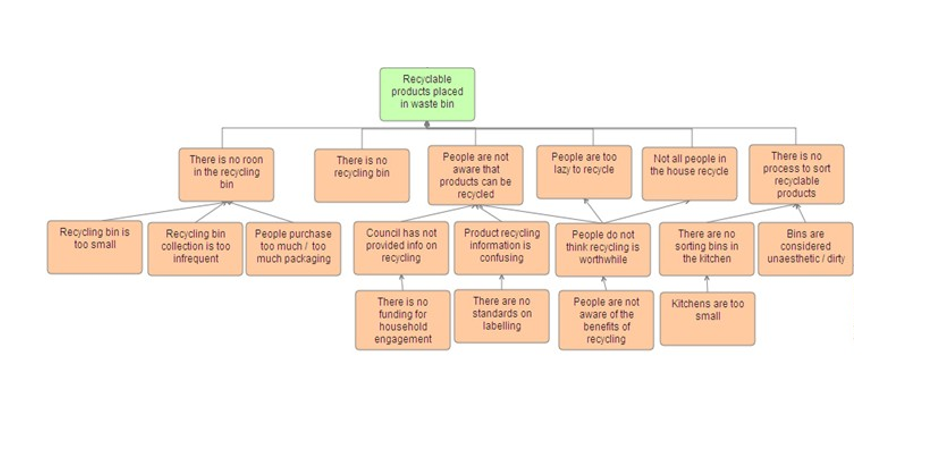
Example Solution Tree for a household recycling issue:
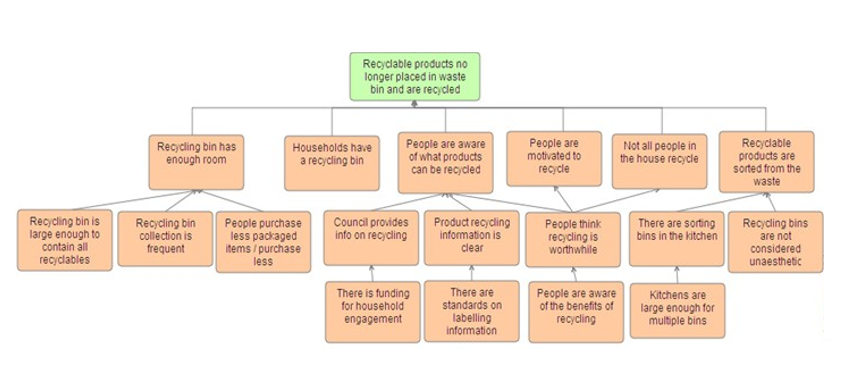
Hope this helps!
In practical sense, they are similar.
Imagine building a framework for Market Entry where you look at 4 things as part of a I ssue Tree:
- Market Attractiveness
- Competitive Landscape
Then you break each one down in more details. You have an issue tree now. You can also state a hypothesis for your interviewer saying: My hypothesis is that our client can enter the Japenese Car Manufacturing market, given that
- There is a real Market
- We can win in this market
- The economics are favourable
- And the risks are acceptable
Then you basically test each of these 4 hypotheses by asking the interviewer questions around each bucket ot test it. Does this help? Best, Aws
We might count to the COGS as well factors such as the German Packaging Act (https://www.lizenzero.de/en/blog/german-packaging-act-in-the-uk-obligations-when-shipping-to-germany/) or in general any costs that arise during shipment.
Related Cases

Bain Case Style - Growth offensive at ChemCorp [NEW]
Kearney first round case - top chemicals, related case interview basics article(s).
The Issue Tree Framework can be used to break down the problems of a case to its components and significantly increase your speed during case interviews.
Similar Questions
Last round ey / presentation case interview issue tree practise, hard/complex profitability structure - help, what's the best way to structure a revenue growth case.
- Select category
- General Feedback
- Case Interview Preparation
- Technical Problems

- What is Strategy?
- Business Models
- Developing a Strategy
- Strategic Planning
- Competitive Advantage
- Growth Strategy
- Market Strategy
- Customer Strategy
- Geographic Strategy
- Product Strategy
- Service Strategy
- Pricing Strategy
- Distribution Strategy
- Sales Strategy
- Marketing Strategy
- Digital Marketing Strategy
- Organizational Strategy
- HR Strategy – Organizational Design
- HR Strategy – Employee Journey & Culture
- Process Strategy
- Procurement Strategy
- Cost and Capital Strategy
- Business Value
- Market Analysis
- Problem Solving Skills
- Strategic Options
- Business Analytics
- Strategic Decision Making
- Process Improvement
- Project Planning
- Team Leadership
- Personal Development
- Leadership Maturity Model
- Leadership Team Strategy
- The Leadership Team
- Leadership Mindset
- Communication & Collaboration
- Problem Solving
- Decision Making
- People Leadership
- Strategic Execution
- Executive Coaching
- Strategy Coaching
- Business Transformation
- Strategy Workshops
- Leadership Strategy Survey
- Leadership Training
- Who’s Joe?
Hypothesis Tree Template
Managing Editor September 13, 2018
A hypothesis tree takes a problem statement and comprehensively disaggregates potential solutions. A hypothesis tree is a great tool to use any time you are trying to better understand a problem and/or opportunities.
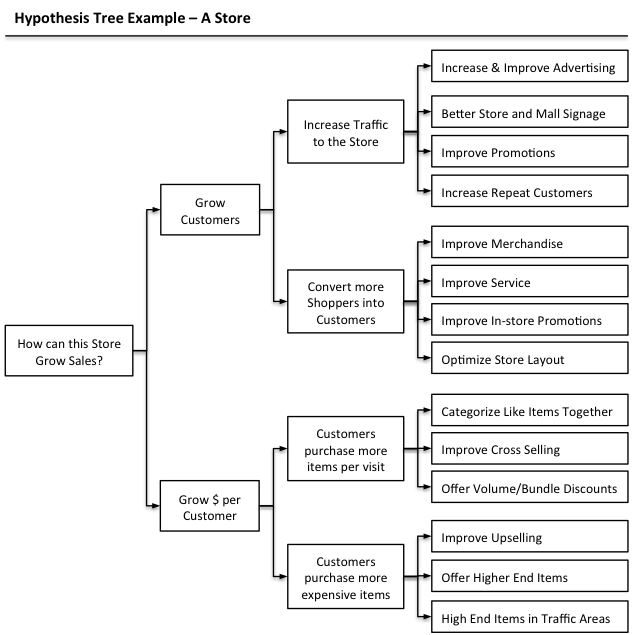
Most projects at strategy consulting firms start with the team spending a few hours brainstorming and aligning on the hypothesis tree for the defined problem statement. The hypothesis tree helps a team scope out the scale of the problem and potential solutions, build context, prioritize some of the analysis and facts needed, and communicate the problem solving structure and path.
To get you going on creating hypothesis trees , download the free and editable Hypothesis Tree PowerPoint Worksheet.
Take a large and important problem your team or company is trying to solve.
Create a problem statement. You can utilize the problem statement module to do this.
Once you have a clear problem statement, disaggregate potential solutions into 2-5 major hypotheses . Make sure they are MECE and at the same level of specificity. Next, tree out sub-hypotheses or ideas that would drive the major hypotheses. Next, list out the analyses or fact base you need to prove or disprove the hypotheses or determine the magnitude of the ideas.
CLICK HERE FOR MORE ON HYPOTHESIS TREES
Download strategy presentation templates.
168-PAGE COMPENDIUM OF STRATEGY FRAMEWORKS & TEMPLATES 186-PAGE HR & ORG STRATEGY PRESENTATION 100-PAGE SALES PLAN PRESENTATION 121-PAGE STRATEGIC PLAN & COMPANY OVERVIEW PRESENTATION 114-PAGE MARKET & COMPETITIVE ANALYSIS PRESENTATION 18-PAGE BUSINESS MODEL TEMPLATE
JOE NEWSUM COACHING
EXECUTIVE COACHING STRATEGY COACHING ELEVATE360 BUSINESS TRANSFORMATION STRATEGY WORKSHOPS LEADERSHIP STRATEGY SURVEY & WORKSHOP STRATEGY & LEADERSHIP TRAINING
THE LEADERSHIP MATURITY MODEL
Explore other types of strategy.
BIG PICTURE WHAT IS STRATEGY? BUSINESS MODEL COMP. ADVANTAGE GROWTH
TARGETS MARKET CUSTOMER GEOGRAPHIC
VALUE PROPOSITION PRODUCT SERVICE PRICING
GO TO MARKET DISTRIBUTION SALES MARKETING
ORGANIZATIONAL ORG DESIGN HR & CULTURE PROCESS PARTNER
EXPLORE THE TOP 100 STRATEGIC LEADERSHIP COMPETENCIES
TYPES OF VALUE MARKET ANALYSIS PROBLEM SOLVING
OPTION CREATION ANALYTICS DECISION MAKING PROCESS TOOLS
PLANNING & PROJECTS PEOPLE LEADERSHIP PERSONAL DEVELOPMENT

- school Campus Bookshelves
- menu_book Bookshelves
- perm_media Learning Objects
- login Login
- how_to_reg Request Instructor Account
- hub Instructor Commons
- Download Page (PDF)
- Download Full Book (PDF)
- Periodic Table
- Physics Constants
- Scientific Calculator
- Reference & Cite
- Tools expand_more
- Readability
selected template will load here
This action is not available.

8.1.1: Null and Alternative Hypotheses
- Last updated
- Save as PDF
- Page ID 10971

The actual test begins by considering two hypotheses . They are called the null hypothesis and the alternative hypothesis . These hypotheses contain opposing viewpoints.
\(H_0\): The null hypothesis: It is a statement of no difference between the variables—they are not related. This can often be considered the status quo and as a result if you cannot accept the null it requires some action.
\(H_a\): The alternative hypothesis: It is a claim about the population that is contradictory to \(H_0\) and what we conclude when we reject \(H_0\). This is usually what the researcher is trying to prove.
Since the null and alternative hypotheses are contradictory, you must examine evidence to decide if you have enough evidence to reject the null hypothesis or not. The evidence is in the form of sample data.
After you have determined which hypothesis the sample supports, you make a decision. There are two options for a decision. They are "reject \(H_0\)" if the sample information favors the alternative hypothesis or "do not reject \(H_0\)" or "decline to reject \(H_0\)" if the sample information is insufficient to reject the null hypothesis.
\(H_{0}\) always has a symbol with an equal in it. \(H_{a}\) never has a symbol with an equal in it. The choice of symbol depends on the wording of the hypothesis test. However, be aware that many researchers (including one of the co-authors in research work) use = in the null hypothesis, even with > or < as the symbol in the alternative hypothesis. This practice is acceptable because we only make the decision to reject or not reject the null hypothesis.
Example \(\PageIndex{1}\)
- \(H_{0}\): No more than 30% of the registered voters in Santa Clara County voted in the primary election. \(p \leq 30\)
- \(H_{a}\): More than 30% of the registered voters in Santa Clara County voted in the primary election. \(p > 30\)
Exercise \(\PageIndex{1}\)
A medical trial is conducted to test whether or not a new medicine reduces cholesterol by 25%. State the null and alternative hypotheses.
- \(H_{0}\): The drug reduces cholesterol by 25%. \(p = 0.25\)
- \(H_{a}\): The drug does not reduce cholesterol by 25%. \(p \neq 0.25\)
Example \(\PageIndex{2}\)
We want to test whether the mean GPA of students in American colleges is different from 2.0 (out of 4.0). The null and alternative hypotheses are:
- \(H_{0}: \mu = 2.0\)
- \(H_{a}: \mu \neq 2.0\)
Exercise \(\PageIndex{2}\)
We want to test whether the mean height of eighth graders is 66 inches. State the null and alternative hypotheses. Fill in the correct symbol \((=, \neq, \geq, <, \leq, >)\) for the null and alternative hypotheses.
- \(H_{0}: \mu \_ 66\)
- \(H_{a}: \mu \_ 66\)
- \(H_{0}: \mu = 66\)
- \(H_{a}: \mu \neq 66\)
Example \(\PageIndex{3}\)
We want to test if college students take less than five years to graduate from college, on the average. The null and alternative hypotheses are:
- \(H_{0}: \mu \geq 5\)
- \(H_{a}: \mu < 5\)
Exercise \(\PageIndex{3}\)
We want to test if it takes fewer than 45 minutes to teach a lesson plan. State the null and alternative hypotheses. Fill in the correct symbol ( =, ≠, ≥, <, ≤, >) for the null and alternative hypotheses.
- \(H_{0}: \mu \_ 45\)
- \(H_{a}: \mu \_ 45\)
- \(H_{0}: \mu \geq 45\)
- \(H_{a}: \mu < 45\)
Example \(\PageIndex{4}\)
In an issue of U. S. News and World Report , an article on school standards stated that about half of all students in France, Germany, and Israel take advanced placement exams and a third pass. The same article stated that 6.6% of U.S. students take advanced placement exams and 4.4% pass. Test if the percentage of U.S. students who take advanced placement exams is more than 6.6%. State the null and alternative hypotheses.
- \(H_{0}: p \leq 0.066\)
- \(H_{a}: p > 0.066\)
Exercise \(\PageIndex{4}\)
On a state driver’s test, about 40% pass the test on the first try. We want to test if more than 40% pass on the first try. Fill in the correct symbol (\(=, \neq, \geq, <, \leq, >\)) for the null and alternative hypotheses.
- \(H_{0}: p \_ 0.40\)
- \(H_{a}: p \_ 0.40\)
- \(H_{0}: p = 0.40\)
- \(H_{a}: p > 0.40\)
COLLABORATIVE EXERCISE
Bring to class a newspaper, some news magazines, and some Internet articles . In groups, find articles from which your group can write null and alternative hypotheses. Discuss your hypotheses with the rest of the class.
In a hypothesis test , sample data is evaluated in order to arrive at a decision about some type of claim. If certain conditions about the sample are satisfied, then the claim can be evaluated for a population. In a hypothesis test, we:
- Evaluate the null hypothesis , typically denoted with \(H_{0}\). The null is not rejected unless the hypothesis test shows otherwise. The null statement must always contain some form of equality \((=, \leq \text{or} \geq)\)
- Always write the alternative hypothesis , typically denoted with \(H_{a}\) or \(H_{1}\), using less than, greater than, or not equals symbols, i.e., \((\neq, >, \text{or} <)\).
- If we reject the null hypothesis, then we can assume there is enough evidence to support the alternative hypothesis.
- Never state that a claim is proven true or false. Keep in mind the underlying fact that hypothesis testing is based on probability laws; therefore, we can talk only in terms of non-absolute certainties.
Formula Review
\(H_{0}\) and \(H_{a}\) are contradictory.
- If \(\alpha \leq p\)-value, then do not reject \(H_{0}\).
- If\(\alpha > p\)-value, then reject \(H_{0}\).
\(\alpha\) is preconceived. Its value is set before the hypothesis test starts. The \(p\)-value is calculated from the data.References
Data from the National Institute of Mental Health. Available online at http://www.nimh.nih.gov/publicat/depression.cfm .
Thank you for visiting nature.com. You are using a browser version with limited support for CSS. To obtain the best experience, we recommend you use a more up to date browser (or turn off compatibility mode in Internet Explorer). In the meantime, to ensure continued support, we are displaying the site without styles and JavaScript.
- View all journals
- Explore content
- About the journal
- Publish with us
- Sign up for alerts
- NEWS FEATURE
- 26 March 2024
The ‘Mother Tree’ idea is everywhere — but how much of it is real?
- Aisling Irwin 0
Aisling Irwin is a freelance journalist based in Oxfordshire, UK.
You can also search for this author in PubMed Google Scholar
Forests in Canada were the backdrop for early experiments on whether trees can communicate through an underground fungal network. Credit: Andrew Lichtenstein/Corbis via Getty
You have full access to this article via your institution.
It was a call from a reporter that first made ecologist Jason Hoeksema think things had gone too far. The journalist was asking questions about the wood wide web — the idea that trees communicate with each other through an underground fungal network — that seemed to go well beyond what Hoeksema considered to be the facts.
Hoeksema discovered that his colleague, Melanie Jones, was becoming restive as well: her peers, she says, “had been squirming for a while and feeling uncomfortable with how the message had morphed in the public literature”. Then, a third academic, mycorrhizal ecologist Justine Karst, took the lead. She thought speaking out about the lack of evidence for the wood wide web had become an ethical obligation: “Our job as scientists is to present the truth, as close as we can get to it”.
Their concerns lay predominantly with a depiction of the forest put forward by Suzanne Simard, a forest ecologist at the University of British Columbia in Vancouver, in her popular work. Her book Finding the Mother Tree , for example, was published in 2021 and swiftly became a bestseller. In it she drew on decades of her own and others’ research to portray forests as cooperating communities. She said that trees help each other out by dispatching resources and warning signals through fungal networks in the soil — and that more mature individuals, which she calls mother trees, sometimes prioritize related trees over others.
The idea has enchanted the public, appearing in bestselling books, films and television series. It has inspired environmental campaigners, ecology students and researchers in fields including philosophy, urban planning and electronic music. Simard’s ideas have also led to recommendations on forest management in North America.

It takes a wood to raise a tree: a memoir
But in the ecology community there is a groundswell of unease with the way in which the ideas are being presented in popular forums. Last year, Karst, at the University of Alberta in Edmonton, Canada; Hoeksema, at the University of Mississippi in Oxford; and Jones, at the University of British Columbia in Kelowna, Canada, challenged Simard’s ideas in a review 1 , digesting the evidence and suggesting that some of Simard’s descriptions of the wood wide web in popular communications had “overlooked uncertainty” and were “disconnected from evidence”. They were later joined by other researchers, including around 30 forest and fungal scientists, who published a separate paper that questioned the scientific credibility 2 of two popular books about forests — one of them Simard’s — saying that some of the claims in her book “do not correctly reflect, and even contradict, the data”. The article warns of “the perils of plant personification”, saying that the desire to humanize plant life “may eventually harm rather than help the commendable cause of preserving forests”. Another review of the evidence appeared in May last year 3 .
Simard, however, disagrees with these characterizations of her work and is steadfast about the scientific support for her idea that trees cooperate through underground fungal networks. “They’re reductionist scientists,” she says when asked about criticism of her work. “They’ve missed the forest for the trees.” She is concerned that the debate over the details of the theory diminishes her larger goal of forest protection and renewal. “The criticisms are a distraction, to be honest, from what’s happening in our ecosystems.”
Robert Kosak, dean of the faculty of forestry at the University of British Columbia, supports Simard and calls her “a world-renowned scientist, a strong advocate for science-based environmental solutions, an amazing communicator, mentor, and teacher, and a wonderful colleague”.
The dispute offers a window into how scientific ideas take shape and spread in popular culture — and raises questions about what the responsibilities of scientists are as they communicate their ideas more widely.
Conversation starter
In her book, Simard tells of an idyllic childhood, with summers spent in the ancient forests of British Columbia. While an undergraduate, she worked at a forestry company, witnessing clear-cut logging at first hand. The experience set the course of her career. On graduating, she took a government forest-service post, and joined the University of British Columbia in 2002. She still works there, running a research programme called the Mother Tree Project, which develops sustainable forest-renewal practices.
One of Simard’s earliest papers appeared in Nature 4 in 1997, describing evidence that carbon could travel underground between trees of different species, and suggesting that this could be through an underground fungal network. Nature put the paper on its cover and dubbed the idea the wood wide web — a term that quickly caught on and is now widely used to describe the idea ( Nature ’s news team is editorially independent of its journal team).
Tree leaves turn sunshine and carbon dioxide into sugars, and some of this flows to their roots and into mycorrhizal fungi , which grow into the root tip and donate water and nutrients in return. There was already evidence, from a laboratory study 5 , that carbon can move through the tendrils of the fungi that link seedling roots together. But Simard’s approach, a controlled experiment in clear-cut forest, was “groundbreaking”, says David Johnson, who studies the ecology of soil microbes at the University of Manchester, UK.

Forest ecologist Suzanne Simard’s 1997 study looked at carbon transfer between Douglas fir ( Pseudotsuga menziesii ) and paper birch trees ( Betula papyrifera , pictured). Credit: Steve Gettle/Nature Picture Library
She planted pairs of seedlings — one paper birch ( Betula papyrifera ) and one Douglas fir ( Pseudotsuga menziesii ) — close to one another. She shaded the Douglas fir to prevent it from manufacturing sugars. Then she bathed the air surrounding each seedling with traceable, labelled carbon dioxide. She found carbon in sugars made by the birch in the needles of the shaded Douglas fir. Smaller quantities of sugars from the fir were found in the birch.
A third seedling in each group — western red cedar ( Thuja plicata ) — which is not colonized by the same types of mycorrhizal fungi, absorbed less carbon than did the other seedlings. The results, the authors concluded 4 , suggest that carbon transfer between birch and Douglas fir “is primarily through the direct hyphal pathway”. That is, there could be an active fungal pipeline connecting the roots of both trees.
Over the years, Simard and other researchers developed in published work the idea that there could be a common mycorrhizal network in the forest soil, connecting many trees of the same and different species.
About a decade ago, Simard began to take the idea further, and into the media. In a short film called Mother Trees Connect the Forest , she said of forest trees: “These plants are really not individuals in the sense that Darwin thought they were individuals competing for survival of the fittest. In fact, they’re interacting with each other, trying to help each other survive.”
In 2016, in a TED talk that has had more than 5.6 million views , she portrayed forest trees as “not just competitors” — competition being foundational to the understanding of how ecosystems work — “but as cooperators”. Her 1997 experiment, she said, had revealed evidence for a “massive underground communications network”. Her later work, she added in the TED talk, found that some bigger, older “mother trees”, as she called them, are particularly well connected. They nurture their young — preferentially sending them carbon and making space for them in their root systems. What’s more, “when mother trees are injured or dying, they also send messages of wisdom on to the next generation of seedlings.”
Then came her book — a memoir and detailed account of her work. It has been praised for its vivid and personal depiction of the scientific life.
The book concludes that to escape environmental devastation, humans should adopt attitudes to nature that are similar to those of Indigenous people. “This begins by recognizing that trees and plants have agency,” she writes.
Simard has worked to change forestry practices in North America in line with her ideas, for example by sparing the oldest trees during clear-cutting so that they can provide an infrastructure for the next generation of planted trees.
Challenging ideas
But academics were increasingly concerned that the ideas and the publicity that they were attracting had moved beyond what was warranted by the scientific evidence.
The disquiet came to a head when the 2023 scientific review 1 was published. The authors, Hoeksema, Jones and Karst, have all collaborated scientifically with Simard in the past; Jones was an author of the 1997 paper. The review considers the evidence for popular claims made about the wood wide web.
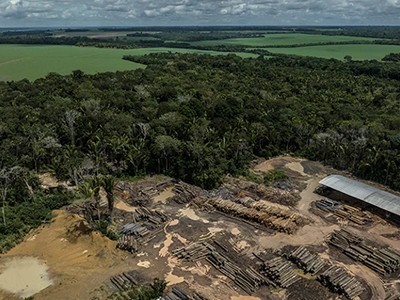
‘We are killing this ecosystem’: the scientists tracking the Amazon’s fading health
Their review has drawn praise for its scholarship. It is “the gold standard of how one should tackle a contentious and important field”, says James Cahill, who studies plant behaviour at the University of Alberta.
Simard takes the opposite view: the paper, she says, fails to see the bigger picture, and its prominence is “an injustice to the whole world”.
The review laid out what the authors regard as the three key claims underlying the popular idea of the ‘mother tree’: that networks of different fungi linking the roots of different trees — known as common mycorrhizal networks (CMNs) — are widespread in forests; that resources pass through such networks, benefiting seedlings; and that mature trees preferentially send resources along the networks to their kin. The scientists concluded that the first two are insufficiently supported by the scientific evidence, and that the last “has no peer-reviewed, published evidence”.
Some elements of the wood-wide-web idea are not in dispute, they say. For instance, mycorrhizal fungi can latch onto multiple roots of the same plant; one species of fungus can connect with the roots of different species of plant; and mycelia — a cobweb of fungal tendrils — can spread over large distances.
But evidence for a CMN in trees — one in which an individual fungus links the roots of the same or different tree species — is patchy, the review authors say. There are well-documented CMNs that link certain plants together: some orchids use CMNs to connect with trees, for instance, so that the orchids can feed on tree sugars when they can’t make their own.
And lab studies have shown that a single fungus can link seedlings of different tree species. But, the authors say, the lab studies compare with the forest in the same way that human cells grown in a dish compare with human bodies.
The review authors found that the strongest evidence for a CMN among trees in the field comes from five studies published between 2006 and 2020 — some led by ecologist Kevin Beiler, when he was a PhD student in Simard’s group. Beiler, who is now at the University for Sustainable Development in Eberswalde, Germany, used DNA techniques to map the networks of genetically distinct fungi in patches of old-growth forest, and found that they linked many trees of different ages, all Douglas fir — and the larger the tree, the greater the extent of its connections.

Suzanne Simard is the scientist most closely associated with the idea of the ‘wood wide web’. Credit: PA Images/Alamy
But Karst says that this doesn’t prove that the fungus was simultaneously connecting different trees, because mycelia decay easily and the technique would have picked up strands that are defunct, as well as alive. And that arduous mapping exercise has been repeated for just two tree species — hardly grounds for generalization, she says.
So, do these common networks exist? “The consensus seems to be they are probably there but we do need more people to go out and map them at a fine scale to show that,” says Jones.
The second claim explored by the review is that resources travel through the CMN and benefit seedlings. It has three parts. The first — that resources do, by some means, travel through the soil between plants, commands some support, say the review authors. For example, they highlight research in a Swiss forest in which the canopies of certain trees had been bathed in labelled carbon dioxide. The experiment showed that carbon ended up in the roots of nearby trees.
But the authors say that proving the second two parts of the claim — that a CMN is the major conduit, and that seedlings typically benefit — is tricky. Lab and field studies often cannot rule out that resources moved through the soil for at least part of the way. The review highlighted three lab studies that directly observed carbon moving from one tree seedling to another through a mycorrhizal link, and these “are still the best evidence for the movement of resources within a CMN formed by woody plant species”, say the authors.
In the forest, the authors found 26 experiments reporting carbon transfer, but for each transfer, there was an alternative explanation for how the carbon travelled.
Some studies don’t look for a CMN but simply assess whether growing a seedling next to an adult tree improves its performance. For every instance in which a seedling benefited, the review states, there was another study in which its growth was inhibited. The results are “a huge smear from positive effects to negative effects and mostly neutral”, says Hoeksema.
The third claim is that mature trees communicate preferentially with offspring through CMNs, for example sending warning signals after an attack.
“When I heard that out in public I thought ‘Holy cow, that’s extraordinary’,” says Karst.
The team did find one lab experiment, published in 2017 and led by Brian Pickles, who did the work as a postdoc in Simard’s department, that found that if seedlings were related then more carbon was transferred between them. But it happened in only two of the four lineages of seedlings, and it happened even when fungi were prevented from making links with each other — suggesting that one fungus exuded it into the soil and the other picked it up, the researchers say. In the review, the authors write that, for the third claim, “there is no current evidence from peer-reviewed, published field studies”.
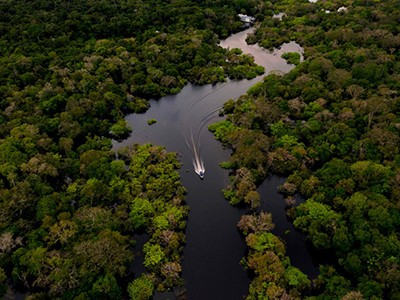
We must get a grip on forest science — before it’s too late
Karst says that one reason why ideas about mother trees and their kin have traction in the public domain is that Simard, in media interviews and her book, has implied that findings made in the greenhouse were actually made in the forest, making the evidence seem stronger than it is. Simard disagrees. “I do not, and would never, imply anything misleading when presenting research.”
Karst gives the example of a passage from Simard’s book that describes a visit to a field site made by Simard and her master’s student, Amanda Asay. In October 2012, Asay was exploring a question that is important for forestry — do seedlings stand a better chance of survival if they grow near their mother tree, and, if so, is this because they receive preferential help through a common mycorrhizal network? Asay had blocked such connections in control seedlings by planting them in mesh bags with pores too small for fungi to fit through. What she found in that forest experiment, Simard says in her book, matched the theory that trees help their kin through networks. “Seedlings that were [the mother tree’s] kin survived better and were noticeably bigger than those that were strangers linked into the network, a strong hint that Douglas-fir mother trees could recognize their own.” Yet, when the review authors accessed Asay’s master’s thesis 6 , they found that her field work had discovered the opposite: that more non-kin seedlings survived than did kin (although the trend was not significant). As for the role of networks, the thesis states: “Our hypothesis that kin recognition is facilitated by mycorrhizal networks, however, was not supported”.
When asked about the discrepancy, Simard says that Asay also did greenhouse experiments for her master’s thesis, which used pairs of older and younger tree seedlings, and showed that older seedlings recognized younger kin and sent them more resources than they did to non-kin. After that, Asay and others in the team did find evidence that “there are responses that clearly show kin selection in those trees”.
Simard says that, when describing Asay’s findings in the forest in 2012, she made a writer’s choice to situate other findings as if they were discovered in the forest on that day. “I situated the story in the field, because that’s where the question came from.” That description, she says, encompasses “the whole body of work”.

A spruce tree root with ectomycorrhizal fungi. Credit: Eye of Science/Science Photo Library
Asay’s subsequent work has not yet been published, for a tragic reason: she died in an accident in 2022. Her death was devastating for the group and publication stalled, Simard says. “We’re about to publish those papers,” she says.
Karst, Jones and Hoeksema’s overall conclusion is that CMNs do exist in the plant kingdom, and that resources can travel along them, benefiting at least one party, and sometimes both. In the forest, myriad mycelia extend through the soil that are capable of linking with trees, including those of different species. Whether they form a live thoroughfare, and whether resources travel through it between trees, has yet to be demonstrated in the field. Whether there are, in general, kin effects between plants was beyond the scope of their review, but the authors found nothing to support the idea that forest trees target kin through common mycorrhizal networks.
Their review also looked at the literature and found that some scientists have selectively cited and quoted from studies, boosting the credibility of the idea. The main problem, the review concludes, is not the quality of the science. “The most concerning issue is the rigour with which the results of these studies have been transmitted and interpreted.”
Rigour and reaction
Most of the response to the review has been positive, says Jones. “We got a lot of letters saying ‘thank you for doing that, it’s such a relief’. But I was really surprised how many of our colleagues said ‘you are brave’. That shouldn’t be, that you would have to be brave.”
But some researchers have taken issue with aspects of the review. Johnson disagrees with the team’s decision to exclude evidence for similar networks elsewhere in the plant kingdom, including between orchids and trees, and in grasslands and heathlands. It means, he says, they were “ignoring 90% of the work … our default position should be that we should expect mycorrhizal fungi to connect many plants”. It’s important, he says, to take a collective view of the evidence.
He agrees with the conclusion, however, that Simard’s idea of the cooperating forest is incompatible with evolutionary theory. “It’s all about the plants supporting each other for these altruistic reasons. I think that’s completely rubbish.”
Johnson’s view is that it “makes complete sense” that there are CMNs linking multiple forest trees and that substances might travel from one to another through them. Crucially, he says, this is not due to the trees supporting one another. A simple explanation, compatible with evolutionary theory, is that the fungi are acting to protect the trees that are their source of energy. It is beneficial for fungi to activate a tree’s defence signals, or to top up food for temporarily ailing trees. Pickles, who spent six years working with Simard before moving to the University of Reading, UK, says Simard’s ideas are not incompatible with competition, but give more weight to well-known phenomena in ecology, such as mutualism, in which organisms cooperate for mutual benefit. “It’s not altruism. It’s not some outrageous idea,” he says. “She certainly focuses more on facilitation and mutualism than is traditional in these fields, and that’s probably why there’s a lot of pushback.”
Other ecologists agree that there is some “polarization” in ecology between cooperative and competitive ideas. “The idea that perhaps not everything is trying to kill everything else is helpful,” says Katie Field, who studies plant-soil processes at the University of Sheffield, UK.
Regardless of the differences of opinion, Pickles says, “It’s good to have this rigorous analysis.”
Frustrating debate
Simard is exasperated by the debate.
Her work, she says, has “changed our whole world view of how the forest works”. There are now “dozens and dozens” of people “who have found that stuff moves through networks and through the soil”.
She says that the quality of her science has been unfairly challenged. To say that her 200 published papers are “not valid science, which I think is what they’re saying … that it was wrong … is not right,” she says. She is in the process of submitting responses to the critical papers to two journals, she says.
She says that she is unfairly accused of claiming CMNs are the only pathway for resources to travel between trees, and that she acknowledges other pathways in her papers and her book.
In media appearances, it’s hard to make that clear, she says: “It’s a very short period of time, and I don’t get into all those other evolutionary reasons for these things.”
Simard maintains that her critics attack her in the academic literature for imagery she has used only in public communication: “I talked about the mother tree as a way of communicating the science and then these other people say it’s a scientific hypothesis. They misuse my words.”
She argues that changing our understanding of how forests work from ‘winner takes all’ to ‘collaborative, integrated network system’ is essential for fixing the rampant destruction of old-growth forest, especially in British Columbia, where her research has focused. Indigenous cultures that have a more sustainable relationship with forests have mother and father trees, she says — “but the European male society hates the mother tree … somebody needs to write a paper on that”.
“I’m putting forward a paradigm shift. And the critics are saying ‘we don’t want a paradigm shift, we’re fine, just the way we are’. We’re not fine.”
Simard also says that Karst held a position partially funded by members of Canada’s Oil Sands Innovation Alliance that constitutes a conflict of interest. Extraction of oil deposits is associated with forest loss and environmental damage, and Karst was studying land reclamation after extraction. Karst says that she held this position until 2021, terminating it before starting work on the review, and that the work it funded did not overlap with the focus of the review on mycorrhizal networks.
Taking the research forwards will be challenging, says Johnson. Karst and her colleagues have produced an agenda for future field research — from mapping the genotypes of trees and fungi in a range of forests to using controls in experiments more stringently. But the agenda doesn’t impress Johnson. “It’s almost impossible to fulfil,” he says, partly because fieldwork is so fiendishly difficult.
Some scientists say that Simard’s popular work has had a positive influence on the field, even if elements of it remain controversial. Her work propelled the mycorrhizal research community from an obscure and underfunded field to one that excites the public, says Field. That has unleashed funding, stimulated researchers’ imaginations and influenced research agendas.
The backlash has further energized the community, she says. There are plans for a special edition of a journal she edits, and sessions have been added to the upcoming meeting of the International Mycorrhizal Society. All of this is helpful, says Field. “Anything that makes people think again and look again at the evidence is good.”
Nature 627 , 718-721 (2024)
doi: https://doi.org/10.1038/d41586-024-00893-0
Karst, J., Jones, M. D. & Hoeksema, J. D. Nature Ecol. Evol. 7 , 501–511 (2023).
Article PubMed Google Scholar
Robinson, D. G. et al. Trends Plant Sci. 29 , 20–31 (2024).
Henriksson, N. et al. New Phytol. 239 , 19–28 (2023).
Simard, S. W. et al. Nature 388 , 579–582 (1997).
Article Google Scholar
Francis, R. & Read, J. Nature 307 , 53–56 (1984).
Asay, A. K. Mycorrhizal facilitation of kin recognition in interior Douglas-fir ( Pseudotsuga menziesii var. glauca ) . MSc thesis, Univ. British Columbia (2013).
Download references
Reprints and permissions
Related Articles

- Plant sciences
- Microbiology

Fossils document evolutionary changes of jaw joint to mammalian middle ear
Article 03 APR 24

Jurassic shuotheriids show earliest dental diversification of mammaliaforms

Why hand-operated front brakes were set to be the future of motoring
News & Views 02 APR 24

The complex polyploid genome architecture of sugarcane
Article 27 MAR 24

Estella Bergere Leopold (1927–2024), passionate environmentalist who traced changing ecosystems
Obituary 26 MAR 24

Substrate-induced condensation activates plant TIR domain proteins
Article 13 MAR 24

Long COVID still has no cure — so these patients are turning to research
News Feature 02 APR 24

Gut bacteria break down cholesterol — hinting at probiotic treatments
News 02 APR 24

How synthetic biologists are building better biofactories
Technology Feature 01 APR 24
Faculty Positions, Aging and Neurodegeneration, Westlake Laboratory of Life Sciences and Biomedicine
Applicants with expertise in aging and neurodegeneration and related areas are particularly encouraged to apply.
Hangzhou, Zhejiang, China
Westlake Laboratory of Life Sciences and Biomedicine (WLLSB)
Faculty Positions in Chemical Biology, Westlake University
We are seeking outstanding scientists to lead vigorous independent research programs focusing on all aspects of chemical biology including...
School of Life Sciences, Westlake University
Faculty Positions in Neurobiology, Westlake University
We seek exceptional candidates to lead vigorous independent research programs working in any area of neurobiology.
Seeking Global Talents, the International School of Medicine, Zhejiang University
Welcome to apply for all levels of professors based at the International School of Medicine, Zhejiang University.
Yiwu, Zhejiang, China
International School of Medicine, Zhejiang University
Nanjing Forestry University is globally seeking Metasequoia Scholars and Metasequoia Talents
Located next to Purple Mountain and Xuanwu Lake, Nanjing Forestry University (NJFU) is a key provincial university jointly built by Jiangsu Province
Nanjing, Jiangsu, China
Nanjing Forestry University (NFU)
Sign up for the Nature Briefing newsletter — what matters in science, free to your inbox daily.
Quick links
- Explore articles by subject
- Guide to authors
- Editorial policies
McKinsey has offices in 130+ cities in 65+ countries

IMAGES
VIDEO
COMMENTS
McKinsey consultants follow three steps in this cycle: Form a hypothesis about the problem and determine the data needed to test the hypothesis. Gather and analyze the necessary data, comparing ...
Strategy consultants use the MECE framework (Issue Tree, Decision Tree, Hypothesis Tree) to segregate a client's problems into logical data categories that can be analyzed systematically and minutely by their staff involved with the project. The framework is notably used at McKinsey, where data from clients' businesses is organized on the ...
Issue trees are the blueprint of how McKinsey (and other) consultants think. They make your thinking process more rigorous and much, much more clear. ... Well, one way some people figured out is to build a MECE tree and just throw the word hypothesis around. If it were in a case investigating why profits have fallen, this would sound something ...
And, being hypothesis-driven was required to have any success at McKinsey. A hypothesis is an idea or theory, often based on limited data, which is typically the beginning of a thread of further investigation to prove, disprove or improve the hypothesis through facts and empirical data. The first step in being hypothesis-driven is to focus on ...
To get you going on creating a hypothesis tree, download the free and editable Hypothesis Tree PowerPoint Worksheet. Download. Take an important problem your team or company is trying to solve. Create a problem statement. You can utilize the problem statement module to do this. Once you have a clear problem statement, disaggregate potential ...
In this episode of the McKinsey Podcast, Simon London speaks with Charles Conn, CEO of venture-capital firm Oxford Sciences Innovation, and McKinsey senior partner Hugo Sarrazin about the complexities of different problem-solving strategies.. Podcast transcript. Simon London: Hello, and welcome to this episode of the McKinsey Podcast, with me, Simon London.
Hypothesis trees are famously taught in McKinsey Mind as a way to solve a problem in a single meeting. For McKinsey analysts, hypothesis problem-solving usually follows three simple steps: A hypothesis is formed about the problem and how to solve it. Data is gathered to prove (or disprove) the hypothesis by comparing results.
An issue tree is a tool we use to structure problem solving, and it breaks the problem down into mutually exclusive and collectively exhaustive components. Putting together an issue tree helped me realize which specific matters are at stake and identify areas where I need to do a bit more research. Third, practicing mindful communication has ...
McKinsey and Company is recognized for its rigorous approach to problem solving. They train their consultants on their seven-step process that anyone can learn. ... Quickly developing a powerful hypothesis tree enables us to develop solutions more rapidly that will have real impact. This can sometimes seem premature to clients, who might find ...
The McKinsey problem-solving process can be summarized in the 5 steps: define the problems, find the root cause, use "hypothesis-driven" process, analyze with "issue tree" and propose solutions. 1. Define the problem: Every consulting project revolves around a "problem". But the "problem" is NOT always the problem!
What is a hypothesis tree? A hypothesis tree starts with the problem you're trying to solve. From that central issue, a hypothesis tree visually connects various explanations (or hypotheses) to the issue in question. ... The McKinsey Mind, authors Ethan Rasiel and Paul N. Friga go as far as to claim that a hypothesis tree can solve a problem ...
The discussion, moderated by McKinsey's Allen Webb, represents a state-of-the-art tour for senior executives hoping to help their organizations, and themselves, become more effective by benefiting from the core insight of behavioral economics: systematic tendencies to deviate from rationality influence all of our decision making.
I like the definition that McKinsey Mind uses for issue trees: The issue tree, a species of logic tree in which each branch of the tree is an issue or question, bridges the gap between structure and hypothesis. Every issue generated by a framework will likely be reducible to sub issues, and these in turn may break down further.
Hypothesis Based Consulting vs. a Decision Tree Approach - Which approach Does MBB prefer?. Leading management consulting firms, whether it is BCG, McKinsey or Bain (collectively called MBB), like hypothesis-based consulting.This is also called the answer-first approach.The answer being the hypothesis.. However, BCG tends to also accept the decision tree-leading-to-hypotheses approach to ...
1. Understand the Problem. Before building a hypothesis tree, you need to understand the problem thoroughly. Gather all the information and data related to the problem. In a case interview, ask clarifying questions after the interviewer has delivered the case problem to help you build a better hypothesis. 2.
Hi! Issue trees are at the heart of the problem-solving approach. What you refer to in your question are two distict types: diagnostic trees (what you call issue tree --> "problem-based") and solution trees (what you call hypothesis tree --> "solution-based"). Generally speaking, an issue tree is a graphical breakdown of your key question.
To get you going on creating hypothesis trees, download the free and editable Hypothesis Tree PowerPoint Worksheet. Take a large and important problem your team or company is trying to solve. Create a problem statement. You can utilize the problem statement module to do this. Once you have a clear problem statement, disaggregate potential ...
Review. In a hypothesis test, sample data is evaluated in order to arrive at a decision about some type of claim.If certain conditions about the sample are satisfied, then the claim can be evaluated for a population. In a hypothesis test, we: Evaluate the null hypothesis, typically denoted with \(H_{0}\).The null is not rejected unless the hypothesis test shows otherwise.
About a decade ago, Simard began to take the idea further, and into the media. In a short film called Mother Trees Connect the Forest, she said of forest trees: "These plants are really not ...
McKinsey & Company (1974-81) Partner. The White House (1973-74) Drug-abuse adviser. ... My real bottom-line hypothesis is that nobody has a sweet clue what they're doing. Therefore you better be trying stuff at an insanely rapid pace. You want to be screwing around with nearly everything. Relentless experimentation was probably important ...
Proponents of the Ca 2+ -voltage hypothesis state that not only is Ca 2+ required, but membrane potential as such also plays a pivotal role in promoting depolarization-induced release (Parnas and ...
McKinsey acquired Hypothesis in 2021. Learn more about Hypothesis. Client Impact. Enabling a $500 million government-stimulus package. In six months, Hypothesis launched a $500 million state government stimulus package for businesses impacted by COVID-19. We designed, built, tested, and managed the end-to-end website journey and in-app ...
McKinsey has offices in 130+ cities in 65+ countries. Africa. Asia Pacific. Central and South America. Europe. Middle East. North America. Regardless of location, clients have access to our global network of experts via industry and functional practices that concentrate knowledge and expertise on issues that matter.